Peak Streamflow Trends in South Dakota and Their Relation to Changes in Climate, Water Years 1921–2020
Links
- Document: Report (17 MB pdf) , HTML , XML
- Larger Work: This publication is Chapter I of Peak streamflow trends and their relation to changes in climate in Illinois, Iowa, Michigan, Minnesota, Missouri, Montana, North Dakota, South Dakota, and Wisconsin
- Dataset: USGS National Water Information System database - USGS water data for the Nation
- Data Release: USGS data release - Peak streamflow data, climate data, and results from investigating hydroclimatic trends and climate change effects on peak streamflow in the Central United States, 1920–2020
- NGMDB Index Page: National Geologic Map Database Index Page (html)
- Download citation as: RIS | Dublin Core
Acknowledgments
This project was made possible by the Transportation Pooled Fund Program, study number TPF–5(460). The State Departments of Transportation of Illinois, Iowa, Michigan, Minnesota, Missouri, South Dakota, and Wisconsin; the Montana Department of Natural Resources and Conservation; and the North Dakota Department of Water Resources contributed funds to the study.
Several current and former U.S. Geological Survey colleagues contributed to the manuscript with their thorough reviews, including Jason Alexander, Toby Feaster, Anthony Gotvald, Roy Sando, Mackenzie Marti, and Tara Williams-Sether.
Abstract
Peak-flow (flood) frequency analysis is essential to water-resources management applications, including the design of critical infrastructure such as bridges and culverts, and floodplain mapping. Federal guidelines for performing peak-flow flood frequency analyses are presented in a U.S. Geological Survey Techniques and Methods Report known as Bulletin 17C. A basic assumption within Bulletin 17C, which documents the guidelines for determining annual peak streamflow frequency, is that, for basins without major hydrologic alterations (for example, regulation, diversion, and urbanization), statistical properties of the distribution of annual peak streamflows are stationary; that is, the mean, variance, and skew are constant through time. Nonstationarity is a statistical property of a peak-flow series such that the long-term (on the order of decades) distributional properties change one or more times either gradually or abruptly through time. Individual nonstationarities may be attributed to one source such as flow regulation, land-use change, or climate but are often the result of a combination of sources, making detection and attribution of nonstationarities challenging.
In response to a growing concern regarding nonstationarity in peak streamflows in the region, the U.S. Geological Survey, in cooperation with the Departments of Transportation of Illinois, Iowa, Michigan, Minnesota, Missouri, South Dakota, and Wisconsin; the Montana Department of Natural Resources and Conservation; and the North Dakota Department of Water Resources, assessed the potential nonstationarity in peak streamflows in the north-central United States. This chapter characterizes the effects of natural hydroclimatic shifts and potential climate change on annual peak streamflows in the State of South Dakota. Annual peak and daily streamflow as well as model-simulated gridded climatic data were examined for temporal monotonic trends, change points, and other statistical properties indicative of changing climatic and environmental conditions.
Changes in annual peak and daily flows were evaluated among 13, 35, and 81 qualifying U.S. Geological Survey streamgages for the 75-, 50-, and 30-year trend periods through water year 2020 (the period from October 1, 2019, to September 30, 2020) in South Dakota, respectively. No qualifying streamgages were in the 100-year trend period in the State. Statistical tests for autocorrelation (independent and identically distributed assumption), monotonic trends, and change points in the median and scale are analyzed to evaluate potential stationarity violations (nonstationarity) for performing at-site peak-flow flood-frequency analysis. The trends are reported using a likelihood approach as an alternative to simply reporting significant trends with an arbitrary p-value cutoff point.
A distinct east-west spatial pattern of likely upward and downward monotonic trends and change points, respectively, was detected in 75- and 50-year trend periods, but an inconsistent spatial pattern was detected in the 30-year trend period. Additionally, change points in the median annual peak streamflows were detected in the late 1970s and early 1980s in the western part of the State, but in the east, the change point was more commonly detected in 1992–93. A similar east-west spatial pattern of likely upward and downward trends was detected in the annual peak-flow timing, the day of the year of the annal peak streamflow. In the western part of the State, the annual peak streamflows are arriving earlier, but in the east, the annual peak streamflows are arriving later. A peaks-over-threshold (POT) analysis where, on average, there are two events per year (POT2) and four events per year (POT4) was also used to evaluate changes in the frequency (count) of daily streamflows exceeding the threshold. Similar to detected changes in the annual peak streamflow, an east-west likely upward or downward change corresponding to an increase or decrease, respectively, in the frequency of daily streamflow greater than a POT2 and POT4 threshold was detected.
A monthly water-balance model was used to evaluate hydroclimatic variation in annual and seasonal precipitation, snowfall, potential evapotranspiration, and soil moisture storage for all qualifying streamgages in the 75-, 50-, and 30-year trend periods. Detected trends in the annual hydroclimatic metrics for the 75- and 50-year trend periods indicate a spatially consistent statewide increase in precipitation, decrease in snowfall, increase in potential evapotranspiration, and increase in soil moisture storage. Furthermore, detected trends in seasonal precipitation in the 75- and 50-year trend periods highlight a pronounced change in precipitation in winter and later into the summer season, especially in the 50-year trend period in the eastern part of the State. Statewide increases in seasonal soil moisture storage were also detected, highlighting year-round increasing flood magnitudes, particularly in the eastern part of the State.
Based on the results of these stationarity tests for the qualifying streamgages in South Dakota among the 75-, 50-, and 30-year trend periods, consistent temporal and spatial patterns of nonstationarity were detected among the 75- and 50-year trend periods. Furthermore, when nonstationarity is detected in daily streamflow, increased streamflow and volume (increasing frequency in POT), as well as potentially bridge scour, may have implications on culvert and highway design in the eastern part of South Dakota. Thus, when performing at-site peak-flow flood-frequency analyses in South Dakota, potential nonstationarities and alternative approaches are important considerations.
Introduction
Peak-flow flood-frequency analysis (FFA) is essential to water-resources management applications including critical structure design (for example, bridges and culverts) and floodplain mapping. Standardized Federal guidelines for doing FFA are presented in the U.S. Geological Survey (USGS) Techniques and Methods Report known as Bulletin 17C (chap. 5 of sec. B, “Surface Water,” book 4, “Hydrologic Analysis and Interpretation”) (England and others, 2018). A basic assumption within Bulletin 17C is that statistical properties of the distribution of peak streamflows are stationary for drainage basins without major hydrologic alterations (for example, regulation, diversion, and urbanization); that is, the mean, variance, and skew are constant (or stationary). From the onset of the USGS streamgaging program through most of the 20th century, the stationarity assumption was widely accepted within the flood-frequency community; however, a better understanding of climatic persistence (extended periods of relatively wet or relatively dry conditions) and concerns about potential climate change and land-use change have caused a reexamination of the stationarity assumption (Milly and others, 2008; Lins and Cohn, 2011; Stedinger and Griffis, 2011; Koutsoyiannis and Montanari, 2015; Serinaldi and Kilsby, 2015).
Nonstationarity is a statistical property of a peak-flow series such that the long-term (on the order of decades) distributional properties (the mean, variance, or skew) change one or more times either gradually or abruptly. Individual nonstationarities may be attributed to one source (for example, flow regulation, land-use change, or climate) but often are the result of a mixture of the sources (Vogel and others, 2011), which makes detection and attribution of nonstationarities challenging (Barth and others, 2022). Nonstationarity in peak streamflows can manifest as a monotonic trend in peak streamflows through time (Hodgkins and others, 2019) or as an abrupt change in the central tendency (mean or median), variability, or skew of peak streamflows (Ryberg and others, 2020a). Neglecting trends and abrupt changes in peak-flow FFA may result in a poor representation of the true flood risk. Bulletin 17C does not offer guidance on how to incorporate nonstationarities when estimating flood magnitudes and further identifies a need for additional flood-frequency studies that incorporate changing climate or basin characteristics into the analysis (England and others, 2018).
In response to a history of concern regarding nonstationarity in peak streamflows in the region, a study was done by the USGS, in cooperation with the Departments of Transportation of Illinois, Iowa, Michigan, Minnesota, Missouri, South Dakota, and Wisconsin; the Montana Department of Natural Resources and Conservation; and the North Dakota Department of Water Resources, to assess potential nonstationarity in peak streamflows in the north-central United States. The study area considered consists of nine States that form a diverse region with complex variability in topography and climate (Ryberg and others, 2024; fig. 1). The range in elevation, longitude, and latitude results in a variety of climate conditions that affect the magnitude and timing of peak streamflows (Ryberg and others, 2024).

Map showing topography and hydrography of the study area in the north-central United States (modified from Ryberg and others [2024]).
Hydroclimatology was defined as the “study of the influence of climate upon the waters of the land” (Langbein, 1967, as cited in Wendland [1987]). Precipitation, evapotranspiration, and imbalances between them are the hydroclimate. Along with physical characteristics such as soils and topography, the hydroclimate underlies floods and droughts (Shelton, 2008). The hydroclimatology in the study area is complex, and primary climatic drivers are highly variable among different peak-flow regimes. In some areas, peak-flow regimes are clearly dominated by snowmelt with relatively minor representation of rainfall events outside of the snowmelt period (Ryberg and others, 2016). Conversely, in other areas, peak-flow regimes are strongly affected by rainfall during or outside the snowmelt period (Ryberg and others, 2016). Well documented temporal changes in peak-flow distributions in the study area potentially violate the assumption of stationarity (Pederson and others, 2011; Hirsch and Ryberg, 2012; Mallakpour and Villarini, 2015; Archfield and others, 2016; Ryberg and others, 2016, 2020a; Villarini, 2016; Dudley and others, 2017). Additionally, distinct contrasts in hydroclimatic patterns (that is, areas with large downward rainfall trends and areas with large upward trends) within the region (Sando and others, 2022), combined with rural and urban land-use changes (Juckem and others, 2008; Schilling and others, 2008; Hejazi and Markus, 2009; Schilling and others, 2010; Yang and others, 2013; Villarini and Strong, 2014; Over and others, 2016; Ahiablame and others, 2017; Falcone and others, 2018), make the multistate region an ideal area for investigating potential methods for addressing nonstationarity in annual peak streamflows.
The Pacific, Atlantic (including the Gulf of Mexico), and Arctic Oceans (not shown) are the primary sources of atmospheric moisture to the study area (Bryson and Hare, 1974; Wendland and Bryson, 1981; Hirschboeck, 1991). The source and magnitude of water from precipitation differ spatially and temporally with the seasons because of changes in the prevailing winds (Hirschboeck, 1991). In the fall and winter, dominant moisture sources also include air masses over the north-central and eastern United States (Hirschboeck, 1991). The source, magnitude, and shifts in atmospheric moisture, in turn, affect the timing, magnitude, seasonality, and duration of peak streamflows (Archfield and others, 2016; Dickinson and others, 2019).
Previous studies have identified hydroclimatic changes that affect streamflow in the study area (Ryberg and others, 2014; Mallakpour and Villarini, 2015; Griffin and Friedman, 2017; Ivancic and Shaw, 2017; Levin and Holtschlag, 2022; Sando and others, 2022) including gradual changes in streamflow, precipitation, or temperature and more abrupt hydroclimatic shifts. These regional hydroclimatic changes (mainly increases or decreases in precipitation) have been identified as primary drivers of some peak-flow nonstationarities in the study area (Levin and Holtschlag, 2022; Sando and others, 2022). Previous trend studies have generally documented an abrupt change along a northwest-southeast transect with downward peak-flow trends in the western part of the study area, including Montana and the western parts of North and South Dakota, and upward trends in eastern North and South Dakota, Minnesota, Iowa, Illinois, and Missouri (Hirsch and Ryberg, 2012; Peterson and others, 2013; Georgakakos and others, 2014; Norton and others, 2014; Ryberg and others, 2016, 2020a; Hodgkins and others, 2017; Norton and others, 2022). The broad regional extent, abrupt transition, and large magnitudes of trends in the study area support the hypothesis that the trends may be caused by long-term (on the order of decades) persistence and regional hydroclimatic shifts (Vecchia, 2008; Ryberg and others, 2014; Razavi and others, 2015; Kolars and others, 2016). Long-term persistence refers to clustered wet and dry periods that induce serial correlation into the peak-flow series at lags of more than 1 year. This long-term persistence also is referred to as “memory,” “long-range dependence,” or “the Hurst phenomenon” (Koutsoyiannis and Montanari, 2007; Ryberg and others, 2020b).
Other documented changes in streamflow characteristics within the study area during the last 30 years indicate spatial and temporal differences in the timing, magnitude, and frequency of streamflows. Olsen and others (1999) examined the relation between climatic indices and the distribution of flood flows in the upper Mississippi River and lower Missouri River (not shown). They state that global climate patterns were not primary drivers of variation in flood peaks in the 1950–96 data period. McCabe and Wolock (2002) documented change points in minimum and median daily streamflow at selected U.S. streamgages; significant increases began in 1971 at sites primarily east of 100 degrees west longitude. There is a tendency toward decreased snowpacks and earlier snowmelt runoff in mountainous areas of Montana (Pederson and others, 2011) and a general tendency toward earlier snowmelt-dominated flood peaks for much of the northern part of the study area (Ryberg and others, 2016). Other studies have indicated a more gradual tendency toward decreases in annual streamflow in Montana and Wyoming (Norton and others, 2014) and increases in monthly, seasonal, and annual streamflow in eastern North and South Dakota along with parts of Iowa and Missouri within the Missouri River Basin (Norton and others, 2014; Hoogestraat and Stamm, 2015). Mallakpour and Villarini (2015) analyzed changes in flood characteristics in the central United States (14 States: North Dakota, South Dakota, Nebraska, Kansas, Missouri, Iowa, Minnesota, Wisconsin, Illinois, West Virginia, Kentucky, Ohio, Indiana, and Michigan) during 1962–2011. They reported an increase in the frequency rather than magnitude of flooding and related these changes to changes in seasonal rainfall and temperature. More specifically, the frequency of flooding increased for much of the study area except for northern Minnesota, Wisconsin, and Michigan; Virginia and West Virginia; and western parts of Nebraska and Kansas (Mallakpour and Villarini, 2015). Analysis of temporal changes in streamflows for the 1912–2011 period (Wise and others, 2018) indicated decreases in snowpack and streamflows in the Upper Missouri River Basin including areas in Montana, North Dakota, and South Dakota, whereas streamflows in the Lower Missouri River Basin States, including Iowa and Missouri, increased during the same period.
Trends in peak streamflows resulting from factors other than hydroclimatology (such as land-use change or changes in agricultural practices) are also possible and may exist simultaneously with hydroclimatic changes, complicating the task of attributing these trends just to hydroclimatic changes. This study is limited in scope to hydroclimate. Those interested in other factors can consult Sando and others (2022) and Levin and Holtschlag (2022).
This chapter summarizes how hydroclimatic variability affects the temporal and spatial distributions of peak-flow data in the State of South Dakota. A wide range of analyses and statistical approaches are applied to document the primary mechanisms controlling floods and characterize temporal changes in hydroclimatic variables and peak streamflow. These analyses will provide the foundation that can be used for future studies in the region to address nonstationarities in observed peak streamflows.
Purpose and Scope
The purpose of this chapter is to document the methods used for the second task of the Transportation Pooled Fund (TPF) study TPF 5(460) (Transportation Pooled Fund, 2024), which is to characterize the effects of natural hydroclimatic shifts and potential climate change on peak streamflows in the State of South Dakota. Three trend periods ending in water year 2020 are analyzed for 82 total streamgages in South Dakota (table 1). A water year is the 12-month period from October 1 to September 30 and is designated by the year in which it ends. The scope of the TPF study is to evaluate the combined effects of multidecadal climatic persistence, gradual and abrupt climate change, and limited aspects of land-use change on flood-frequency analyses in the States of Illinois, Iowa, Michigan, Minnesota, Missouri, Montana, North Dakota, South Dakota, and Wisconsin. In this evaluation, peak streamflow, daily streamflow, and model-simulated gridded climatic data are examined for trends, change points, and other statistical properties indicative of changing climatic and environmental conditions. The TPF study is intended to provide a framework for addressing potential nonstationarity issues in flood-frequency updates that are commonly done by the USGS in cooperation with other agencies throughout the United States.
Table 1.
U.S. Geological Survey streamgages used in the report.[Streamgage data from U.S. Geological Survey (2021); ID, identifier; USGS, U.S. Geological Survey; Cr, Creek; SD, South Dakota; R, River; WY, Wyoming; nr, near; Res, Reservoir; C, Creek; Nebr., Nebraska]
Description of Study Area
The study area in this chapter is South Dakota. South Dakota lies in the Northern Great Plains, and the land-surface altitudes range from about 1,000 feet (ft) above the North American Datum of 1983 in the northeastern part of the State to more than 7,000 ft above North American Datum of 1983 in the Black Hills area in the western part of the State (fig. 2). Most of western South Dakota is well drained, and contributing drainage areas are equal to the total drainage areas for most streamgages (Sando and others, 2008). In contrast, many parts of eastern South Dakota are relatively flat and poorly drained. Large volumes of depression storage can be detected in the form of large or small lakes, large or small wetlands, or undrained depressions in the middle of fields. A massive highland area that extends along much of the eastern border of South Dakota, is characterized by numerous lakes and smaller wetlands. In extreme northeastern South Dakota, a continental divide separates the headwater areas of the Red River of the North and the Minnesota River (tributary to the Mississippi River) (not shown). Large areas within the James, Vermillion, and Big Sioux River Basins (not shown) are considered noncontributing to surface water runoff. Many other areas can be noncontributing during low-storage conditions but contributing when the spill elevation of depressions is exceeded. Additionally, the low channel gradients in some parts of eastern South Dakota frequently result in backwater conditions during flood stages at some streamgages (Thompson, 2006). These hydrogeologic features may have substantial effects on the behaviors of annual peak streamflows in eastern South Dakota because of long-term persistence of antecedent moisture over weeks, months, or even years (Sando and others, 2008).
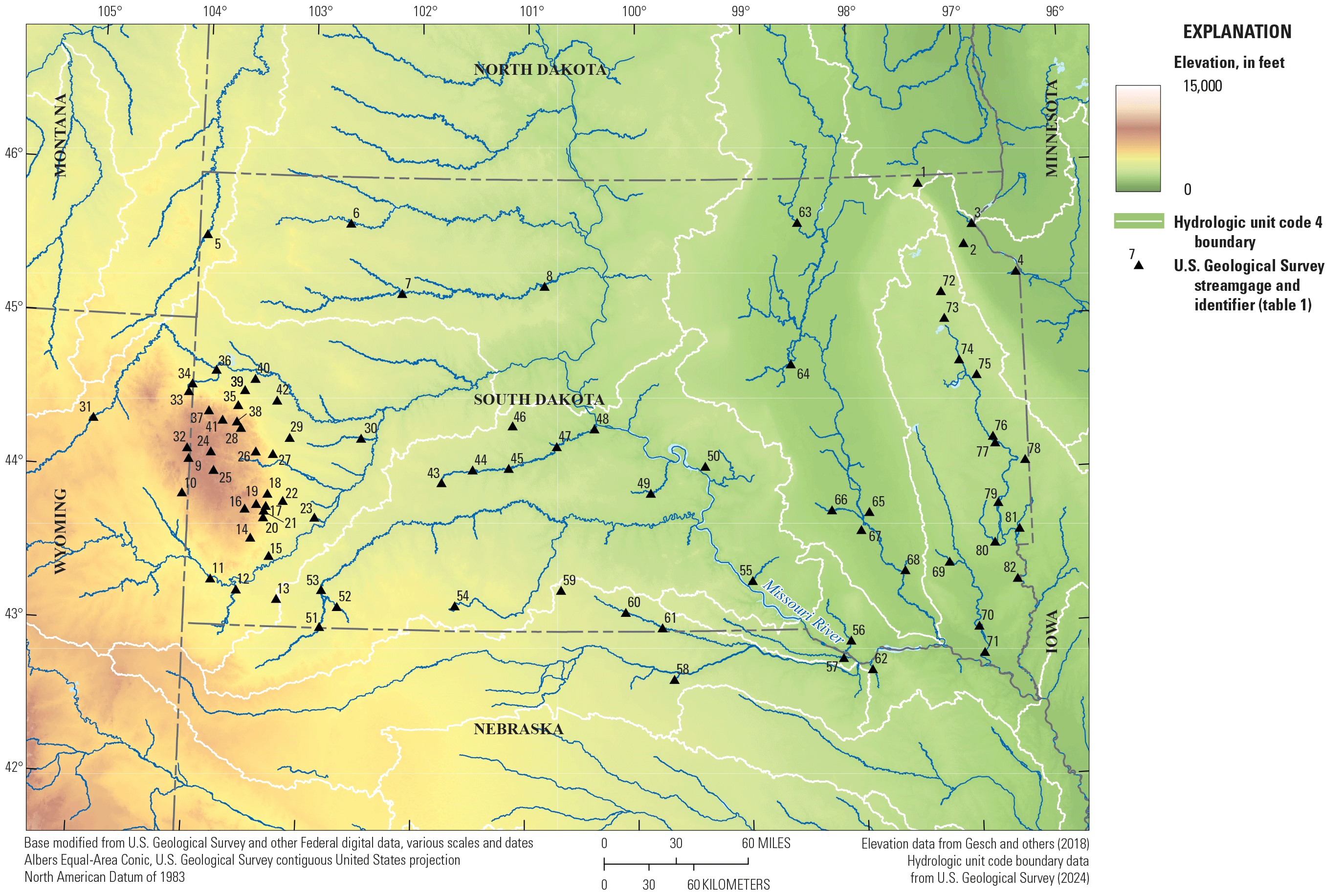
Map showing elevation, hydrography, and longer-term streamgages in South Dakota included in this study.
Climate
South Dakota lies in the northern Great Plains and Central Lowlands, which straddle the transitions from the moist eastern United States to the semiarid region to the west. Because of its location in the center of North America, it is farther from the moderating effects from oceans, allowing for a large range of temperature extremes. According to the recent update of the South Dakota State Climate summary (Frankson and others, 2022), the average January temperatures range from less than 10 to 15 degrees Fahrenheit (°F) in the northeast to more than 25 °F in the southwest. Average July temperatures range from about 65 °F in Black Hills to more than 75 °F in the south-central region. Temperatures of 100 °F or more are measured nearly every year. The warmest year on record was 2012, and the statewide average temperature was 49.3 °F (4.6 °F greater than the long-term [1895–2020] average). The lack of mountain ranges to the north exposes the State to bitterly cold arctic air masses in winter (Frankson and others, 2022). Average annual temperature in South Dakota generally increases from the north to the south with locally lower annual temperatures in the Black Hills. The northern third of the State has an annual average temperature of 40–45 °F, the central and southern parts of the State range from 45 to 50 °F, and the higher elevations in the Black Hills are less than or equal to 40 °F (fig. 3).
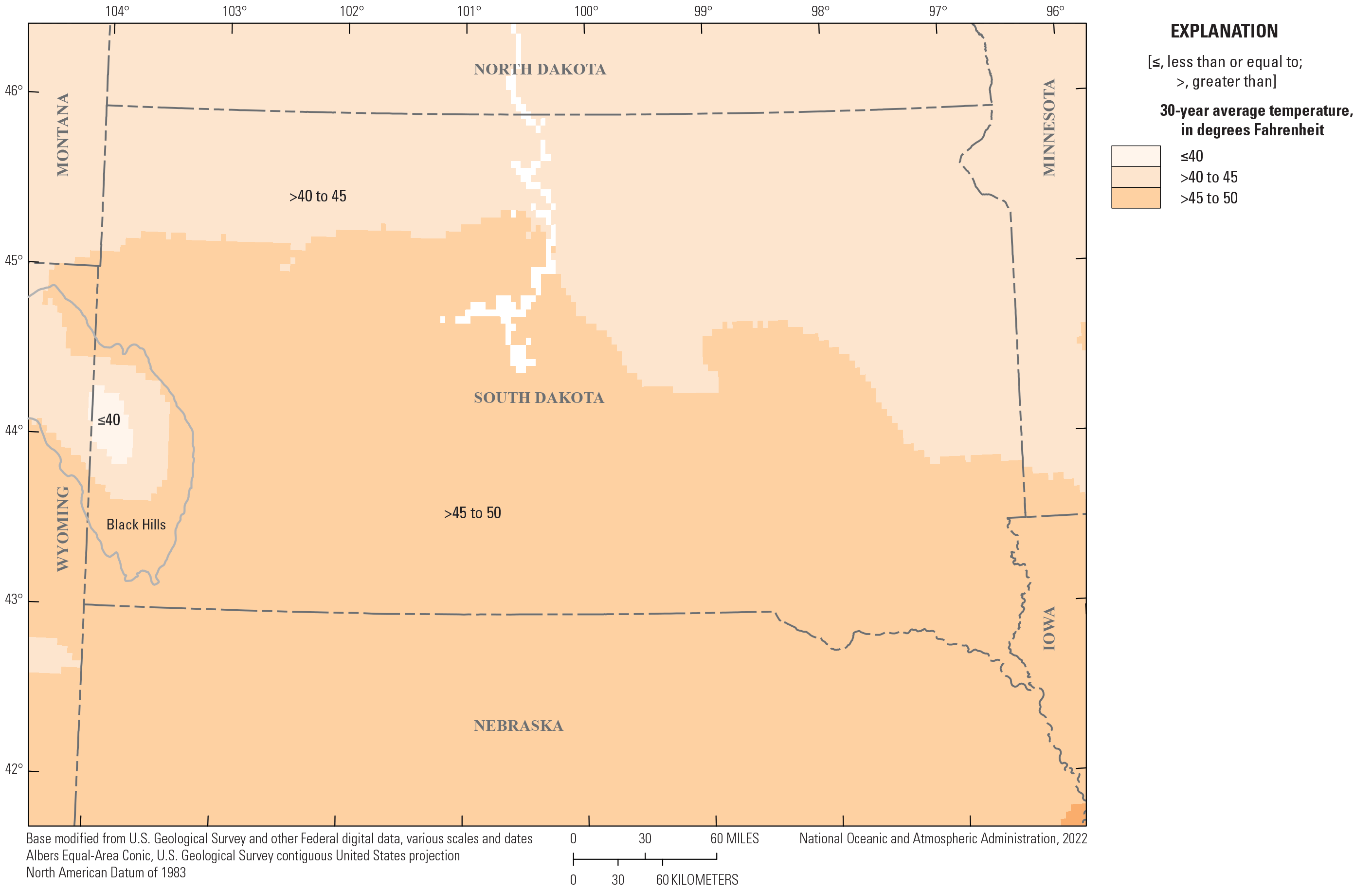
Map showing the average annual temperature for the 30-year period from 1991 to 2020 in South Dakota (National Oceanic and Atmospheric Administration, 2022).
Average annual precipitation in South Dakota generally increases from the northwest to the southeast (fig. 4), and locally higher precipitation is detected in the Black Hills. Most of the State’s precipitation falls between April and September when thunderstorm activity is highest. Average annual precipitation ranges from nearly 15 inches (in.) in the northwest to about 30 in. in the southeast (Frankson and others, 2022). Statewide total annual precipitation varies widely from year to year, ranging from a low of 10.9 in. in 1936 to a high of 31.4 in. in 2019. The driest multiyear period on record was in the 1930s and the wettest was in the late 1990s and from 2008 to present (2020). Annual precipitation has ranged from an average of 14.3 inches per year during the driest consecutive 5-year interval (1933–37) to an average of 23.2 inches per year during the wettest consecutive 5-year interval (2007–11). Summer precipitation has generally been greater than average since 2008 (Frankson and others, 2022). Most of the State averages at least 30 in. of snow annually, but parts of Black Hills can receive upwards of 70 in. annually.
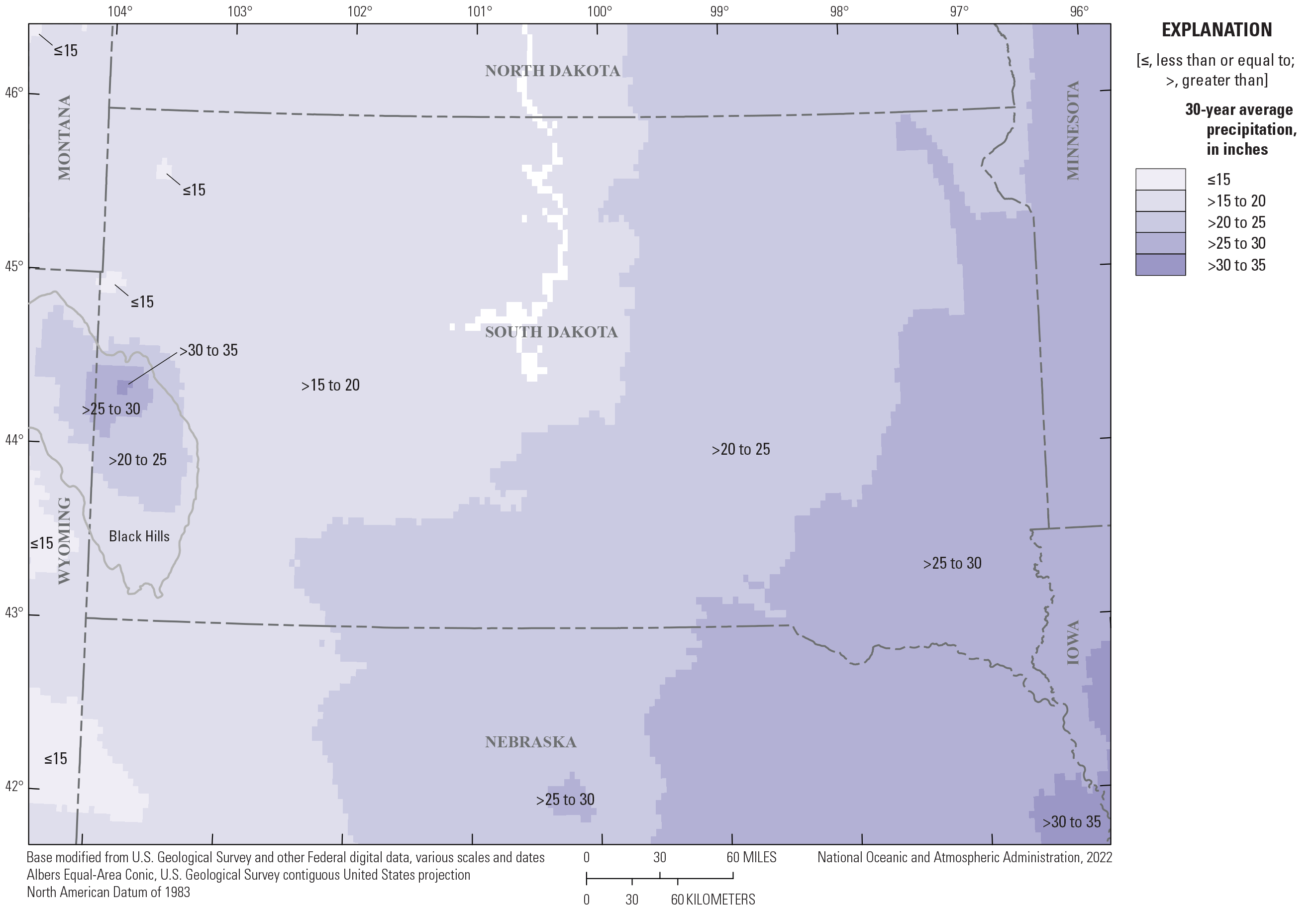
Map showing the average annual precipitation for the 30-year period from 1991 to 2020 in South Dakota (National Oceanic and Atmospheric Administration, 2022).
Geology
The geology is quite diverse across South Dakota, and the effects of geology on peak-flow characteristics can be highly variable. Most of South Dakota east of the Missouri River (fig. 5) has been glaciated, and a wide variety of surficial deposits can be detected within small areas (Martin and others, 2004), with potential for substantial effects on infiltration capacity and associated effects on peak-flow characteristics. Most glaciated areas in South Dakota are dominated by glacial tills, which generally have high clay content and low infiltration capacity but can also have surficial deposits of much coarser grained materials with higher infiltration capacities (Sando and others, 2008). In contrast, the Cretaceous-age Pierre Shale is the dominate geologic outcrop in western South Dakota. These shale soils are clay rich and have low infiltration capacity. The common occurrence of clays and siltstones in other Cretaceous formations may result in flashy hydrologic systems in parts of western South Dakota (Sando and others, 2008). The “Badland” topographies are in several drainages in western South Dakota. These formations have steep slopes, minimal vegetation cover, and highly erodible soils. Similarly, the hydrologic systems in the Badlands may also be flashy because of these characteristics. The geology in the Black Hills physiographic region (fig. 5) is complex and has distinct effects on the annual peak streamflows. Driscoll and Carter (2001) identified five hydrogeologic settings that have substantial effects on general streamflow characteristics: the “limestone headwater”; “crystalline core”; the overlapping hydrogeologic settings of the “loss zone” and “artesian spring,” which approximates the outer extent of the Black Hills area; and the “exterior” (fig. 6 in Sando and others, 2008). For a more detailed description of the five hydrogeologic settings, the additional physiographic divisions, and location of the major rivers in South Dakota, see Sando and others (2008).
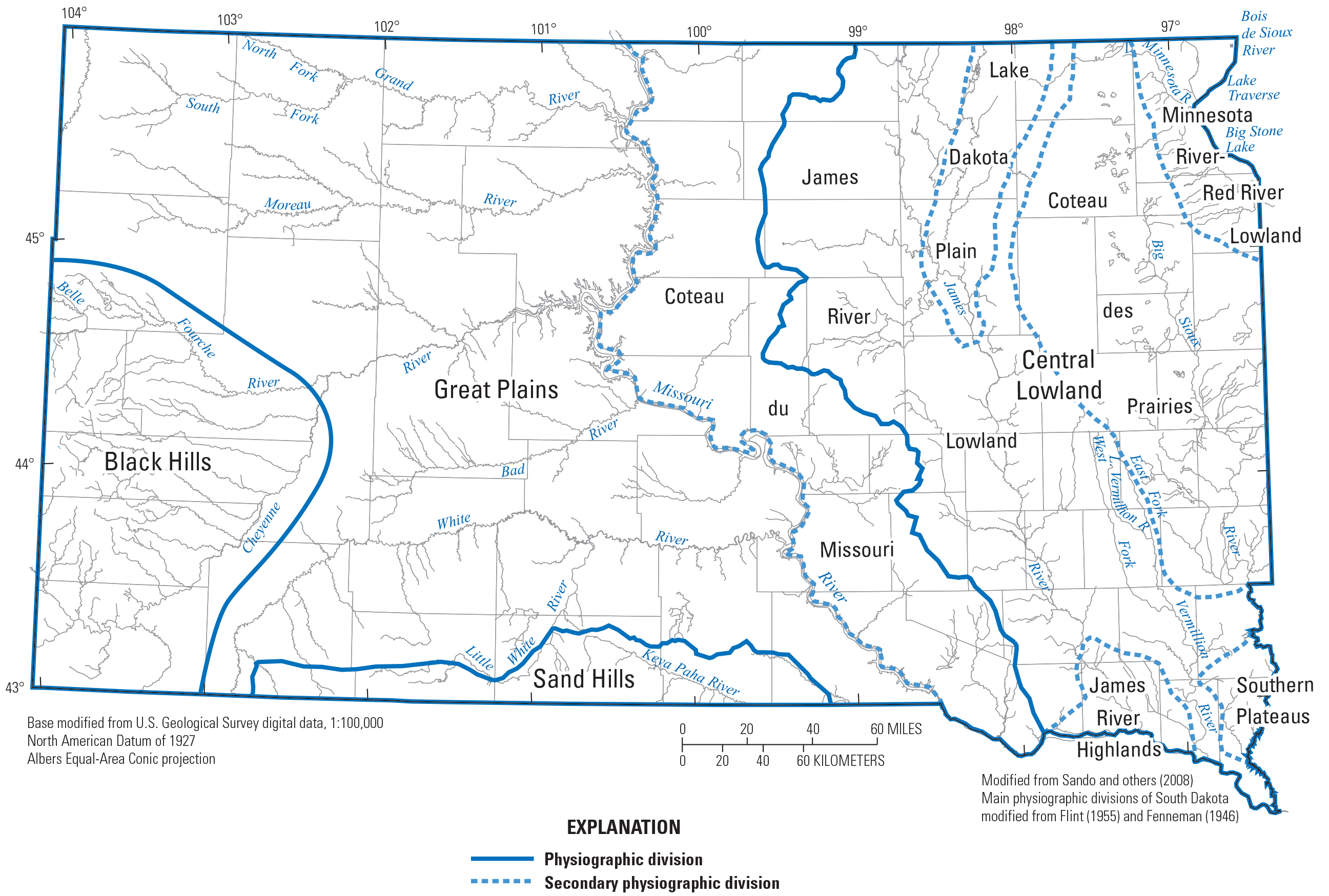
Map showing the main physiographic divisions and location of major rivers in South Dakota (modified from Sando and others [2008]).
Similarly, figure 6 shows the diversity and complexity of dominant hydrologic soil groups in South Dakota. Similar to the spatial distribution of geologic formations across South Dakota, the hydrologic soil groups can be broadly categorized into the Black Hills physiographic region and those soils west and east of the Missouri River. In general, the eastern part of the State is dominated by group B soils, which have moderately low runoff potential. Of note is a distinct localized soil group C in the Lake Dakota Plain physiographic region shown in figure 5. These soils have moderately high runoff potential, and water transmission through the soil is somewhat restricted compared to the more common soils of group B in the eastern part of South Dakota. In contrast, the soils to the west of the Missouri River and outside the Black Hills are largely composed of group D. Group D soils have high runoff potential, and water movement through the soil is restricted or very restricted. The contrasting soil groups separated by the Missouri River from west to east may play a role in longer term antecedent soil moisture conditions related to multidecadal periods with lower annual peak-flow magnitudes (flood poor) followed by more frequent higher annual peak-flow (flood rich) conditions in the various trend periods evaluated in this study.
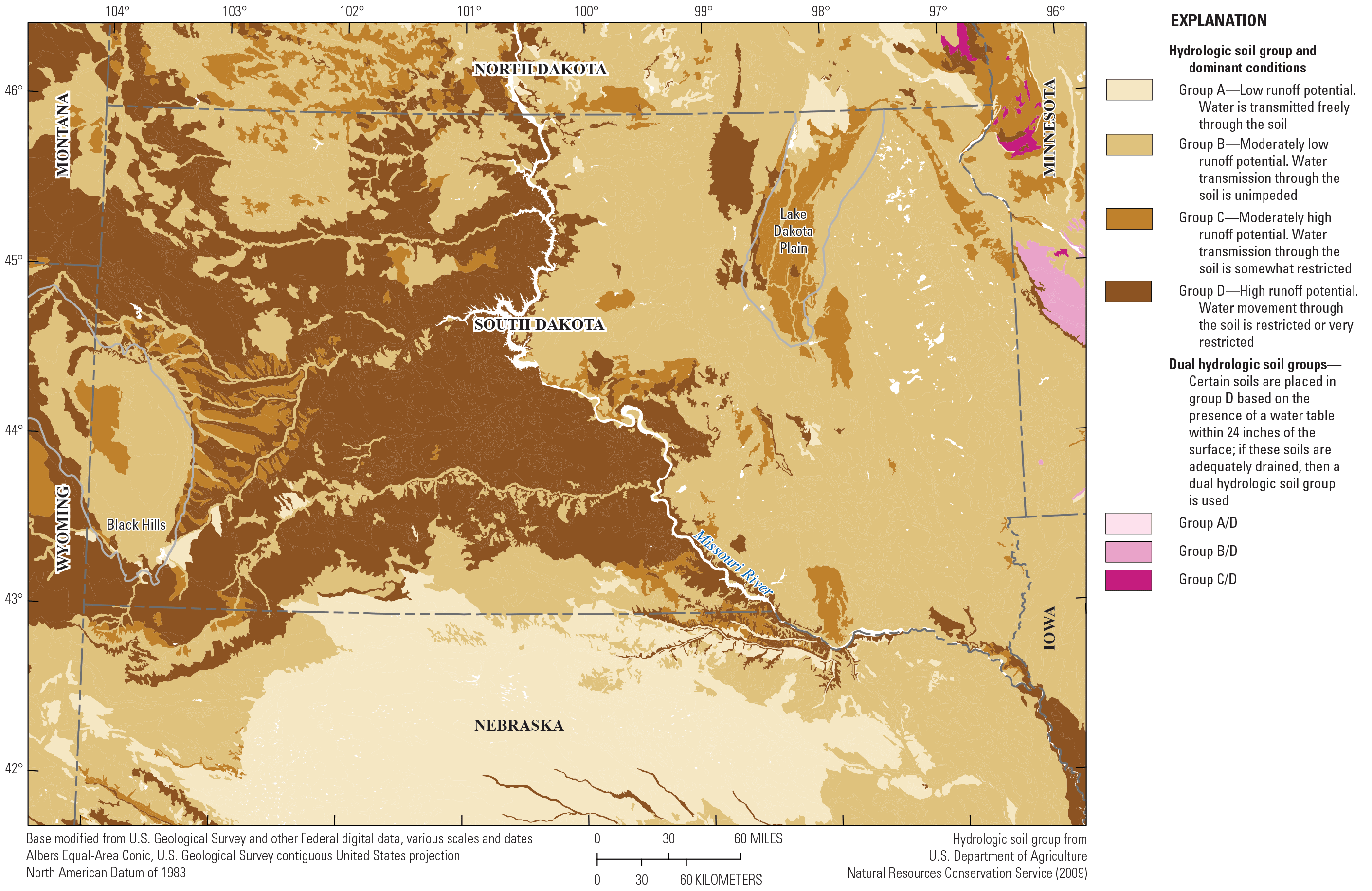
Map showing the dominate hydrologic soil groups in South Dakota (U.S. Department of Agriculture Natural Resources Conservation Service, 2009).
Level III Ecoregions
Ecoregion classifications (levels I to III) group geographic regions into areas with common biotic and abiotic characteristics including geology, climate, topography, and vegetation (U.S. Environmental Protection Agency, 2013, 2021). The major level III ecoregions within South Dakota are the Middle Rockies (17), covering the physiographically unique Black Hills; the Northwestern Great Plains (43), covering much of the western and central parts of South Dakota west of the Missouri River; the Northwestern Glaciated Plains (42) in the Coteau du Missouri physiographic region, in a narrow region east of the Missouri River (fig. 5); and the Northern Glaciated Plains (46), which encompass the Central Lowland physiographic region (fig. 5) spanning much of eastern South Dakota. Regions 43, 42, and 46 fall along a west to east progression across the State (fig. 7). Region 43 encompasses the Northwestern Great Plains and is mostly semiarid, unglaciated rolling plains with occasional buttes and badlands. Rangeland is common in region 43, but agriculture is restricted by erratic precipitation and limited opportunities for irrigation. Region 42 is a transitional zone between the semiarid region 43 and the wetter and more agricultural Northern Glaciated Plains (region 46) to the east. The western and southwestern boundaries of region 42 generally follow the western terminal extent of continental glaciation along the eastern edge of the Missouri River in South Dakota (Sando and others, 2008). Region 42 also contains the Prairie Pothole Region, an area of concentrated semipermanent and seasonal wetlands (Sando and others, 2008). Region 46 in South Dakota is generally characterized by flat to gently rolling landscape consisting of glacial till and also has abundant temporary and seasonal wetlands, known as prairie potholes (U.S. Environmental Protection Agency, 2013, 2021).

Map showing the level III ecoregions in South Dakota (U.S. Environmental Protection Agency, 2013, 2021).
Hydrology
A spatially diverse range of flood-generating mechanisms including snowmelt, ice jams, intense rainfall events, and rain-on-snow events occur in South Dakota. The magnitude of spring peak streamflows is affected by a range of winter and spring weather conditions. Spring peak streamflows are driven by a combination of snow cover, antecedent soil moisture conditions, the previous winter temperatures, precipitation and temperatures during river ice breakup, depth of frost penetration into the soil, occurrence of ice jams, and the time of occurrence of river ice breakup (McCabe and Crosby, 1959). Smaller spring floods occur when the river ice breakup is earlier in the spring and the rate of snowmelt is slow, thus reducing the magnitude of the peak. In contrast, the largest river ice breakup floods are caused by high antecedent moisture, heavy snow cover, a frozen ground surface, and precipitation coinciding with a late seasonal river ice breakup (McCabe and Crosby, 1959).
One of the most dangerous characteristics of river ice breakup floods is when they cause ice jams. Ice jams may result in the storage and sudden release of water that produces a peak streamflow that is unrelated to snow cover, precipitation, or any other factors that typically affect annual peak streamflows. Flood peaks during ice jams can have stages much higher than those for equivalent, non-ice streamflow and can be widespread within a reach or be restricted by a bridge near a streamgage (Thompson, 2006). Likewise, ice jam floods are difficult to predict because the processes causing them are complex.
Annual peak streamflows in South Dakota also are driven by rainfall in the late spring through fall. Some of the largest annual peak streamflows on record, such as in the Black Hills (Sando and others, 2008), are generated by localized summertime convective storms that produce heavy precipitation over a short period of time, representing a mixed population of flood-generating mechanisms (for example, springtime snowmelt and convective thunderstorms).
Brief History of U.S. Geological Survey Peak-Flow Data Collection in South Dakota
An understanding of the history of streamgage operations is relevant to nonstationarity analyses because it provides information on the temporal distribution of the available data. Two types of streamgages are typically used for observing and recording annual peak-flow magnitudes. Continuous streamgages continuously record river stage and are used to create a daily record of streamflow and calculate the magnitude of the annual peak streamflow per water year (WY; the period from October 1 to September 30 that is designated by the year in which it ends), which may differ from the annual peak stage. Crest-stage gages (CSGs) record only the annual peak stage in a given WY, which is then used to calculate the annual peak streamflow. In the case of the former, the timing of the annual peak streamflow may be known within minutes of its occurrence; in the case of the latter, the timing of the annual peak streamflow may only be known within days or weeks of its occurrence. The number of continuous streamgages in South Dakota (fig. 8) steadily increased after 1930 and has remained about the same since 1970 (U.S. Geological Survey, 2021). The number of CSGs in the network (fig. 8) has varied substantially over time, indicating three distinct periods. The number of CSGs rapidly increased in the 1950s, followed by a sharp increase in the 1970s. This increase in the 1970s represents a national CSG network funded by the Federal Highway Administration to collect streamgage data for small drainage basins across the United States. After the funding for that national campaign concluded, the CSG streamgage network in South Dakota was substantially reduced. With the recognized shortage of streamflow data in smaller drainage basins, the USGS, in cooperation with the South Dakota Department of Transportation, began increasing the number of CSGs around the year 2000 (fig. 8), and the number of CSGs averaged around 75 between 2010 and 2020.
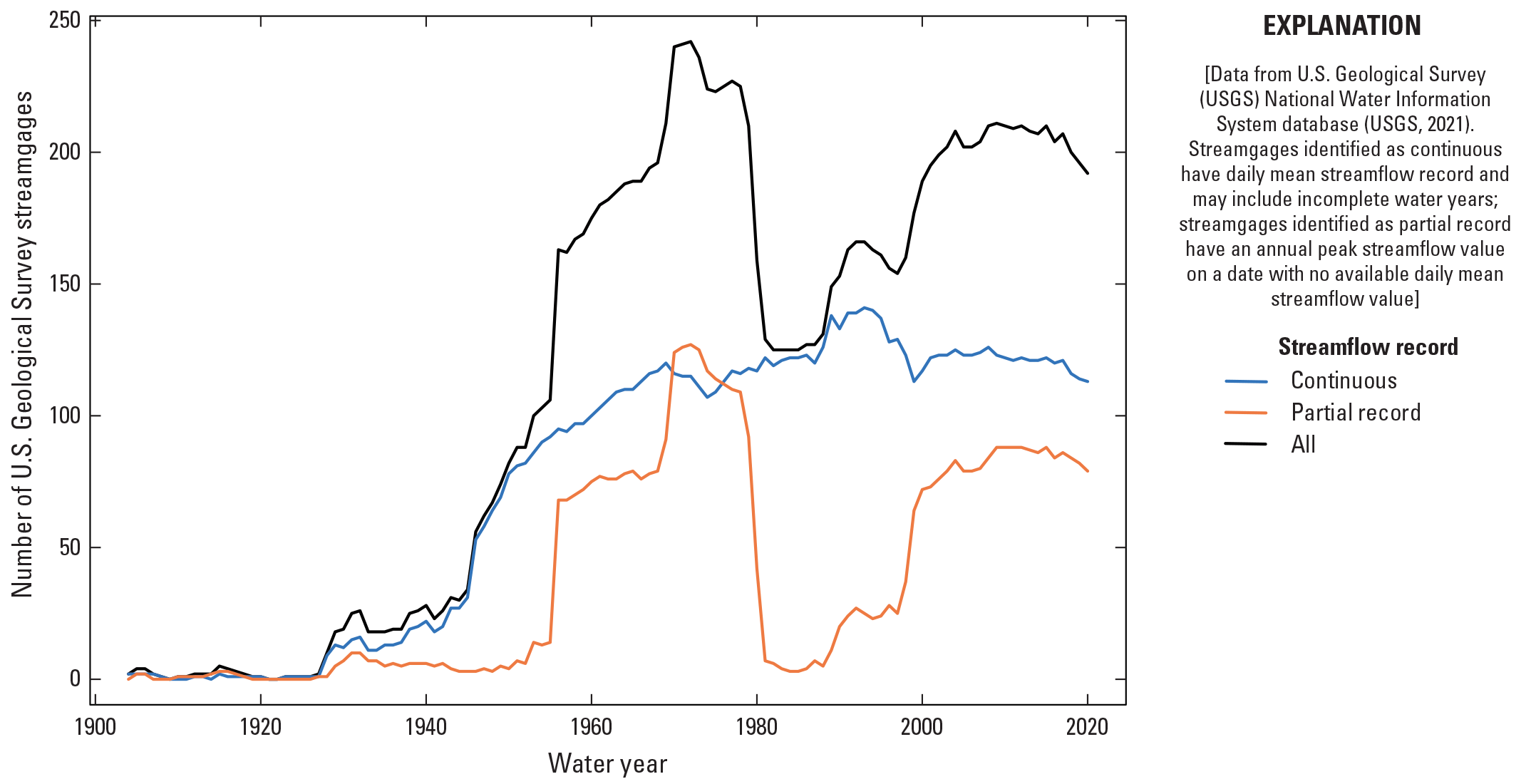
Graph showing the total number of U.S. Geological Survey streamgages in operation per water year and the number of continuous and crest-stage streamgages in South Dakota that have 10 or more years of record through 2020. [A water year is the 12-month period from October 1 to September 30 and is designated by the year in which it ends]
Many of the long-term streamgages in South Dakota have moderately large to large drainage areas and tend to be on the main stems or large tributaries to the major rivers (Sando and others, 2008). Records for many of the stations with smaller drainage areas were collected over shorter timeframes and are part of partial-record streamgage networks.
Brief History of Statistical Analysis of Peak Streamflow and Nonstationarity in South Dakota
An improved understanding of the frequency and magnitude of floods is critical for the design of transportation and water-conveyance structures such as culverts, roads, bridges, and dams and for floodplain management. Methods for estimating annual exceedance probabilities (AEPs; or return intervals) in the United States have been codified in a number of Federal guidelines since the U.S. Water Resources Council’s Bulletin 15 (U.S. Water Resources Council, 1967), which includes Bulletins 17 (U.S. Water Resources Council, 1976), 17A (U.S. Water Resources Council, 1977), 17B (Interagency Advisory Committee on Water Data, 1982), and the recently updated methodologies in Bulletin 17C (England and others, 2018). However, before Federal guidelines for estimating the magnitude and frequency for gaged and ungaged basins existed, there was still a need for these estimates.
A number of reports have been published since 1959 for the State of South Dakota (table 2). An early flood-frequency analysis (FFA) was completed before a Federal guideline documenting procedures for doing FFAs (McCabe and Crosby, 1959), using the first of the bulletin series (Bulletin 15 [U.S. Water Resources Council, 1967]; Becker, 1974, 1980) and using the long-standing guidelines in Bulletin 17B (Interagency Advisory Committee on Water Data, 1982) (Becker, 1982; Benson and others, 1985; Hoffman and others, 1986; Burr and Korkow, 1996; Niehus, 1996; Sando, 1998; Sando and others, 2008; Harden and others, 2011; table 2). Many of the reports provided various AEP quantile estimates; however, a number of these studies highlighted the need for more complex statistical approaches to incorporate nonstandard data such as historical information from newspaper and citizen accounts to extend the base period of an historical event to a longer period of time (McCabe and Crosby, 1959), update regional skew estimates (Sando, 1998), address mixed populations in the Black Hills, use record extension to address hydroclimatic variability in eastern South Dakota, address zero flows and low outliers (Sando and others, 2008), and incorporate paleoflood data to better estimate the return intervals and their uncertainties for high outliers in the Black Hills (Harden and others, 2011). In most cases, these advanced statistical approaches were not covered in Bulletin 17B; however, a number of them are now addressed in Bulletin 17C (England and others, 2018), incorporating nonstandard data through perception thresholds and nonexceedances, zero flows and multiple low outliers, new approaches for regional skew estimates, and more advanced methods for record extension. Furthermore, McCabe and Crosby (1959) and Burr and Korkow (1996) recognized the need to use partial duration series (peaks-over-threshold [POT] analysis) to evaluate secondary annual peak streamflows, which may be as large as the annual peak streamflow in high-flow WYs, yet both reports inevitably used the traditional annual maximum peak-flow series because of the challenge of identifying the required independent peaks criterion.
Table 2.
Summary of important references in the history of statistical analysis of annual peak streamflows in South Dakota.[A water year is the 12-month period from October 1 to September 30 and is designated by the year in which it ends. FFA, flood-frequency analysis; NA, not applicable; USWRC, U.S. Water Resources Council; WY, water year; IACWD, Interagency Advisory Committee on Water Data; DA, drainage area; FEMA, Federal Emergency Management Agency]
| Reference | Geographic extent of study | Number of streamgages in or near South Dakota for which FFAs were reported | FFA method | Regional FFA methods, including graphical and regression methods | Comments |
|---|---|---|---|---|---|
| McCabe and Crosby (1959)1, 2 | Two-State region of North and South Dakota | 10 | Composite FFA for select for unregulated sites greater than 100 square miles | NA | This report also includes a detailed description of hydroclimatic information on flood-generating mechanisms that could later be used to evaluate changes in the seasonality from early spring snowmelt to summer and fall rainfall events. They also describe a need to incorporate historical information from newspaper accounts, local historical society records, and citizen accounts to extend the base period of the historical flood to a longer period of record. They also noted that annual maxima and partial-durations series could be used for FFA, stating that “[A] fault of the annual-flood series is that it omits the secondary floods, which in high years might be higher than the annual floods in most years (p.5).” Recognizing that a fault of the partial-duration series is the potential dependence between the flood events, they chose not to use partial-duration series for FFA yet provided a list of the partial-duration series using three techniques to overcome the dependence issue. |
| Becker (1974)3, 4 | South Dakota and adjoining States | 200 | Bulletin 15 of the USWRC (1967) | Regional regression equation for two regions in the James River Basin. | FFA was provided through WY 1972 for streamgages with at least 5 years of data. A total of 162 streamflow records with at least 10 years of streamgage data were used for the regional regression equations. Some modifications were made for poor fits of the FFA curves. |
| Becker (1980)3, 4 | South Dakota | 115 | Bulletin 15 of the USWRC (1967) | Regional regression equations using a linear least-squares approach. | In addition to updating at-site FFAs from Becker (1974), Becker (1980) also published flood volume estimates for estimating the expected hydrograph shape of rainfall-induced runoff on small streams in South Dakota. The regression relations were deemed applicable for estimating floods on basins draining 0.05 to 100 square miles and 0.05 to 15 square miles for estimating flood volumes. |
| Becker (1982)3, 4 | South Dakota | 120 | Bulletin 17B of the IACWD (1982) | NA | This report used annual peak streamflow data from WYs 1955 to 1981. Furthermore, 66 short-term sites were extended based on long-term climatic records and a rainfall-runoff model. |
| Benson and others (1985)3 | South Dakota | 111 | Bulletin 17B of the IACWD (1982) | NA | This report used annual peak streamflow data though WY 1983. |
| Hoffman and others (1986)3 | South Dakota | 185 | Bulletin 17B of the IACWD (1982) | NA | This report used annual peak streamflow data though WY 1985. |
| Niehus (1996)5 | Big Sioux River between Akron, Iowa, and North Sioux City, South Dakota | 13 | Bulletin 17B of the IACWD (1982) | NA | Based on four candidate methods for estimating FFA, the DA ratio method provided the best estimates of flood flows for the Akron to North Sioux City reach along the Big Sioux River. These results were used for a FEMA insurance study. |
| Burr and Korkow (1996)3 | South Dakota | 234 | Bulletin 17B of the IACWD (1982) | NA | This report used annual peak streamflow data through WY 1994. FFA estimates were not updated at 16 continuous-record streamgages because of extreme variability in the annual peak-flow series, more than 20 percent of the record having no flow [zero flows], annual peak streamflows representing large outflow from a spring, insufficient amount of data before regulation, and combining peak-flow records with nearby stations. Partial duration series were also reviewed; however, they were not used to update peak-flow frequency estimates. |
| Sando (1998)3 | South Dakota | 197 | Bulletin 17B of the IACWD (1982) | Regional regression equations using a generalized least-squares approach. | This report used annual peak streamflow data through WY 1994. Additional techniques were explored for estimating peak-flow magnitude and frequency relations including completing a generalized skew analysis to test the validity of using the generalized skew map in Bulletin 17B (IACWD, 1982). Inevitably, it was determined that the Bulletin 17B skew map provided adequate skew coefficients for South Dakota. Additionally, examples were provided for (1) determining FFAs for ungaged sites on ungaged streams, (2) determining weighted peak-flow frequency estimates for streamgages, and (3) using a DA ratio method for determining FFA for ungaged sites near a streamgage on the same stream and an ungaged site between two streamgages on the same stream. |
| Thompson (2006)3 | South Dakota | 182 | NA | NA | This report examines annual peak stages resulting from backwater conditions using streamgage data through WY 2001. In South Dakota, backwater is commonly caused by ice and produces a peak stage higher than the stage coincident with annual peak streamflows from open channel conditions. This information on backwater effects can later be used to inform FFAs using updated Federal guidelines in Bulletin 17C (England and others, 2018). |
| Sando and others (2008)3 | South Dakota | 272 | Bulletin 17B of the IACWD (1982) | NA | This report used annual peak streamflow data through WY 2001. Record extension was used to address nonrepresentative climatic conditions during several periods and reduce inconsistencies among multiple streamgages along common stream channels with different periods of record. A regional mixed-population analysis was developed for sites in the Black Hills that had unrealistic frequency estimates when high outliers were recorded and inconsistencies in peak-flow estimates when streamgages with similar climatic and hydrogeologic characteristics did or did not record a high outlier in the gaging record. Historical adjustments were also made to extend records back to 1881 for selected sites. |
| Harden and others (2011)3, 6, 7, 8 | Black Hills, South Dakota | NA | Bulletin 17B of the IACWD (1982) | NA | This report summarizes the results of paleoflood investigations for Spring Creek, Rapid City, Boxelder Creek, and Elk Creek. Stratigraphic records and resulting long-term flood chronologies, locally extending more than 2,000 years, were combined with observed and adjusted peak-flow values (gaged records) and historical flood information to derive flood-frequency estimates for the six study reaches. Results indicate that (1) floods as large as and even substantially larger than 1972 have affected most of the study reaches and (2) incorporating the paleohydrologic information substantially reduced uncertainties in estimating flood recurrence. |
Review of Research Relating to Climatic Variability and Change in South Dakota
Several USGS reports have been published related to historical flood and droughts, climate variability, and longer-term climate effects on streamflow. This section highlights those reports.
Historical Flood and Drought Periods in South Dakota
In addition to the numerous reports on updating FFAs and regional regression equations for ungaged basins in South Dakota (table 2), 6 USGS reports and 1 article describing notable floods in South Dakota were published (table 3). These reports highlight common flood-generating mechanisms for high flows, especially in eastern South Dakota. The 1984, 1995, and 1997 regional floods were generated by multiple causal mechanisms—higher than average antecedent soil moisture conditions, high winter snowfall, springtime snowmelt, and heavy precipitation in April and May (Engel and Benson, 1987, p. 198; Teller and others, 1995; Teller and Burr, 1998; Holmes and others, 2013). Schwarz and others (1975) and Driscoll and others (2010) describe high flows because of convective summertime thunderstorms in the Black Hills.
Table 3.
Summary of important references for notable floods in South Dakota.[A water year is the 12-month period from October 1 to September 30 and is designated by the year in which it ends. USGS, U.S. Geological Survey]
| Reference | Geographic extent of study | Year of notable flood event | Flood-generating mechanisms | Comments |
|---|---|---|---|---|
| Engel and Benson (1987) | Southeast South Dakota and eastern Nebraska | 1984 | Multiple causal mechanisms: greater than normal precipitation and antecedent soil moisture | Floods were generated by wet antecedent conditions during October 1983 through March 1984. An active weather pattern persisted over the area, and rainfall fell on ground that was near saturation from greater than normal precipitation during April and May. Ultimately, late May and early June weather patterns resulted in 3 weeks of storms in the central and upper Midwest, resulting in widespread flooding along the James River, Vermillion River, and the Big Sioux River Basins in South Dakota (fig. 5). These notable flood flows caused widespread regional flooding that was the largest since 1952. |
| Teller and others (1995) | South Dakota | 1995 | Multiple causal mechanisms: greater than normal late winter and spring snowfall and unusually heavy rainfall in April and May | Similar to the 1995 springtime floods, the 1993 spring floods were also generated by snowmelt and continued spring rains. Several streamgages recorded peak streamflows exceeding the 100-year recurrence interval for the 1993 and 1995 flood events. |
| Teller and Burr (1998) | North-central and eastern South Dakota | 1997 | Multiple causal mechanisms: heavy precipitation between September 1996 and February 1997 and severe blizzard conditions | Although the 1993 and 1995 floods shared similar mechanisms that generated the springtime floods, the 1997 flood event was generated by several compounding affects. A potential for extensive flooding was recognized, and emergency planning was put into effect. However, a relatively slow warming period during March likely averted catastrophic severe flooding. However, the 1997 flooding equaled or exceeded the 500-year return interval at two USGS streamgages and the 100-year return period at five additional streamgages. |
| Driscoll and others (2010)1, 2 | Black Hills, South Dakota | 2007 | Summertime convective thunderstorms | This report describes the 2007 large mesoscale convective thunderstorms and associated flooding in the Black Hills area compared to the historic 1972 storms and floods. Additionally, the extensive history of large floods in the Black Hills area is provided with chronological overviews of events from the pre-settlement years through water year 2009. Factors affecting flooding in the Black Hills are also included. |
Peak streamflow in eastern South Dakota can be strongly affected by antecedent soil moisture from decadal climatic persistence and tend to be highly correlated compared to streamgages in the western part of the State (Sando and others, 2008). Global climate change was identified by Sando and others (2008) as a potential agent for historical droughts and floods during persistent dry and wet climatic periods. For example, many partial-record CSGs were operated during 1970–79 (fig. 8), a particularly dry climatic period in eastern South Dakota, and large magnitude annual peak streamflows are therefore underrepresented compared to the longer term streamgage records. Because of decadal-scale oscillations in wet and dry periods, streamgage records may under or overrepresent annual peak-flow magnitudes if they have short records (Lins and others, 2010). To quantify these potential effects, Sando and others (2008) explored the effects of sampling peak streamflows in dry and wet climatic periods on the annual peak-flow characteristics (mean and standard deviation) used to inform the parameters of the log-Pearson type III distribution and corresponding peak-flow frequency curve for AEPs of interest. They used nine USGS streamgages in eastern South Dakota (stations 06473000, 06475000, 06476000, 06477000, 06478500, 06479000 [SD70], 06481000 [SD79], 06481500 [SD80], and 06482020; U.S. Geological Survey, 2022) to estimate the geometric mean and standard deviation for the complete period of record (1950–2001) and the two 10-year periods of 1970–79 and 1992–2001. A comparison of these peak-flow characteristics for the 9 streamgages over 7 10-year periods (1950–60, 1961–70, 1971–80, 1981–90, 1991–2000, 2001–10, and 2011–20) relative to a long-term period (71 years; 1950–2020) was updated using the same methods as Sando and others (2008) and adding the skewness. The median geometric mean of the annual peak-flow magnitudes varied by as much as 3,000 cubic feet per second (ft3/s), the standard deviation of the base-10 logarithm of annual peak streamflows varied by as much as 0.17 ft3/s, and the skewness of the base-10 logarithms of annual peak streamflows varied from −0.75 to +0.75 (fig. 9A–C). These large differences continue to illustrate the sensitivity of sampling variability because of decadal and multidecadal climate variability and the changes these have on the peak-flow characteristics, underscoring the need to reexamine hydroclimatic variability in the nine-State study area.
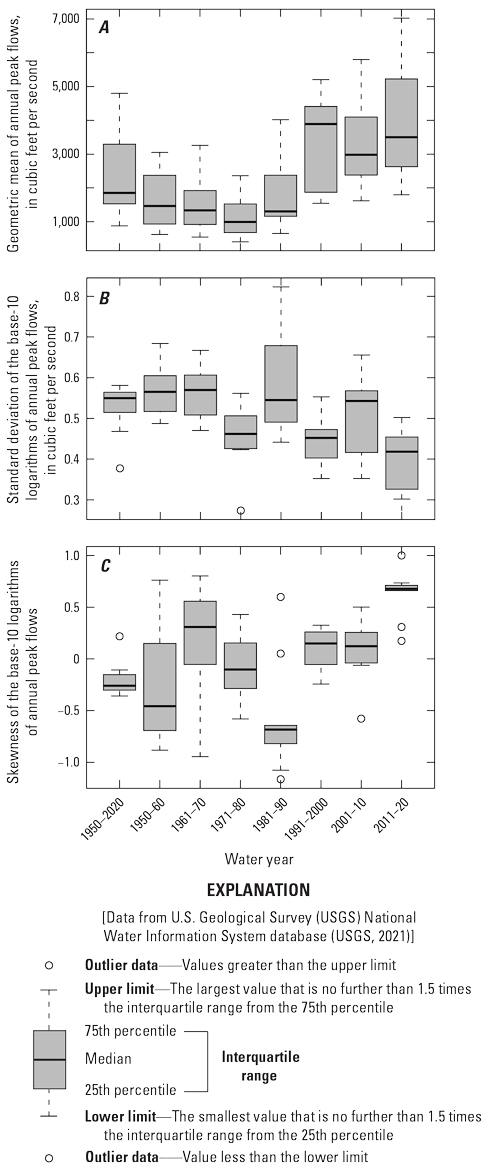
Boxplots showing the statistical distribution of the peak-flow characteristics for the (A) geometric mean, (B) standard deviation, and (C) skewness of the base-10 logarithm of the annual peak streamflows for 9 selected streamgages in eastern South Dakota for 7 10-year periods (1950–60, 1961–70, 1971–80, 1981–90, 1991–2000, 2001–10, and 2011–20) relative to a long-term period (71 years; 1950–2020).
Review of Evidence of Climatic Variability
Several USGS reports published over the past decade have evaluated changes in longer term climatic variability based on long-term streamgage records and paleoflood information. Norton and others (2014) examined trends in annual, seasonal, and monthly flows for 227 streamgages in the Missouri River Basin and its tributaries using data from 1960 to 2011. They used Kendall’s tau nonparametric test and detected upward trends (p-values less than or equal to 0.10) in annual streamflow among all 23 sites in the eastern part of South Dakota. They similarly detected significant upward trends in seasonal streamflow. Summer (July–September) and autumn (October–December) had the most streamgages with upward trends (23), whereas winter (January–March) had the fewest streamgages with upward trends (17). More recently, Norton and others (2022) examined monotonic trends in mean annual streamflow across the conterminous United States from 1960 to 2019. They compared the mean annual streamflow of the last decade (2010–19) to the first decade (1960–69) of the study period and determined the largest increases in the annual streamflow and volumes were in eastern North and South Dakota. Specifically, they detected a 298-percent increase in streamflow volume at the USGS streamgage James River near Scotland, South Dakota (station 06478500), which represents an average of about 1.2 million acre-feet more water flowing downstream each year from 2010–19 compared to 1960–69. They attributed several potential factors, including changes in precipitation and the subsurface geology, as drivers of the increases.
Harden and others (2011) completed paleoflood investigations for Spring, Rapid, Boxelder, and Elk Creeks in the Black Hills of western South Dakota (table 2). Paleoflood information was needed to improve peak-flow FFAs for the Black Hills area after severe flooding in June 1972 resulted in at least 238 deaths from a large summertime convective storm system. Harden and others (2011) used stratigraphic records to develop long-term flood chronologies, extending flood records more than 2,000 years into the past. These records were combined with observed and adjusted annual peak-flow values at streamgages and historical flood information to derive improved flood-frequency estimates for the six study reaches. Results indicated that (1) floods at least as large as the 1972 flood occurred in most of the study reaches and (2) incorporating the paleohydrologic information substantially reduced uncertainties in flood recurrence estimates. The use of paleoflood information in the Black Hills area contextualizes a more realistic recurrence of extreme floods by using a much longer period of record and indicates the presence of previous hydroclimatic regimes producing between three and eight paleofloods substantially larger than the devastating 1972 flood event.
Climate Effects on Peak Streamflows and Runoff
According to the recent National Oceanic and Atmospheric Administration 2022 State Climate Summaries, under a climate scenario in which global greenhouse gas emissions continue to increase, historically unprecedented warming is projected during this century (Frankson and others, 2022). They determined that most of the State of South Dakota has warmed by 1–2 °F, and summers are likely to become increasingly hotter. Increases in evaporation rate because of rising temperatures may increase the rate of warm-season soil moisture loss and intensify naturally occurring droughts (Frankson and others, 2022).
Annual precipitation is projected to increase, and the largest increases are during spring and winter (Frankson and others, 2022). This projection could cause more flood mechanism conditions similar to the 1984, 1995, and 1997 regional floods (table 3). With the projected increase of winter and spring precipitation, extreme precipitation events are forecast to increase in frequency and intensity. Such extreme events have the potential to increase runoff and the magnitudes of springtime flooding, which can also reduce water quality and erode soils. Increased winter snowfall, rapid spring warming, and intense rainfall may also combine to produce devastating floods (Frankson and others, 2022). Since 1970, the number of 2-in. extreme precipitation events has been trending upward. These effects have already been observed in recent years, with wet antecedent conditions, numerous winter storms, and persistent precipitation throughout the spring, late summer, and early autumn, leading to many flood records, particularly along the Missouri and James Rivers in 2011 and 2019, respectively (Frankson and others, 2022).
Precipitation and streamflow projections are subject to a high degree of year-to-year variability. The amount, distribution, and variability of annual precipitation are also anticipated to change under a high emission scenario, with increases in winter and spring precipitation of 10–30 percent by the end of this century and a decrease in the amount of precipitation falling as snow (Frankson and others, 2022). The frequency of heavy precipitation events is projected to increase, with an increase of about 50 percent in the frequency of 2-day heavy rainfall events by 2050 (Frankson and others, 2022). The amount of precipitation falling in single-day heavy events is projected to increase 8–10 percent by midcentury. Low-probability but high-severity and high-impact climate events such as the extreme regional floods of 2011 and 2019 and widespread drought events of 2012 and 2021–22 are projected to increase. Based on the projected future changes in precipitation patterns, there can be a potential for more extreme rainfall events, warmer temperatures, and increased evaporative demand, and these may likely change the frequency, magnitude, or timing of floods and droughts in South Dakota.
Data
The criteria used for USGS streamgage selection and the compilation of the annual peak streamflow, daily streamflow, and climate data for qualifying streamgages in the nine-State study area are described in chapter A (Ryberg and others, 2024). The 82 total South Dakota streamgages selected for this chapter are shown in figure 2.
Methods
Methods used for the statistical analysis of annual peak streamflow and daily streamflow and climate are more thoroughly described in chapter A (Ryberg and others, 2024) and were completed using the open-source statistical software R (R Core Team, 2021). Graphical and tabular outputs were generated and combined into easily readable reports using R Markdown (Xie and others, 2019) and are published in the associated data release (Marti and others, 2024).
Statistical Analysis of Annual Peak Streamflow
Guidelines for determining peak-flow frequency—Bulletin 17C—describe initial data analysis to determine if the annual peak streamflow series is stationary or nonstationary (England and others, 2018). A stationary series meets the statistical assumptions of peak-flow frequency analysis as described in Bulletin 17C. A nonstationary series violates one or more of these assumptions. A primary assumption is that the annual peak-streamflow data for a given streamgage are independent and identically distributed (iid; England and others, 2018). Furthermore, Bulletin 17C recommends initial data analysis that includes the following: plotting the data, checking for autocorrelation, and checking for trends and shifts in the peak-flow series. Chapter A (Ryberg and others, 2024) describes the statistical analyses used to evaluate autocorrelation, monotonic (gradual) trends, and change points (abrupt shifts in the flow distribution) in greater detail. In addition to the initial data analysis described in Bulletin 17C, quantile regression, and the trend analysis of the timing of peak streamflow are completed and described in Ryberg and others (2024).
Statistical Analysis of Daily Streamflow
This study is focused on annual peak streamflow in the nine-State study area in the north-central United States; however, examining daily streamflow, particularly the higher end of the streamflow regime, may aid in understanding the processes affecting annual peak streamflow. Regime plots, raster-seasonality plots, center of volume analyses, and POT analysis are completed on daily streamflow series for streamgages selected to meet the completeness criteria for annual peak streamflow. Some sites (for example, CSGs) selected for annual peak streamflow analysis may not measure or calculate streamflow values; therefore, daily streamflow analyses are not available.
Raster-Seasonality Plots
The raster-seasonality plot provides a useful tool to evaluate the time of year (seasonality) of high to low streamflow conditions for streamgages with daily streamflow data. Raster plots are generated by ranking the continuous daily streamflow data over the entire trend period from the largest streamflow (cool blue colors) to the smallest streamflow values (warm tan colors). Next, the corresponding colors related to the daily streamflow values for all months (x-axis) in a WY are plotted on top of one another throughout the trend period (y-axis). Raster-seasonality plots are shown in the “Results of Streamflow and Climate Analyses” section below.
Peaks-Over-Threshold Analysis
As described in chapter A (Ryberg and others, 2024), a partial-duration flood series is a list of all flows (such as flood peaks) that exceed a chosen base stage or streamflow, regardless of the number of peaks resulting during a WY. A POT approach is based on the partial-duration flood series of daily mean streamflows greater than some threshold to complete a dual-domain model of the magnitude and timing (frequency) of floods (Lang and others, 1999). Because of a lack of general guidelines for setting a threshold for the floods greater than a base, this POT approach tends to be underused compared to analyses that use peak streamflows based on WY, for example. The primary challenge with the POT approach is meeting the independence criteria between candidate daily flood events. In this study, the approach described in Barth and others (2018) was applied to complete a POT analysis where, on average, there are two events per year (POT2) and four events per year (POT4), with no more than one event in a time window defined as 5 days plus the natural logarithm of the drainage area in square miles (|ln (drainage area) +5 days|).
Statistical Analysis of Climatic Data
The climatic data used is in this study come from the monthly water balance model (MWBM; McCabe and Wolock, 2011), which was run without calibration from 1895 to 2020 for the conterminous United States on the 1/24-degree grid of the National Oceanic and Atmospheric Administration Monthly U.S. Climate Gridded (also known as NClimGrid) dataset (Vose and others, 2014a, b). The MWBM predicts monthly time series of rainfall, snowfall, soil moisture storage, potential evapotranspiration (PET), snowpack snow-water equivalent, and runoff (in inches deep) for each grid point. The values for the grid points inside each delineated basin are then averaged to create basin-average values, which are used in the analysis. The basin-average runoff may be expected to approximate the streamflow at the outlet of the basin if the routing time to the outlet is much smaller than the monthly time step.
Presentation of Statistical Significance
For all statistical hypothesis tests, the p-values are reported in the associated data release (Marti and others, 2024). As described in chapter A (Ryberg and others, 2024), when the results of statistical tests for trends are mapped, the trends are presented using a likelihood approach, which was proposed by Hirsch and others (2015) as an alternative to simply reporting significant trends with an arbitrary cutoff point. Trend likelihood values were determined using the p-value reported by each test using the following equation: trend likelihood=1−(p-value/2). When the trend is likely upward or likely downward, the trend likelihood value associated with the trend is between 0.85 and 1.0; that is, the chance of the trend occurring in the specified direction is at least 85 out of 100. When the trend is somewhat likely upward or somewhat likely downward, the trend likelihood value associated with the trend is between 0.70 and 0.85; that is, the chance of the trend occurring in the specified direction is between 70 and 85 out of 100. When the trend is about as likely as not, the trend likelihood value associated with the trend is less than 0.70; that is, the chance of the trend being either upward or downward is less than 70 out of 100. Consider a trend in which annual peak streamflow increased with a likelihood value of 0.80 (p-value=0.40). Using traditional hypothesis testing and a traditional p-value cutoff of either 0.05 or 0.01, the trend would be reported as nonsignificant. Using likelihood, the trend would be reported instead as somewhat likely upward (U.S. Geological Survey, 2017). Traditional hypothesis testing could lead to a potentially false sense of no trend because it is interpreted as there is no statistically significant trend. The likelihood approach indicates instead that it is somewhat likely that a trend has occurred, providing more information for decision makers. Likelihood values have been used to present national water-quality trends (Oelsner and others, 2017; U.S. Geological Survey, 2017; Ryberg and others, 2020c), trends in indices of climate extremes (Ryberg and Chanat, 2022), and trends in ecological metrics (Zuellig and Carlisle, 2019).
Results of Streamflow and Climate Analyses
Hydroclimatology was defined by Langbein (1967) as the “study of the influence of climate upon the waters of the land,” (as cited in Wendland [1987]) and he identified precipitation and evapotranspiration (ET) and the imbalance of these as hydroclimate. Thus, evaluating hydroclimatic shifts is akin to evaluating shifts in the hydrologic cycle, which includes not only the waters of the land (annual peak and daily streamflows), ET, and soil moisture storage but also shifts in precipitation through climate change.
The results of potential hydroclimatic shifts on nonstationarity in peak-flow FFAs for South Dakota are presented as four parts. First, three USGS streamgages with long-term records are used to illustrate the range of potential stationarity violations (nonstationarity) observed in South Dakota. These streamgages typify similar violations among other streamgages in the respective trend periods and among surrounding sites. Second, the results of temporal hydroclimatic shifts in autocorrelation, monotonic trends, change points, peak-flow timing, and POT are presented for the 75- (1946–2020), 50- (1971–2020), and 30- (1991–2020) year trend periods for all qualifying streamgages throughout the State. Daily streamflow and hydroclimatic metrics are also analyzed for trends and shifts over the same time periods to explore potential attributions for any observed nonstationarities in annual peak streamflow. Third, the results of hydroclimatic variation in annual precipitation, snowfall, and soil moisture storage are presented for the three streamgages from part 1. Last, the results of hydroclimatic variation in annual precipitation, snowfall, PET, and soil moisture storage are presented for all qualifying streamgages, and the seasonal results are presented for precipitation and soil moisture storage per WY. Other statistical analyses were also completed for the annual peak streamflow (quantile regression) and daily streamflow (regime plots and center of volume), but those results are not discussed in this section. Those results are available per streamgage per trend period in the corresponding USGS data release (Marti and others, 2024).
Annual Peak Streamflow
Changes in annual peak streamflow were evaluated among 13, 35, and 81 USGS streamgages for the 75-, 50-, and 30-year trend periods in South Dakota, respectively (table 1, fig. 10B–D). No streamgages in South Dakota qualified for the 100-year trend period (fig. 10A). Of the 13 long-term streamgages, 12 are in all 3 trend periods (fig. 10B–D); however, station 05290000 (SD3) is only in the 75- and 30-year trend periods (fig. 10B, D). Of the 35 streamgages, 22 are in the 50- and 30-year trend periods. Similar to the temporal pattern of WYs gaged among the continuous record and CSGs in South Dakota (fig. 8), figure 11A shows an intermittent streamgage network before 1990 and a more consistent streamgage network in the last 30-year period. The long-term streamgages in the 75-year trend period have a median drainage area of 1,306 square miles (mi2), the streamgages in the 50-year trend period have a median of 606 mi2, and the streamgages in the 30-year trend period have a median drainage area that is substantially smaller at 257 mi2 (fig. 11B). The increased number of CSGs since 2000 are largely among smaller drainage areas and have been collected as part of partial-record networks over shorter timeframes. They add much-needed spatial resolution of flood information, but the shorter sample periods may be biased depending on if the period was wet or dry, representing multidecadal flood rich and flood poor periods, respectively.
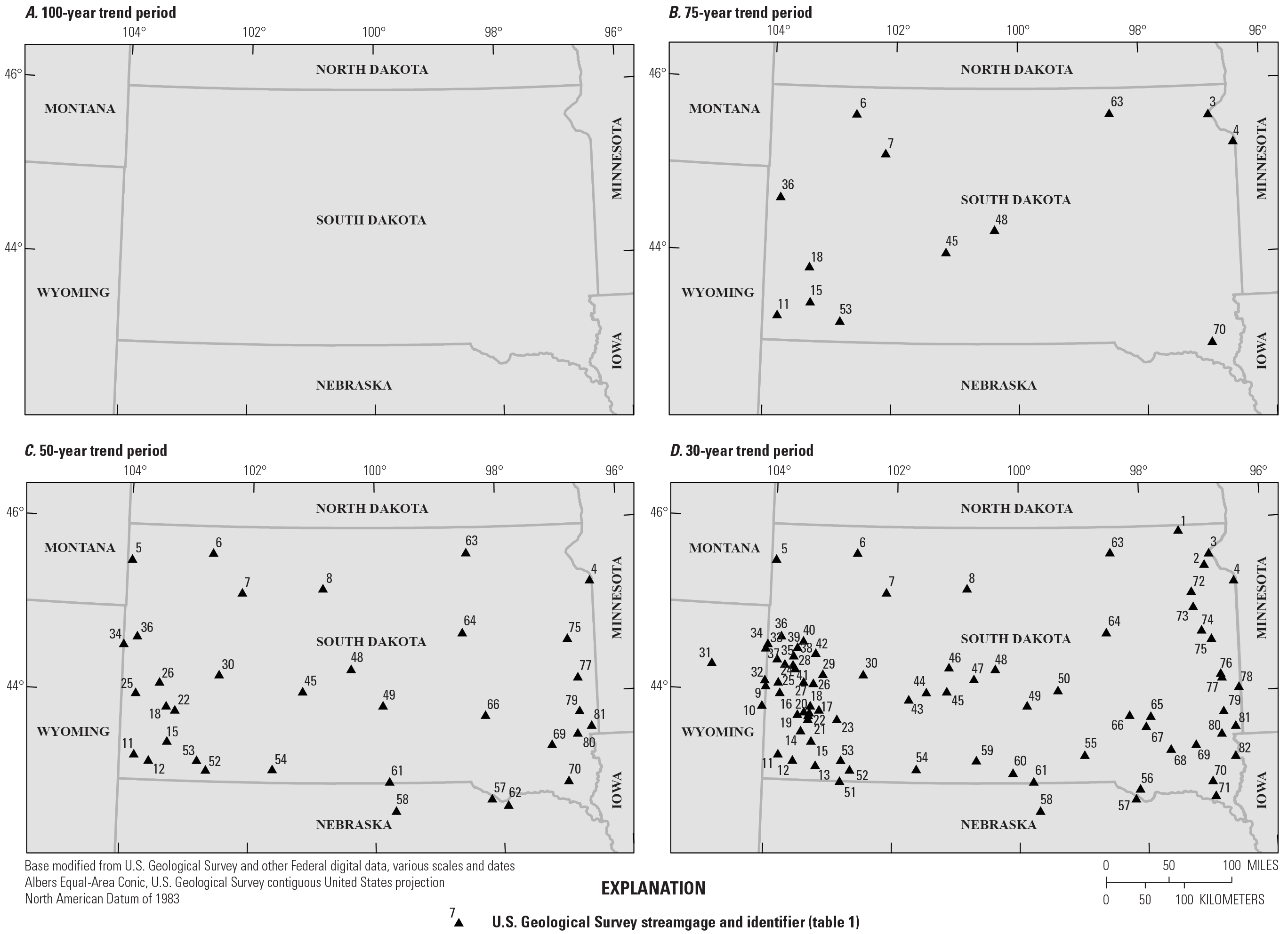
Maps showing spatial location of qualifying U.S. Geological Survey streamgages in South Dakota for the (A) 100-, (B) 75-, (C) 50-, and (D) 30-year trend periods and their corresponding identifiers.
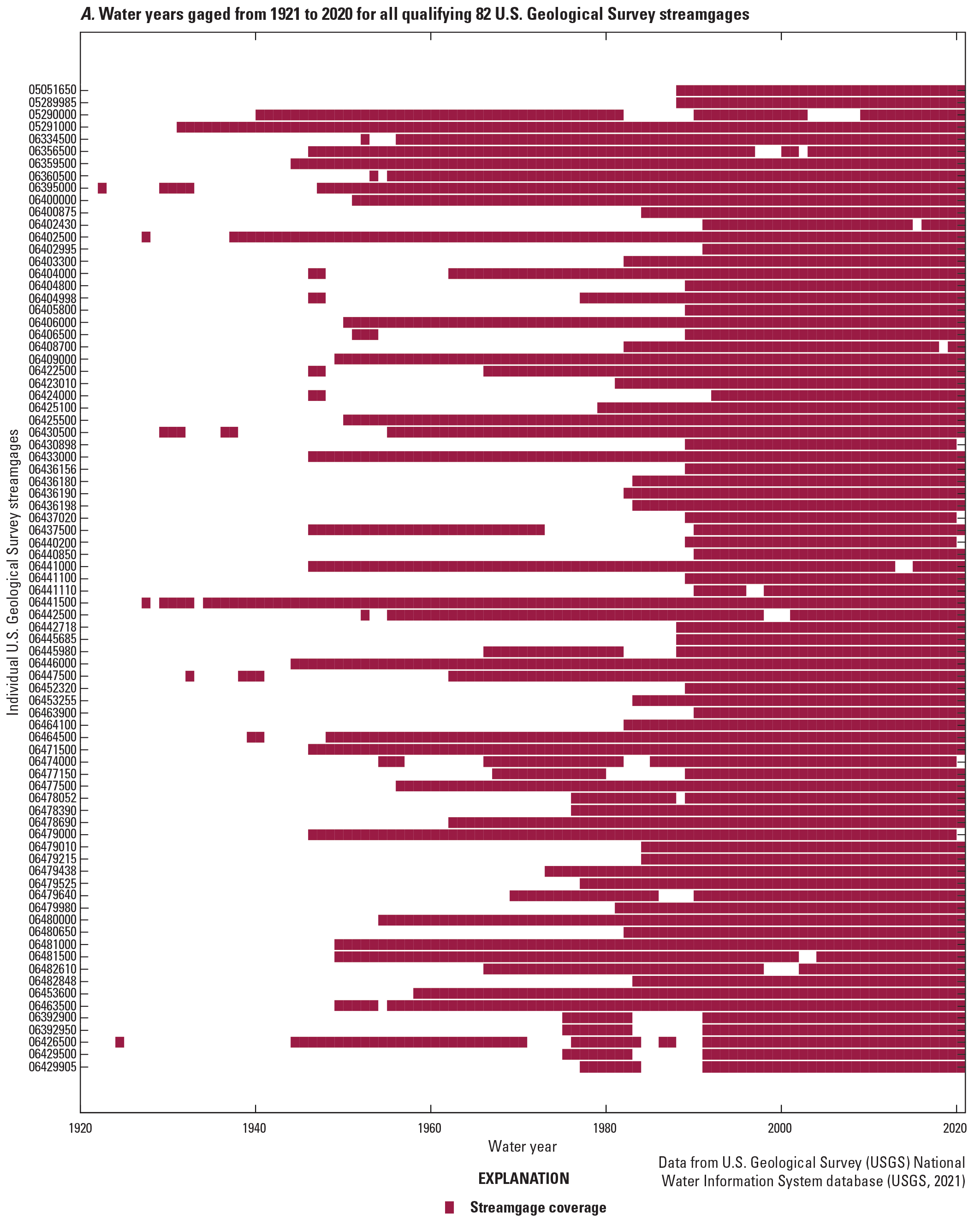
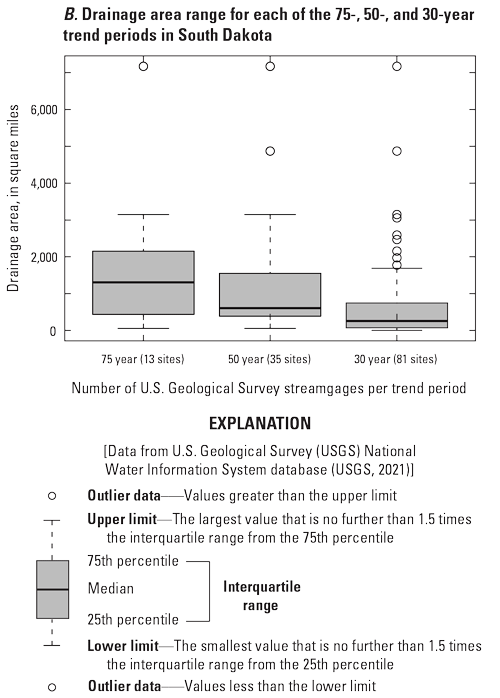
Graph and boxplot showing (A) water years gaged from 1921 to 2020 for the 82 total qualifying U.S. Geological Survey streamgages and (B) drainage area range for each of the 75-, 50-, and 30-year trend periods in South Dakota. [A water year is the 12-month period from October 1 to September 30 and is designated by the year in which it ends]
Three streamgages with long-term records were chosen to illustrate the results of stationarity tests for (a) autocorrelation, (b) monotonic trends, (c) change points, and (d) peak-flow timing for the 50-year record (1) West Fork Vermillion River near Parker, S. Dak. (station 06478690; site SD69 in fig. 10C), and (2) Skunk Creek at Sioux Falls, S. Dak. (station 06481500; site SD80 in fig. 10C), and the 75-year record (3) Cheyenne River at Edgemont, S. Dak. (station 06395000; site SD11 in fig. 10B) (U.S. Geological Survey, 2021).
Annual Peak Streamflow Stationarity Example 1—West Fork Vermillion River near Parker, South Dakota
Station 06478690 (SD69; U.S. Geological Survey, 2021) has a total drainage area of 378 mi2 and is in the far eastern part of South Dakota where the annual peak streamflows may be strongly affected by antecedent soil moisture from longer term climatic persistence and tend to be highly correlated (Sando and others, 2008). The rank von Neumann test indicates significant autocorrelation at lag 1 (p-value of 0.031; fig. 12A), and a monotonic trend of 29.8 ft3/s per WY (p-value of 0.002) was detected (fig. 12B), corresponding to a normalized trend of 2.51 percent per WY (Marti and others, 2024). The normalized trend (in percent per year) represents the Theil-Sen slope (in cubic feet per second per year) normalized by the median (in cubic feet per second) for the respective trend period. A statistically significant (p-value less than [<] 0.05) change point was detected in the median and the scale in the annual peak-flow magnitudes in 1992 (fig. 12C). Significant upward monotonic trends in the peak-flow timing of all annual peaks in the period of record were detected for the complete time series, indicating an overall later timing in annual peaks (fig. 12D). Furthermore, a statistically significant upward monotonic trend in the timing of earlier annual peaks (likely snowmelt) was also detected (fig. 12D).The upward monotonic trend in the peak-flow magnitudes, detection of change points in the median and scale (variability) of the data in 1992, and an upward trend in the peak-flow timing indicate potential violations in the iid assumptions for a typical Bulletin 17C peak-flow FFA. These potential violations for doing an at-site peak-flow FFA warrant additional investigation into likely attributions for these stationarity violations.
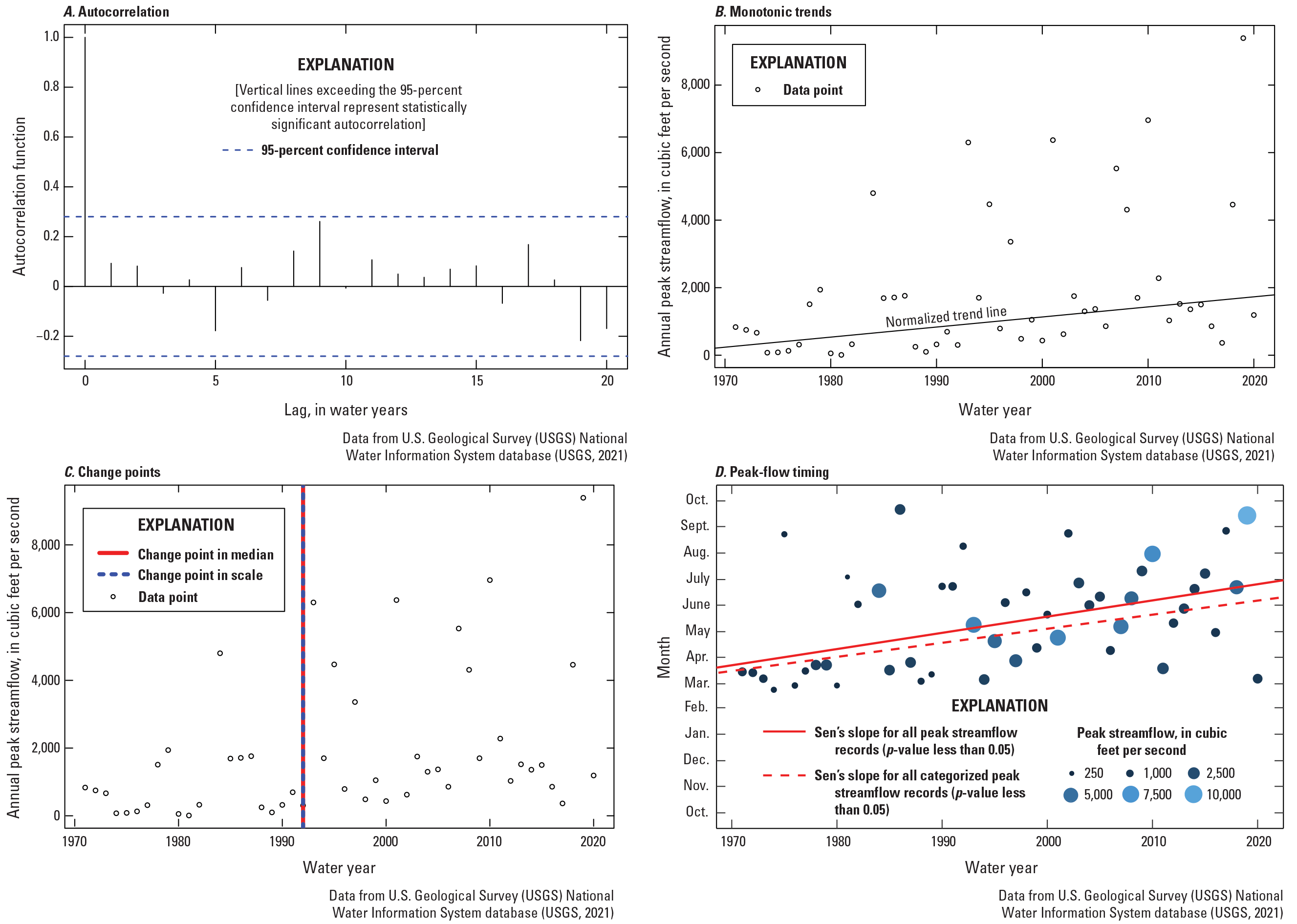
Graphs showing results of stationarity tests for (A) autocorrelation, (B) monotonic trends, (C) change points, and (D) peak-flow timing for the 50-year record for the U.S. Geological Survey streamgage West Fork Vermillion River near Parker, South Dakota (station 06478690; site SD69 in fig. 10C).
Annual Peak Streamflow Stationarity Example 2—Skunk Creek at Sioux Falls, South Dakota
Station 06481500 (SD80; U.S. Geological Survey, 2021) has a total drainage area of 620 mi2 and is also in the far eastern part of South Dakota. The rank von Neumann test indicates significant autocorrelation at lag 1 (p-value of 0.069; fig. 13A) and a monotonic trend of 31.5 ft3/s per WY (p-value of 0.039) was detected (fig. 13B), corresponding to a normalized trend of 1.7 percent per WY (Marti and others, 2024). The normalized trend (in percent per year) represents the Theil-Sen slope (in cubic feet per second per year) normalized by the median (in cubic feet per second) for the respective trend period. No statistically significant change points were detected in either the median or scale of the annual peak streamflow and thus are not shown in figure 13A–C. Significant upward monotonic trends in the peak-flow timing of all annual peaks in the period of record were also detected for the complete time series, indicating an overall later timing in the occurrence in annual peaks (fig. 13C). Similar to site 06478690 (SD69; U.S. Geological Survey, 2021), these two sites in the far eastern part of the State illustrate consistent violations in the iid assumption, have monotonic trends resulting in annual peak streamflow magnitudes that are substantially and consistently increasing, and have peak-flow timing that arrives later in the WY over the 50-year trend period. However, the potential effects from urbanization need further investigation at station 06481500 (SD80).
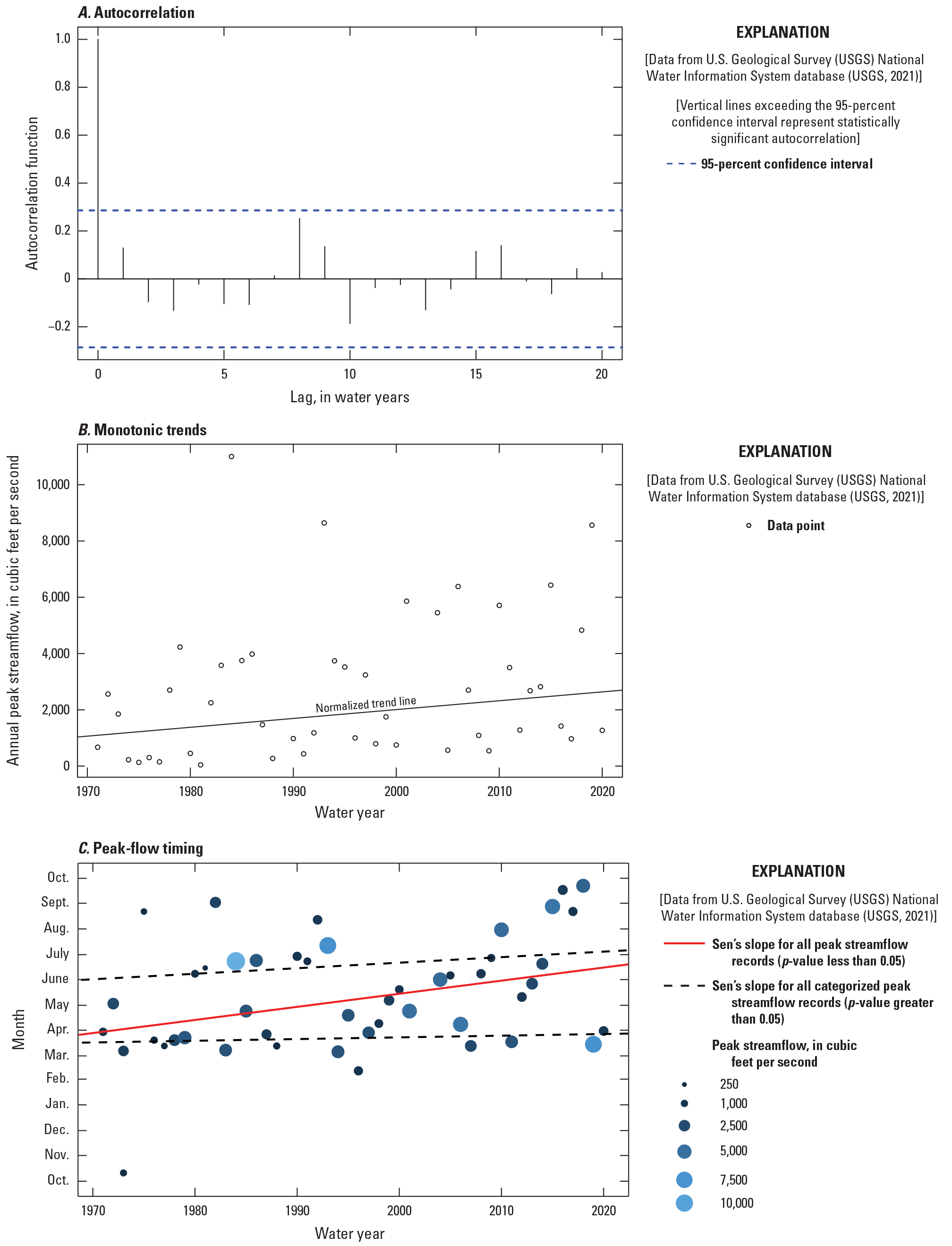
Graphs showing results of stationarity tests for (A) autocorrelation, (B) monotonic trends, and (C) annual peak-flow timing for the 50-year record for the Skunk Creek at Sioux Falls, South Dakota (station 06481500; site SD80 in fig. 10C).
Annual Peak Streamflow Stationarity Example 3—Cheyenne River at Edgemont, South Dakota
Station 06395000 (SD11; U.S. Geological Survey, 2021) has a markedly larger drainage area of 7,171 mi2 compared to the previous two eastern sites, 06478690 (SD69; U.S. Geological Survey, 2021) and 06481500 (SD80; U.S. Geological Survey, 2021) and is in the far southwestern part of South Dakota. Site 06395000 is representative of the western part of South Dakota, outside of the Black Hills, where a more consistent decrease in annual peak streamflow magnitude in the 75- and 50-year trend periods is detected. The rank von Neumann test indicates no significant autocorrelation is detected at lag 1 (p-value of 0.643; fig. 14A). However, a monotonic trend of −33 ft3/s per WY (p-value of 0.001) was detected (fig. 14B), corresponding to a normalized trend of −1.63 percent per WY (Marti and others, 2024). Change points were detected in the median and scale of the annual peak streamflow (both p-values <0.05; fig. 14C). Unlike the consistent change points that were detected in the median and scale in 1992 for site 06478690 (SD69; U.S. Geological Survey, 2021), change points in the median and scale were detected in 1982 and 1978, respectively. The two change-point dates are likely a function of the large peak of record that was detected in 1978. If the 1978 peak was not as large in magnitude compared to the rest of the peak-flow data, both change points likely would have been in 1978. Additionally, unlike the two eastern streamgages, which indicate a consistently later peak-flow timing, site 06395000 indicates a significantly earlier peak-flow timing (fig. 14D). These three streamgages provide several lines of evidence of site-specific potential stationarity violations for doing peak-flow FFAs and are illustrative examples of temporal and spatial hydroclimatic variability in South Dakota.
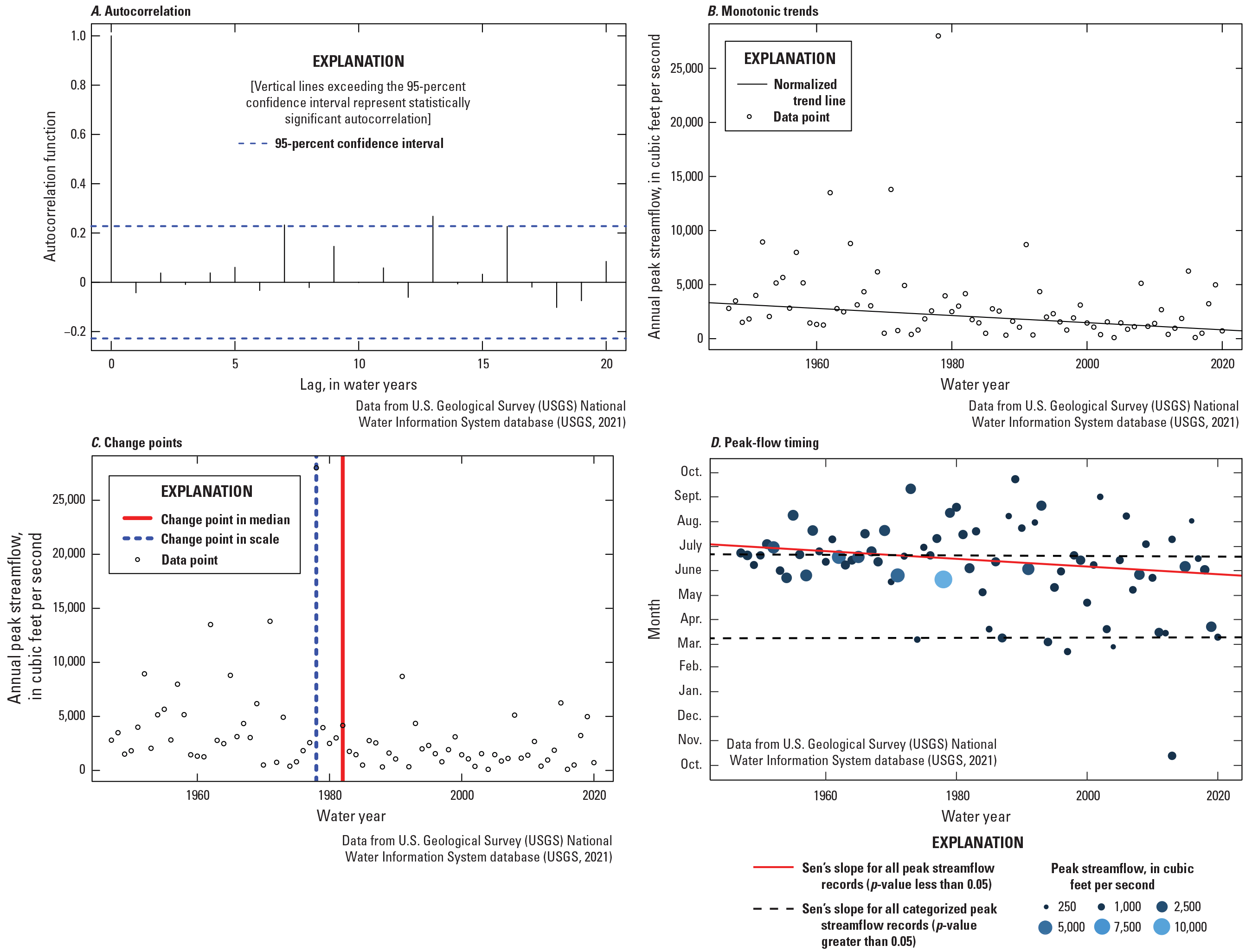
Graphs showing results of stationarity tests for (A) autocorrelation, (B) monotonic trends, (C) change points, and (D) peak-flow timing for the 75-year record for the Cheyenne River at Edgemont, South Dakota (station 06395000; site SD11 in fig. 10B).
Autocorrelation
The violation of the iid assumption (autocorrelation or serial correlation) has an effect on the statistical significance of the test results because the effective sample size is smaller than the number of observations. A positive correlation exists when two variables operate in unison, such that as one variable rises, the other variable does the same. Conversely, negative correlation is when two variables move in opposite directions, such that as one rises, the other falls. Cox and Stuart (1955 [p. 16]) stated, “… positive serial correlation among the observations would increase the chance of [a] significant answer even in the absence of a trend.” Different techniques have been proposed to accommodate the potential presence of autocorrelation including prewhitening and trend-free prewhitening (Kulkarni and von Storch, 1995; Yue and others, 2003). In the 75-year trend period, 4 of the 13 long-term streamgages (31 percent) indicated likely upward and downward autocorrelation (table 4); all of these streamgages are in the central and western parts of the State (table 4). Of the 35 streamgages, 20 (57 percent) in the 50-year trend period indicated likely upward and downward autocorrelation and are equally dispersed throughout the State (table 4). Similarly, 41 (51 percent) of the 81 streamgages indicated likely upward and downward autocorrelations in the 30-year trend period and are equally dispersed throughout the State (table 4). Because the direction of autocorrelation is not reported, it is difficult to infer if spatial patterns are in the iid assumption when a positive correlation is detected, yet a positive lag-1 autocorrelation is more likely for annual peak-flow data than a negative autocorrelation (an increase in peak-flow magnitude followed the next year by a decrease and then back to an increase). Therefore, when doing at-site peak-flow FFAs among those sites with likely upward and downward autocorrelation, the direction can further be evaluated for potential violations to the stationarity assumptions among the other statistical tests described in the subsequent sections.
Table 4.
Results of autocorrelation based on the rank von Neumann test for lag-1 autocorrelation for qualifying streamgages in the 75-, 50-, and 30-year trend periods in South Dakota.[A water year is the 12-month period from October 1 to September 30 and is designated by the year in which it ends. Likely upward/downward (1.0 to 0.85); somewhat likely upward/downward (0.85 to 0.70); about as likely as not (less than 0.70)]
Monotonic Trends
If the rank von Neumann test for lag-1 autocorrelation was rejected at a p-value less than 0.05, the monotonic trend was modified using a Mann-Kendall test for trends that first detrends the series and then uses the estimated lag-1 autocorrelation coefficient of the detrended series to remove, or prewhiten, the serial correlation; the estimated trend is then added back, and the Mann-Kendall Trend test is applied (Yue and Wang, 2002; Önöz and Bayazit, 2012). If the test for autocorrelation was not rejected, the Mann-Kendall test was used on the annual peak-flow record. In the 75-year trend period, 5 of the 13 streamgages (38 percent) had likely upward and (or) downward monotonic trends over the trend period (table 5). Three were likely upward and two were downward and spatially clustered together in the eastern and western parts of the State, respectively (fig. 15). In the eastern part of the State, stations 05291000 (SD4), 06471500 (SD63), and 06479000 (SD70) all had likely upward monotonic trends, and stations 06395000 (SD11; fig. 14A) and 06402500 (SD15) in the southwestern part of the State had likely downward monotonic trends. Although only 13 streamgages qualified for the 75-year trend period, a fairly consistent pattern of increasing peak-flow magnitudes was detected in the eastern part of the State and decreasing peak-flow magnitudes in the western part of the State (table 5). In the 50-year trend period, 10 of the 35 streamgages (29 percent) had likely upward and (or) downward monotonic trends. Nine of those streamgages were likely upward and one was likely downward (table 5, fig. 15). Similar to the 75-year trend period, likely upward trends and larger normalized trends were consistently detected in the eastern part of the State (fig. 15), whereas one longer term streamgage in the southwestern part of the State (station 06395000; SD11) remained likely downward in this trend period. Four of the five streamgages with detected monotonic trends in the 75-year trend period also had detected monotonic trends in the 50-year period (stations 05291000 [SD4], 06395000 [SD11], 06471500 [SD63], and 06479000 [SD70]). In the 30-year period, 17 of the 81 (21 percent) qualifying streamgages had detected upward and (or) downward monotonic trends (fig. 15). However, the overall spatial patterns of likely upward and (or) downward trends in the most recent 30 years are largely inconsistent with the 75- and 50-year trend periods, especially among the temporally consistent upward trends in the eastern part of the State. For this reason, additional discussions of the monotonic trend results in this section focus on the 75- and 50-year trend periods.
Table 5.
Results of monotonic trends for qualifying streamgages in the 75-, 50-, and 30-year trend periods in South Dakota.[A water year is the 12-month period from October 1 to September 30 and is designated by the year in which it ends. Likely upward/downward (1.0 to 0.85); somewhat likely upward/downward (0.85 to 0.70); about as likely as not (less than 0.70)]
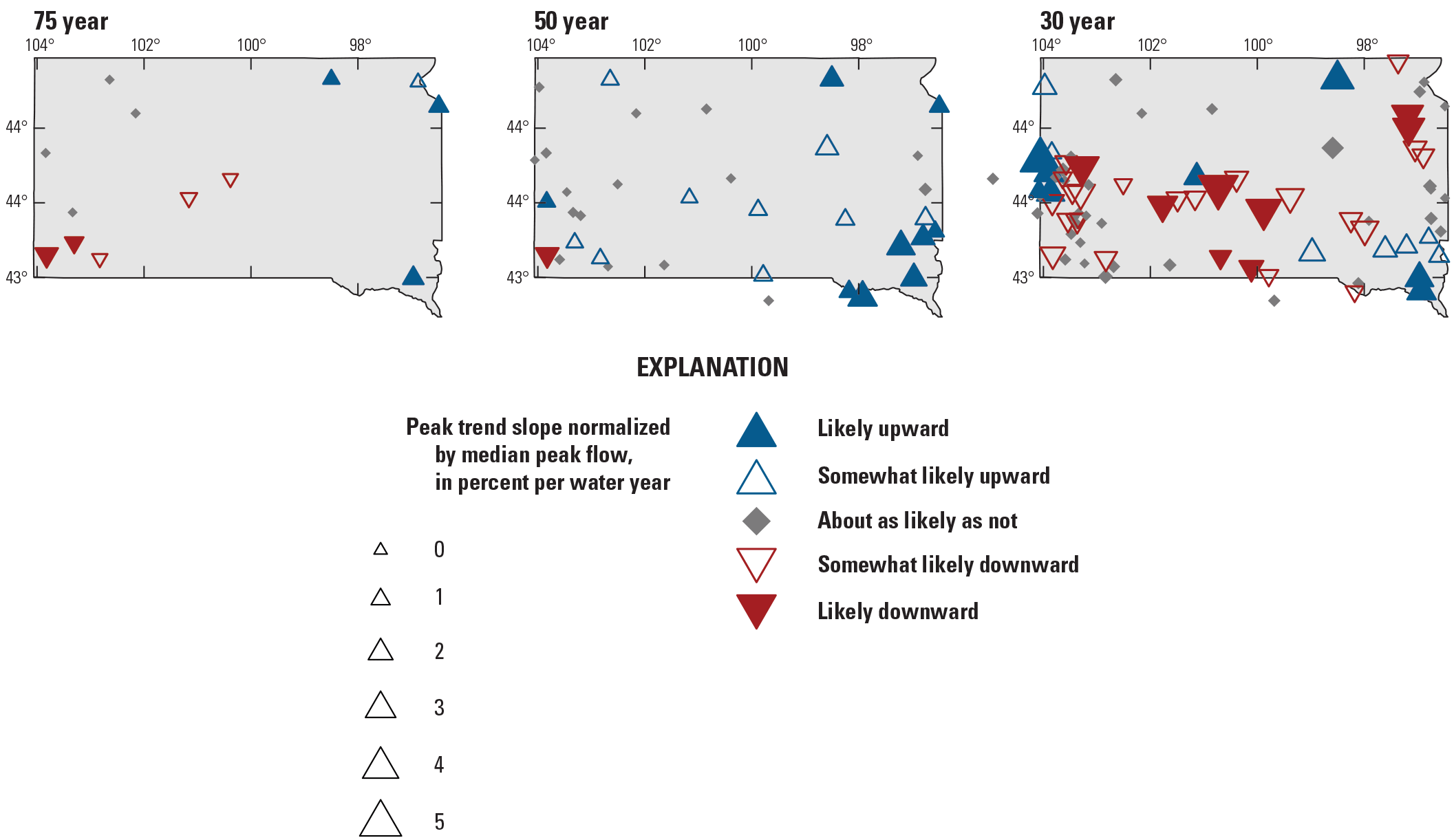
Maps showing likelihood and magnitude results of monotonic trends for qualifying streamgages in the 75-, 50-, and 30-year trend periods in South Dakota. The magnitude of the monotonic peak-flow trend is normalized by the median annual peak streamflow for the respective trend period and represents a percentage change per water year. [A water year is the 12-month period from October 1 to September 30 and is designated by the year in which it ends]
The magnitude of changes in detected monotonic trends in the 75- and 50-year trend periods may be further evaluated by examining not only the normalized trend magnitudes but also the relative changes in annual peak-flow magnitudes. In the 75-year and 50-year trend periods, the median normalized trend for all 13 and 35 qualifying streamgages is near zero, which as expected, represents no monotonic trends on average. However, the median normalized trend for the 5 and 10 streamgages with likely upward and (or) downward trends is 1.60 and 1.65 for the 75- and 50-year trend periods, respectively (fig. 16A–C) . The maximum normalized trend among the 5 and 10 streamgages is 2.60 (06479000, SD70) and 2.69 (06478690, SD69) for the 75- and 50-year trend periods, respectively, whereas the minimum in both trend periods is −1.11 (station 06395000, SD11). Stations 06479000 (SD70) and 06478690 (SD69; fig. 12A–D) are in the southeastern part of the State, whereas station 06395000 (SD11; fig. 14A–D) is in the southwestern part of the State. These changes in normalized peak-flow magnitude for the respective trend periods are substantially larger or smaller compared to all qualifying streamgages (fig. 16A, C).
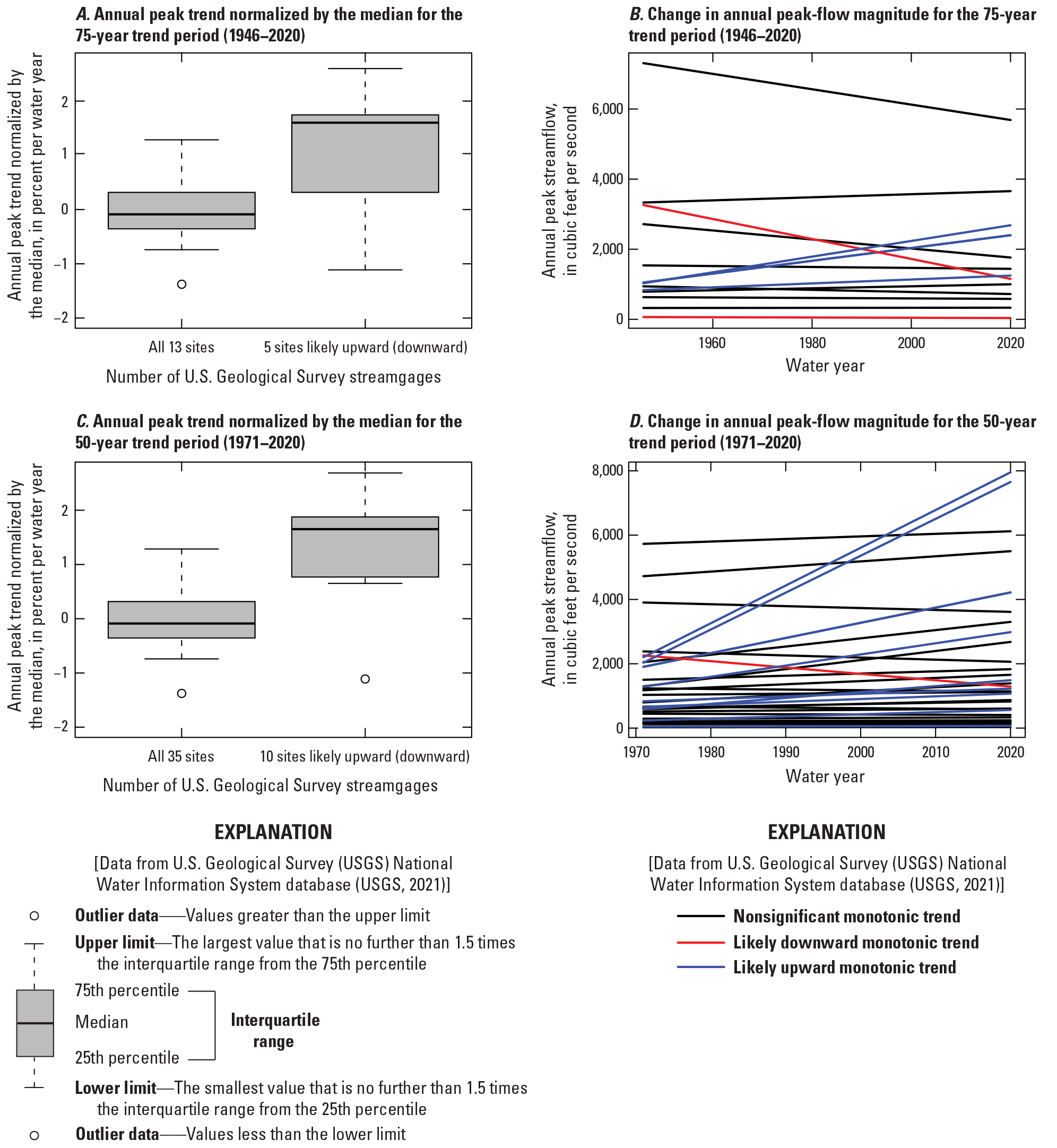
Graphs showing the magnitude of monotonic peak-flow trends normalized by the median annual peak streamflow (in percent per water year) for qualifying streamgages in the 75- and 50-year trend periods (A and C, respectively) and the corresponding change in annual peak-flow magnitudes over the trend periods (B and D, respectively). The trend lines in B and D represent the likely upward and (or) downward monotonic trend results. [A water year is the 12-month period from October 1 to September 30 and is designated by the year in which it ends]
Two points were used to determine the change in normalized trend magnitude per trend period. The first point is the intercept of the Theil-Sen slope in the first year of the trend period, 1946 and 1971, for the 75- and 50-year trend periods, respectively. The second point is the peak-flow magnitude at the end of the trend period (WY 2020) and was calculated using equation 1:
whereQn
is the peak-streamflow (in cubic feet per second) at the end of the trend period (n),
Q0
is the intercept of the Theil-Sen line (in cubic feet per second),
rn
is the normalized magnitude of the Theil-Sen slope (in percent change per water year), and
n
is the number of WYs in the 75- and 50-year trend periods.
The black lines in figure 16B and D are those streamgages with somewhat likely upward and (or) downward and about as likely as not trend results that, as expected, have near-zero slopes. However, the blue and red lines represent the 5 and 10 streamgages for the 75- and 50-year trend periods, respectively, with likely upward and (or) downward monotonic trends and illustrate the importance of the relative changes in annual peak magnitude over the trend periods. In the 50-year trend period, stations 06479000 (SD70) and 06478690 (SD69) have notably larger peak-flow magnitude trends (blue lines in figure 16D) compared to the overall trends for the remaining 35 qualifying streamgages.
Change Points
Change-point analysis of peak streamflow data in South Dakota for the 75- and 50-year trend periods indicates a spatially consistent east versus west likely upward and (or) downward pattern in the median of the annual peak streamflows, and a fairly consistent change point was detected in the 1980s and 1992–93. As described in chapter A (Ryberg and others, 2024), the Pettitt test is a nonparametric method that finds a single change point in the distribution of a series (Pettitt, 1979; Pohlert, 2020) and reports a p-value for a determination of statistical significance. The Mood test is another nonparametric change-point method that finds a single abrupt change in the scale, or spread, of a series (Mood, 1954). The implementation of the test used in this study is from the R package cpm (Ross, 2015, 2020). Based on the default settings of the function used for the Mood test, the change points returned have a p-value less than 0.05. Because the results of the change points in scale are only identified if the null hypothesis (H0) is rejected at a p-value less than 0.05, the use of the likelihood approach for this analysis is inconsistent with the results for the other statistical tests. Thus, the results for change points in the median of the annual peak streamflow are discussed in this section, and the results for the median and scale are provided in the data release (Marti and others, 2024). However, change points in scale (variability) can also be evaluated for potential stationarity violations, especially in the context of considering changes in the moments (mean, standard deviation, and skewness) and their effects on the quantile estimates in peak-flow FFA.
In the 75-year trend period, of the 13 streamgages, the same 5 that had likely upward and (or) downward change points (38 percent) in this trend period are the same streamgages that had the same likelihood direction detected for monotonic trends (fig. 17). In the eastern part of the State, stations 05291000 (SD4), 06471500 (SD63), and 06479000 (SD70) all had likely upward change points that were detected in 1981, 1993, and 1992, respectively. The two likely downward streamgages had detected change points in 1982 (station 06395000; SD11) and 1979 (station 06402500; SD15). A likely reason the detected change points are separated by a few years is the unusually large peak of record in WY 1978 at station 06395000, which may have affected the median (fig. 14B). Furthermore, both of these stations also had detected change points in scale in 1977 and 1978, respectively. An important consideration when evaluating potential stationarity violations because of detected change points in the median and monotonic trends is there is a much stronger likelihood of identifying a monotonic trend when a change point is detected, yet the opposite may not necessarily occur. The possible effects of detecting monotonic trends and change points in the context of addressing potential nonstationarity is further discussed in the “Study Limitations” section.
In the 50-year trend period, a more consistent spatial pattern of likely upward change points in the median was detected among the 35 qualifying streamgages. Of the nine streamgages (26 percent) with a detected likely upward change point, eight are in the eastern part of the State (fig. 17). None of the 35 qualifying streamgages had detected likely downward change points in the 50-year trend period. Four streamgages (stations 06409000 [SD25], 06471500 [SD63], 06478690 [SD69; fig. 12C], and 0647900 [SD70]) all had detected change points in 1992 and 1993. Three of these four streamgages are in the eastern part of the State and 06409000 (SD25) is in the far western part of the State. Two stations (06442500 [SD49] and 06481500 [SD80]) in the central and eastern parts of the State had change points detected in 1981. Between these two stations, stations 06477500 (SD66) and 06474000 (SD64) had detected change points in 1983 and 1988. Similar to the 75-year trend period, there seems to be a consistent change point detected around 1992 and 1993 in the 50-year period and there seems to be a change point in the 1980s that may be more consistent with detected change points in North Dakota and eastern Montana (Marti and others, 2024). Although the long-term USGS streamgage James River at Scotland, S. Dak. (station 06478500; U.S. Geological Survey, 2021), was not included in this study because of the unusually high dam disturbance index, which was used as a site selection criterion in the regional study, a change point was detected in the median in 1981. Station 06478500 was one of two streamgages that were identified as an example for hydroclimatic variability in the study area that motivated this multistate study. Thus, there seems to be a consistent spatial and temporal pattern of change points detected in the median annual peak-flow data series in the 1980s and early 1990s. Further examination of regional patterns in North Dakota and Montana may provide a stronger signal of hydroclimatic shifts beyond South Dakota (Marti and others, 2024).
Beyond the tabular results of detected change points (table 6) and the temporal and spatial likelihood patterns (fig. 17) in the median, evaluating the differences in the median peak-flow magnitude before (Q1) and after (Q2) the detected change points may also be informative. Negative differences arise if the median before the detected change point is larger than after the change point. Conversely, positive differences arise if the median streamflow after the change point is larger than before the change point. The median difference for the 13 and 35 streamgages in the 75- and 50-year trend periods are −178 ft3/s and +526 ft3/s, respectively (left-hand boxplots in fig. 18A, B). Differences among the minimums, medians, and maximums are notable among the five and nine streamgages with likely upward and (or) downward change points for the 75- and 50-year trend periods, respectively (right-hand plots in fig. 18A, B). The minimum difference in the change points for the 75-year trend period is −1,550 ft3/s (station 06395000; SD11) in the southwestern part of the State, the median is +1,155 ft3/s and the maximum is +1,990 ft3/s (station 05291000; SD4) in the far eastern part of the State. Because all nine detected change points in the 50-year trend period are likely upward, the minimum is +41 ft3/s (station 06409000; SD25) in the western part of the State, the median is +1,005 ft3/s, and the maximum is +3,490 ft3/s (station 06466500; SD62) in the southeastern part of the State. These relatively large differences in median magnitudes before and after the detected change points, especially among the likely upward and (or) downward streamgages, highlight potential differences in peak-flow FFA estimates with respect to the first moment—the mean. These results also further highlight the potential challenges for those streamgages that have monotonic trends and change points.
Table 6.
Results of change points in the median of annual peak streamflow for qualifying streamgages in the 75-, 50-, and 30-year trend periods in South Dakota.[A water year is the 12-month period from October 1 to September 30 and is designated by the year in which it ends. Likely upward/downward (1.0 to 0.85); somewhat likely upward/downward (0.85 to 0.70); about as likely as not (less than 0.70)]
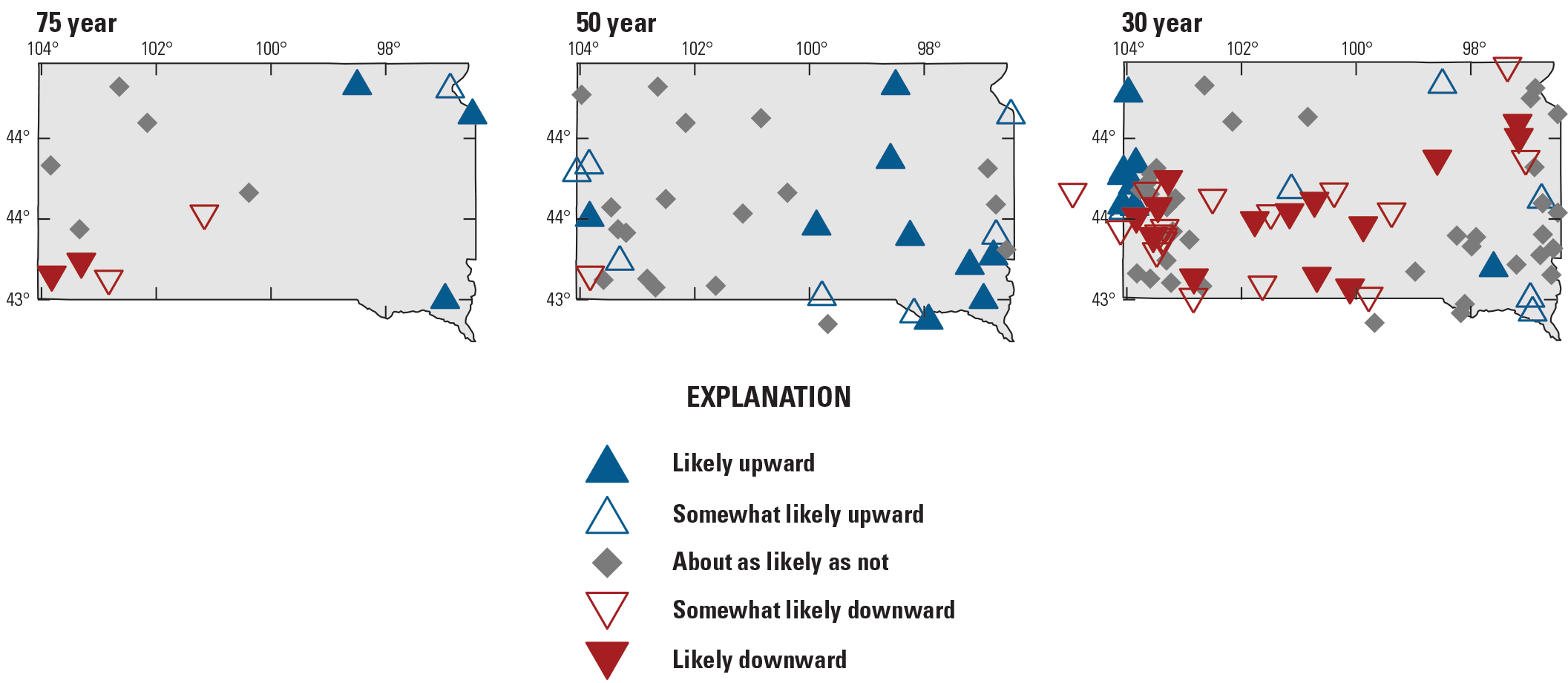
Maps showing likelihood results of change points in the median of annual peak streamflow for qualifying streamgages in the 75-, 50-, and 30-year trend periods in South Dakota.
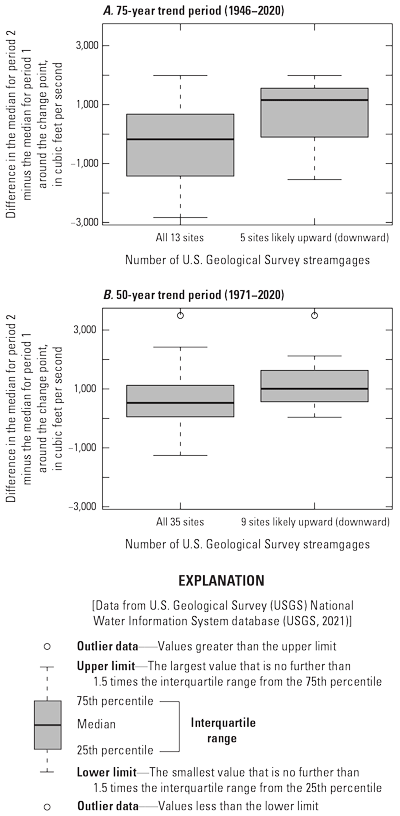
Boxplots showing the difference in the median peak streamflow before and after the detected change point (the median for period 2 minus the median for period 1; in cubic feet per second) for the (A) 75- and (B) 50-year trend periods for all qualifying streamgages (left boxplot) and among the detected likely upward and (or) downward streamgages (right boxplot).
Finally, a spatially consistent east versus west likely upward and (or) downward pattern was observed in monotonic trends and change points in the median, and a fairly consistent change point was detected in the 1980s and 1992–93. Thus, the change-point results in the 30-year period seem to be in contrast to the 75- and 50-year trend periods as was similarly detected in the monotonic trend results for the 30-year trend period. In the 30-year trend period, 10 percent of the streamgages with likely upward change points are predominately on the far western part of the State, and 14 (17 percent) of the streamgages are likely downward and are throughout the State (fig. 17). These results also seem to contrast the findings among the three long-term stationarity example streamgages (figs. 12A–D, 13A–C, and 14A–D). The likely reason for this inconsistency in the 30-year period is the trend period begins in 1991; thus, for the longer-term sites in the 75- and 50-year trend periods, 1991 is past the detected change point in the 1980s or is straddling the more commonly detected change point in 1992–93. Similar to other statistical tests, the validity of the results can be sensitive to the time period used and (or) when high or low values are detected at the beginning or end of the time series.
Peak-Flow Timing Analysis
In the previous sections, the results of potential stationarity violations (nonstationarity) for doing at-site peak-flow FFAs are presented for autocorrelation (iid assumption), monotonic trends, and change points in the median and scale throughout the State. Based on the consistent results of detected temporal and spatial nonstationarities in South Dakota among the 75- and 50-year trend periods, there is a need to evaluate candidate attributions for these likely stationarity violations to changes in hydroclimatic variability. Changes in the peak-flow timing, the day of the year occurrence of the annual peak streamflow, represent a potential change in seasonality of flood-generating mechanisms. In South Dakota, annual peak streamflows that occur earlier in the WY are more commonly snowmelt generated, whereas peaks that occur later in the WY are rainfall generated. Changes in peak-flow timing, among other streamflow metrics, may lead to changes in peak-flow magnitudes in the presence of flood rich and flood poor periods. A monotonic trend analysis was used to evaluate changes in the peak-streamflow timing for the day of the WY for all peaks (complete record) and early and (or) late periods of the WY, when applicable. The Theil-Sen slopes from the monotonic trend analysis represent changes in the day of occurrence per WY.
In the 75-year trend period, 8 of the 13 qualifying streamgages (61 percent) collectively indicated likely upward and (or) downward trends in the timing of the day of the WY for the complete record corresponding to later and (or) earlier peak-flow timing (table 7). Two streamgages with likely upward, later timing were detected in the eastern part of the State and six streamgages with likely downward, earlier peak-flow timing were detected in the western part of the State (fig. 19). In the 50-year period, spatial homogeneity of detected changes in the annual peak-flow timing was stronger among the 35 qualifying streamgages. Of the 35 qualifying streamgages, 16 (45 percent) collectively indicated likely upward and (or) downward trends. Eleven streamgages (31 percent) with likely upward, later peak-flow timing were collectively detected in the eastern part of the State and five streamgages (14 percent) with detected likely downward, earlier peak-flow timing were in the far southwestern part of the State. In the 30-year period, there seems to be a relatively similar east-west pattern in likely upward and (or) downward peak-flow timing trends (fig. 19). Furthermore, similar to the description of the results in the monotonic trends and change-point sections, the results in the 30-year trend period seem inconsistent with the more homogenous east-west spatial patterns detected in the longer term 75- and 50-year trend periods.
Table 7.
Results of peak-flow timing analysis of annual peak streamflow for qualifying streamgages in the 75-, 50-, and 30-year trend periods in South Dakota.[A water year is the 12-month period from October 1 to September 30 and is designated by the year in which it ends. Likely upward/downward (1.0 to 0.85); somewhat likely upward/downward (0.85 to 0.70); about as likely as not (less than 0.70). NA, not applicable]
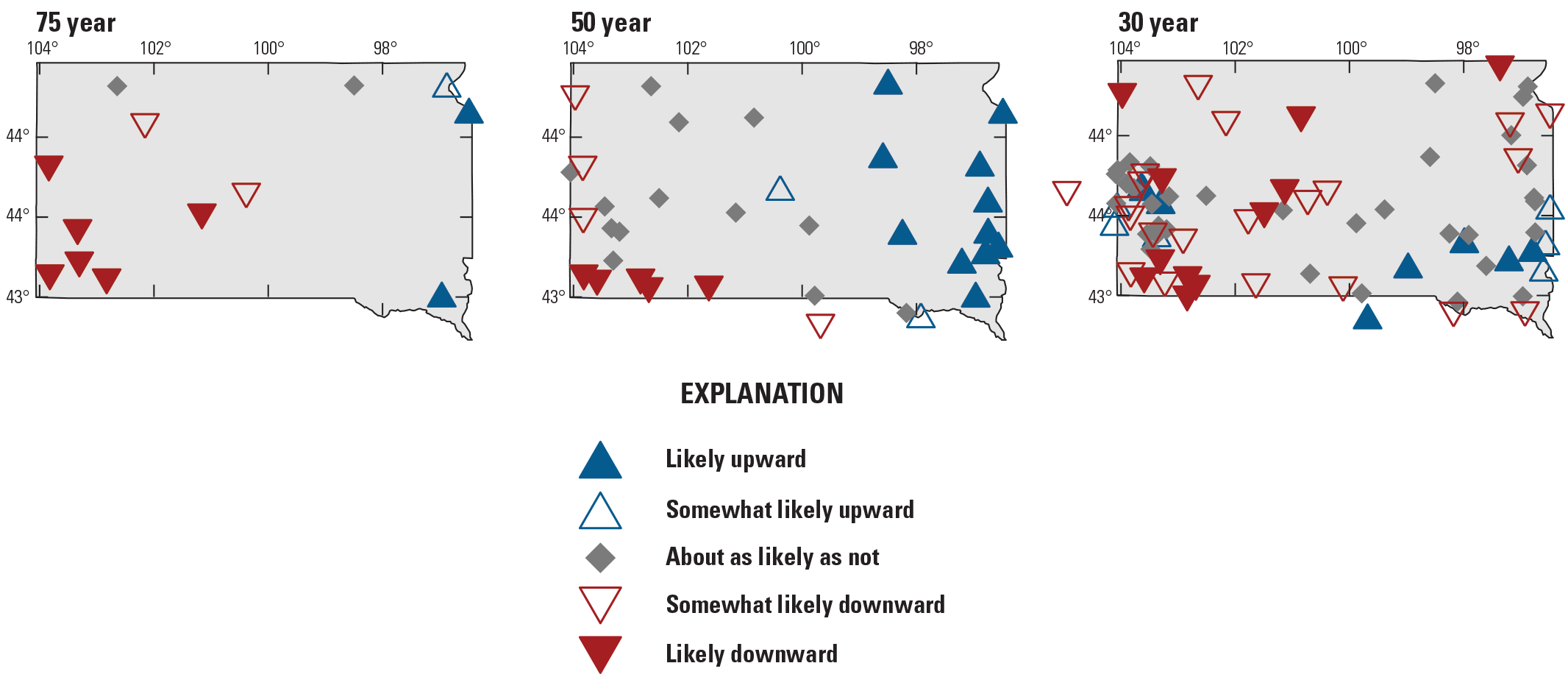
Maps showing likelihood results of the peak-flow timing analysis of annual peak streamflow for the complete water year for qualifying streamgages in the 75-, 50-, and 30-year trend periods in South Dakota. Upward and downward directions correspond to later and earlier annual peak-flow timing, respectively. [A water year is the 12-month period from October 1 to September 30 and is designated by the year in which it ends]
Lastly, when solely interpreting the Theil-Sen slope magnitude for the peak-flow timing results (Marti and others, 2024) caution is needed. The day of the year peak-flow timing of annual peak streamflow time series has a continuous periodicity of occurrence from one year to the next. Separating the day of occurrence solely based on WY to evaluate linear changes over time may lead to some spuriously large changes between the beginning and ending years over a trend period. The peak-flow timing results of later or earlier arrival dates are indeed informative and can be used for additional lines of evidence to attribute likely stationarity violations to changes in hydroclimatic variability, yet caution is needed. Future analyses can be completed to evaluate changes in peak-flow timing (seasonality) by means of circular statistics, for example, which is well suited for continuous periodic time series data (Villarini, 2016).
Daily Streamflow
Examining daily mean streamflow (daily streamflow), particularly the higher end of the streamflow regime, may help in understanding the processes driving the observed changes in annual peak streamflow. Some streamgages in the 75-, 50-, and 30-year trend periods used for annual peak streamflow analysis, such as CSGs, do not have daily streamflow and do not qualify for the daily streamflow analyses. All 13 streamgages in the 75-year trend period have daily streamgage data, and 5 (14 percent) and 28 (35 percent) of the 35 and 81 streamgages in the 50- and 30-year trend periods, respectively, do not have daily streamflow available. Herein, data from the same three long-term USGS streamgages that were described in the annual peak streamflow results (stations 06478690 [SD69], 06481500 [SD80], and 06395000 [SD11]) are used to illustrate the additional potential stationarity violations (nonstationarity) in the higher streamflow regime in South Dakota. Similar to the annual peak streamflow results, these streamgages typify similar violations detected among other streamgages in the respective trend periods and among surrounding sites. Next, the overall results of temporal hydroclimatic shifts in POT are presented for the 75-, 50-, and 30-year trend periods for all qualifying streamgages throughout the State.
Daily Streamflow Stationarity Example 1—West Fork Vermillion River near Parker, South Dakota
The raster-seasonality plot, the peaks-over-threshold (POT) analysis where, on average, there are two events per year (POT2) partial-duration time series plot, and the results of a change-point analysis in the frequency (counts) of POT2 for the 50-year daily streamflow record for the USGS streamgage West Fork Vermillion River near Parker, S. Dak. (station 06478690; site SD69 in fig. 10C), are shown in figure 20A–C. The horizontal line in figure 20A demarks the detected change points in the median and scale in 1992 for the annual peak streamflow (fig. 12C). Before 1992, more prolonged periods of drier, lower daily streamflow were detected throughout much of the WY, and the larger daily streamflows were more commonly detected in March through May. The timing (seasonality) of the maximum annual daily streamflow is likely associated with springtime snowmelt in these months. After 1992, the median and higher daily streamflows, green and blue colors, respectively, were more commonly detected throughout the WY. After the detected 1992 change point, the results indicate more prolonged periods throughout the WY with higher flows likely leading to higher base flows, antecedent soil moisture, and “basin memory.” This long-term persistence of clustered wet and dry periods induces serial correlation into the annual peak and daily streamflow series and is also referred to as “memory,” “long-range dependence,” or the “Hurst phenomenon” (Koutsoyiannis and Montanari, 2007; Ryberg and others, 2020b). For this station, the stationarity assumption of iid (no serial correlation) for doing peak-flow FFA may not be valid. Furthermore, the timing (seasonality) of the annual maximum post-1992 has changed from springtime snowmelt to later occurrences into the summer and fall seasons. The raster-seasonality plot of daily streamflow shows the same detected temporal changes in the annual peak-streamflow timing (fig. 12D). The flood regime shifted to larger daily streamflows, especially among the lower flows, around 1992 (fig. 20B). Finally, a significant change point (p-value <0.05) in the frequency (counts) of daily streamflow magnitudes greater than the POT2 threshold (fig. 20B) was detected (fig. 20C). Note that the count time series no longer requires independence between candidate daily flood events used to define the POT2 threshold (fig. 20B). Similar to the detected change points in the median and scale in annual peak streamflow (fig. 12C), a change point was detected in the POT2 frequency in 1992. Before the change point in 1992, many of the counts were less than two, as expected. After 1992, counts between 1 and 4 were more common, and 8, 9, and 10 counts were detected in 1993, 2011, and 2019, respectively. These substantial differences in the frequency and number of higher flows can also lead to the degradation of important infrastructure such as levees because of longer durations of higher volumes over extended months, years, or decades. Through the multiple lines of evidence shown in figure 20A–C for the daily streamflow at station 06478690 (SD69), evidence of a shift from a flood poor to flood rich period after 1992, which was also detected in the annual peak streamflow, was strong (fig. 12A–D).

Graphs showing (A) raster-seasonality plot, (B) peaks-over-threshold partial-duration time series with an average of two daily mean streamflows per water year (POT2), and (C) the results of a change-point analysis in the frequency (counts) of POT2 for the 50-year record for the U.S. Geological Survey streamgage West Fork Vermillion River near Parker, South Dakota (station 06478690; site SD69 in fig. 10C). [A water year is the 12-month period from October 1 to September 30 and is designated by the year in which it ends]
Daily Streamflow Stationarity Example 2—Skunk Creek at Sioux Falls, South Dakota
The raster-seasonality plot, the peaks-over-threshold analysis where, on average, there are four events per year (POT4) partial duration time series plot, and the results of a change-point analysis in the frequency (counts) of POT4 for the 50-year record for the USGS streamgage Skunk Creek at Sioux Falls, S. Dak. (station 06481500; site SD80 in fig. 10C), are shown in figure 21A–C. Similar to the raster plot for station 06478690 (SD69), there is a visual change in the distribution of median and higher streamflows around 1991 (fig. 21A). However, the presence of a nearly year-round daily streamflow magnitude greater than the median and presence of persistent higher flow magnitudes over multiple months after 1991 compared to figure 20A indicated much higher base flow contributions in a prolonged flood rich period. Furthermore, a visually distinct change was seen in the flood regime around 1992, not only in the full range of daily streamflow but also most notably among the lower flow magnitudes (fig. 21B). A POT4 threshold has a lower threshold value than POT2 yet still remains high enough to evaluate changes in the higher flow magnitudes of the daily streamflow regime. This apparent flood regime transition occurs around the significant change point in the frequency (count) that was detected in 1991 (fig. 21C). Before the detected change point in 1991, most of the counts were less than four, as expected; however, after the detected change point, counts between 1 and 10 were more common and 4 WYs had 12 and 14 counts in 1993, 2010–11, and 2019, respectively. Results shown in figure 21A–C provide multiple lines of evidence of candidate attributions for the detected autocorrelation violation and upward monotonic trend in the annual peak streamflow data (fig. 13A–C). Stations 06478690 (SD69) and 06481500 (SD80) are in the eastern part of the State, which had detected upward monotonic trends (fig. 15) and change points (fig. 17) in the 75- and 50-year trend periods.
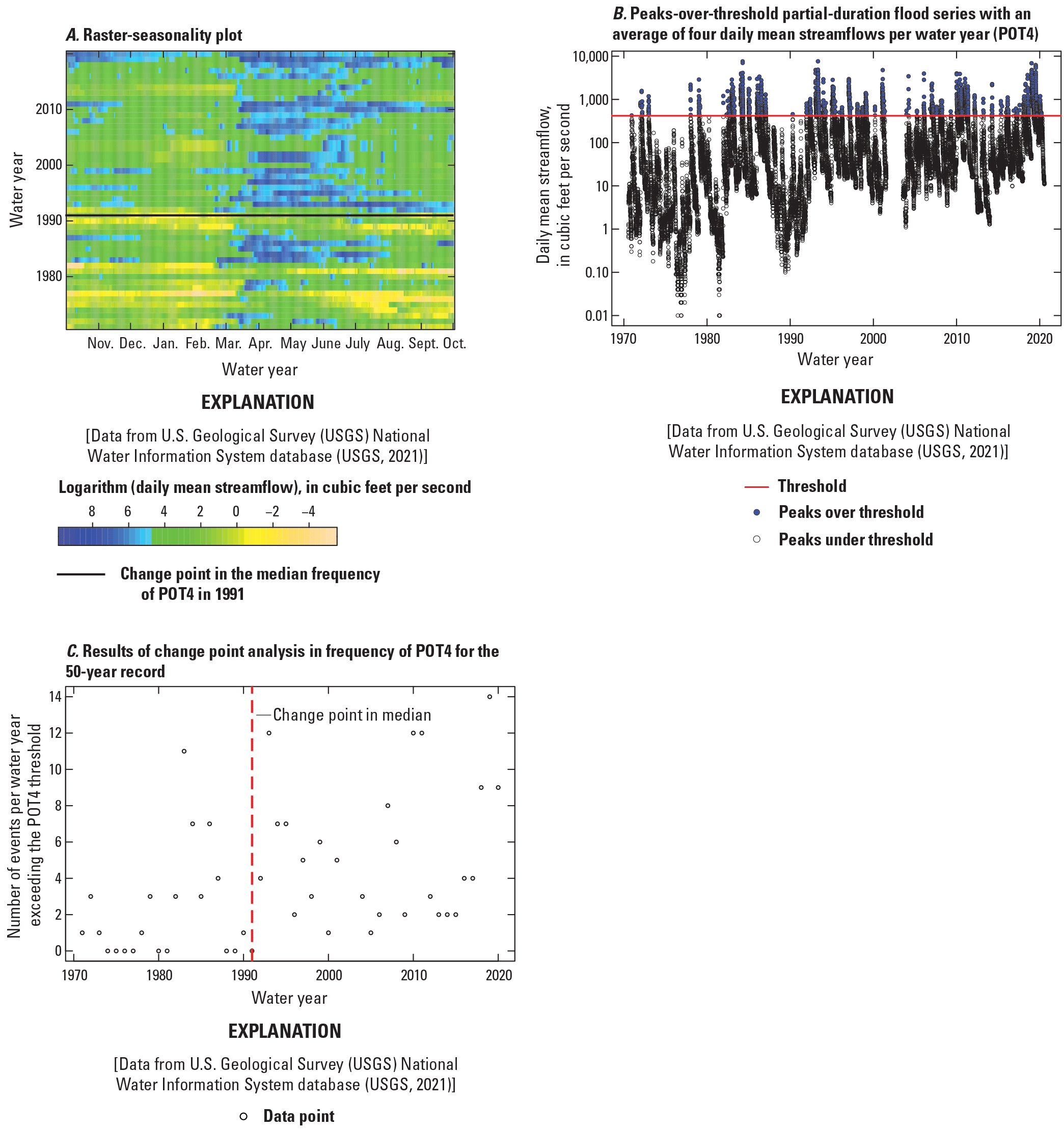
Graphs showing (A) raster-seasonality plot, (B) peaks-over-threshold partial-duration time series with an average of four daily mean streamflows per water year (POT4), and (C) the results of a change-point analysis in the frequency (counts) of POT4 for the 50-year record for the U.S. Geological Survey streamgage Skunk Creek at Sioux Falls, South Dakota (station 06481500; site SD80 in fig. 10C).
Daily Streamflow Stationarity Example 3—Cheyenne River at Edgemont, South Dakota
The raster-seasonality plot, the POT2 partial-duration time series plot, and the results of a change-point analysis in the frequency (counts) of POT2 for the 75-year daily streamflow record for the USGS streamgage Cheyenne River at Edgemont, S. Dak. (station 06395000; site SD11 in fig. 10B), are shown in figure 22A–C. Unlike the raster plots for the two previous eastern South Dakota streamgages (figs. 20A and 21A) that show substantial increases in daily streamflow after 1991–92, the raster plot for station 06395000 (fig. 22A) shows little change before and after the detected change point (fig. 22A). Furthermore, unlike the results in the daily streamflow data shown in figures 20 and 21, the significant change points in the frequency (count) detected in 1966 are going down (fig. 22B). The detected decrease in the POT2 frequency is similar to the detected downward monotonic trend (fig. 14A) and change points in the median and scale (fig. 14B) for the annual peak streamflow. Furthermore, station 06395000 (SD11) is in the southwestern part of the State where downward monotonic trends (fig. 15) and change points (fig. 17) in the 75- and 50-year trend periods were detected.

Graphs showing (A) raster-seasonality plot, (B) peaks-over-threshold partial-duration time series with an average of two daily mean streamflows per water year (POT2), and (C) the results of a change-point analysis in the frequency (counts) of POT2 for the 75-year record for the U.S. Geological Survey streamgage Cheyenne River at Edgemont, South Dakota (station 06395000; site SD11 in fig. 10B).
Statewide Peaks-Over-Threshold Analysis
In the 75-year trend period, 6 (46 percent) of the 13 qualifying streamgages collectively had detected likely upward and (or) downward changes in the frequency (count) of POT2 corresponding to an increasing and (or) decreasing number of secondary peaks greater than their respective POT2 thresholds (table 8). Three of the four likely upward streamgages were in the eastern part of the State and both of the likely downward streamgages were in the western part (fig. 23). This overall east-west spatial pattern is also detected among the results of upward (downward) monotonic trends and change points in annual peak streamflow (figs. 15 and 17, respectively). In the 50-year trend period, of the 30 streamgages with daily streamflow data, 10 streamgages (33 percent) had detected likely upward changes in median counts and no likely downward were detected. Furthermore, all 10 streamgages with likely upward change points were throughout the State. In the 30-year trend period, 9 of the 53 streamgages (17 percent) with daily streamgage data had detected likely upward (downward) changes in median counts.
Table 8.
Results of change points in the median counts of peaks-over-threshold partial-duration time series with an average of two daily mean streamflows per water year (POT2) for qualifying streamgages in the 75-, 50-, and 30-year trend periods in South Dakota.[A water year is the 12-month period from October 1 to September 30 and is designated by the year in which it ends. The number of qualifying streamgages per trend period that have annual peak streamflow and no daily streamflow are counted among the “not applicable” (NAs). Likely upward/downward (1.0 to 0.85); somewhat likely upward/downward (0.85 to 0.70); about as likely as not (less than 0.70). NA, not applicable]
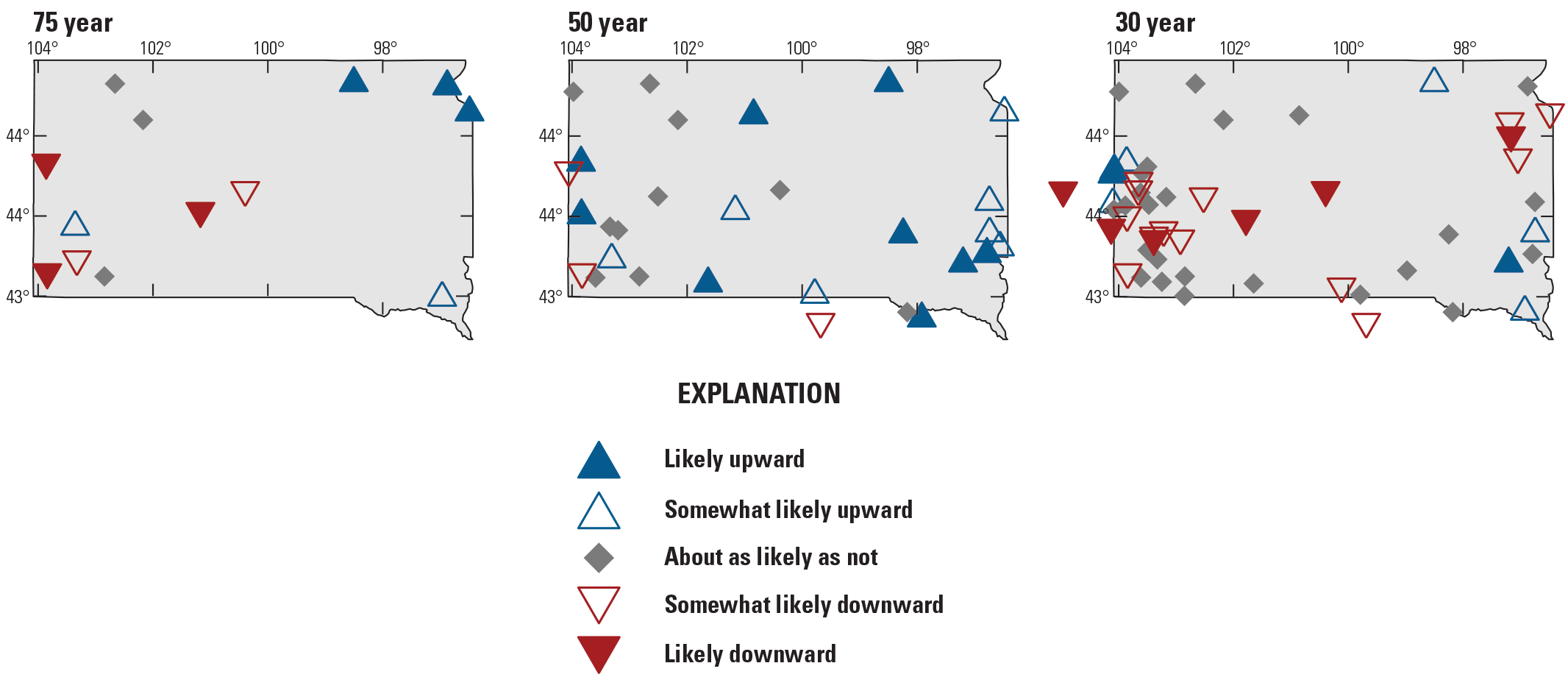
Maps showing likelihood results of change points in the median counts of peaks-over-threshold partial-duration time series with an average of two daily mean streamflows (POT2) per water year for qualifying streamgages in the 75-, 50-, and 30-year trend periods in South Dakota.
In the 75-year trend period, 7 of the 13 qualifying streamgages (54 percent) collectively had detected likely upward and (or) downward changes in the frequency (count) of POT4 corresponding to an increasing and (or) decreasing number of secondary peaks greater than their respective POT4 thresholds (table 9). In the 50-year trend period, 11 of the 30 qualifying streamgages (37 percent) with daily streamgage data had detected likely upward and (or) downward change points in the POT4 counts. In the 75- and 50-year trend periods, the more common east-west spatial pattern across the State of likely upward and (or) downward corresponding to increasing and (or) decreasing changes was detected (fig. 24). However, as described previously for annual peak streamflow, the results in the 30-year trend period are inconsistent with the overall east-west spatial patterns detected in the 75- and 50-year monotonic trends and the detected change points. This inconsistency was also detected in results of the POT2 and POT4 analyses of daily streamflow.
Table 9.
Results of change points in the median counts of peaks-over-threshold partial-duration time series with an average of four daily mean (POT4) streamflows per water year for qualifying streamgages in the 75-, 50-, and 30-year trend periods in South Dakota.[A water year is the 12-month period from October 1 to September 30 and is designated by the year in which it ends. The number of qualifying streamgages per trend period that have annual peak streamflow and no daily streamflow are counted among the “not applicable” (NAs). Likely upward/downward (1.0 to 0.85); somewhat likely upward/downward (0.85 to 0.70); about as likely as not (less than 0.70)]
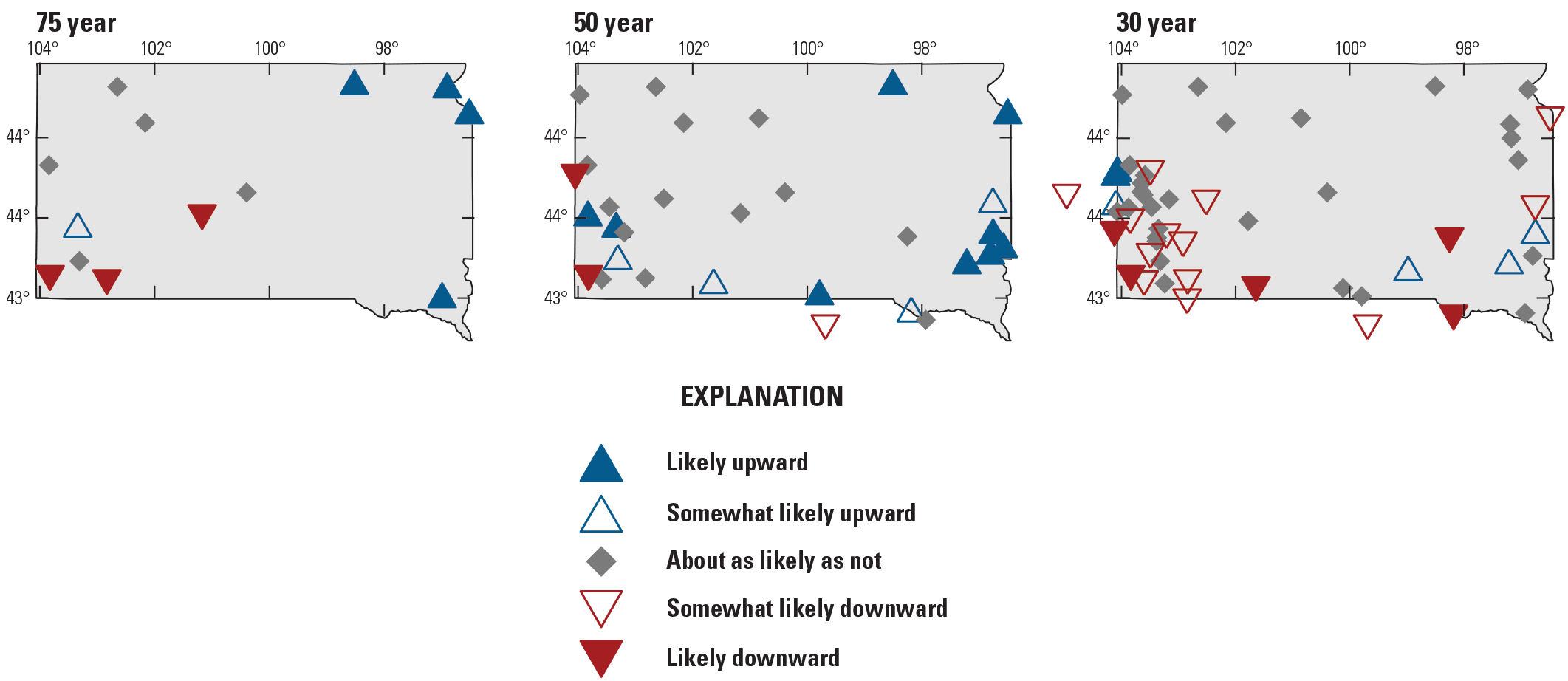
Maps showing likelihood results of change points in the median counts of peaks-over-threshold partial-duration time series with an average of four daily mean streamflows (POT4) per water year for qualifying streamgages in the 75-, 50-, and 30-year trend periods in South Dakota.
Potential stationarity violations (nonstationarity) in annual peak streamflow because of serial correlation (iid violation), monotonic trends, and (or) change points may lead to misrepresenting the population of peak-flow magnitudes and their frequency when doing a peak-flow FFA. When potential nonstationarity is detected, a multiple lines of evidence approach can be used to evaluate candidate attributions for the detected violations. Using daily streamflow data, when available, has been determined to aid in identifying temporal changes in the streamflow regimes that are consistent with detected changes in the peak streamflow, especially among streamgages in the 75- and 50-year trend periods in South Dakota. It also provides evidence of additional violations in other high streamflow magnitude regimes (POT2 and POT4 partial-duration series) that likely affect flow duration and flood volumes that could degrade levees, for example, and could be further investigated in future research.
Climate
To further evaluate hydroclimatic shifts and climate change effects on the annual peak and daily streamflows presented previously, the results of hydroclimatic variation for the 75-, 50-, and 30-year trend periods in South Dakota are presented in this section. First, the same three long-term USGS streamgages that were described in the annual peak and daily streamflow results (stations 06478690 [SD69], 06481500 [SD80], and 06395000 [SD11]) are used to illustrate detected changes in hydroclimatic variability in the State. These streamgages typify similar violations among other streamgages in the respective trend periods and among surrounding sites. Next, the overall results of hydroclimatic variation in annual precipitation, snowfall, PET, and soil moisture storage are presented for all qualifying streamgages, and seasonal results are presented for precipitation and soil moisture storage per WY for all three trend periods. However, as discussed in the annual peak and daily streamflow results, the 75- and 50-year trend periods are spatially consistent throughout the State between trend periods, and the 30-year trend period is inconsistent. The likely reason for this inconsistency in the 30-year period is the trend period begins in 1991. Thus, for the longer term sites in the 75- and 50-year trend periods, 1991 is past the detected change point in the 1980s or is straddling the more commonly detected change point in 1992–93. For this reason, the results of the 30-year trend period are listed in the tables and shown in the corresponding figures yet will not be discussed in this section.
The trend magnitude plots are in inches per WY and are not normalized by the median for the respective trend period, as was done for the trend magnitudes in annual peak streamflow. Normalizing the trend magnitude to percentage change per WY leads to an inconsistent comparison among qualifying streamgages in the respective trend periods. For example, if a streamgage in the northwestern part of the State, which receives 16 in. of average annual precipitation, is compared to a streamgage in the southeastern part, which receives an average of 28 in., both have a 2-percent change in annual precipitation over a trend period, but the effects of the trend magnitudes may be more severe on the northwestern streamgage (fig. 4). However, it still may be informative to evaluate the range in detected trend magnitudes among the climate metrics between trend periods and throughout the State.
Climatological Metrics for Stationarity Example 1—West Fork Vermillion River near Parker, South Dakota
The results of linear ordinary least squares (OLS) fitted and the loess smoothed trend lines for the total cumulative precipitation (in inches), the ratio of the liquid equivalent snowfall to annual cumulative precipitation (per WY), the annual average soil moisture storage (in inches per WY), and a raster plot of the soil moisture storage (in inches) for each month (x-axis) per WY (y-axis) for the 50-year record for the USGS streamgage West Fork Vermillion River near Parker, S. Dak. (station 06478690; site SD69 in fig. 10C), are shown in figure 25A–D. An increase in total WY precipitation (0.10 in. per WY) and average WY soil moisture storage (0.03 in. per WY) was detected and a decrease in the snowfall/precipitation ratio (−0.0006 per WY) was detected over the 50-year trend period (fig. 25A–C). Similar to the results in the raster-seasonality plots for daily streamflow (fig. 20A), the raster plot for the MWBM soil moisture storage indicates an increase in antecedent soil moisture over multiple consecutive months per WY after 1992. These changes in soil moisture storage coincide with detected change points in the median and scale of annual peak streamflow (fig. 12C) in 1992, the increases in daily streamflow after 1992 (fig. 20A), and the detected change point in the frequency (count) of POT2 in 1992 (fig. 20C).
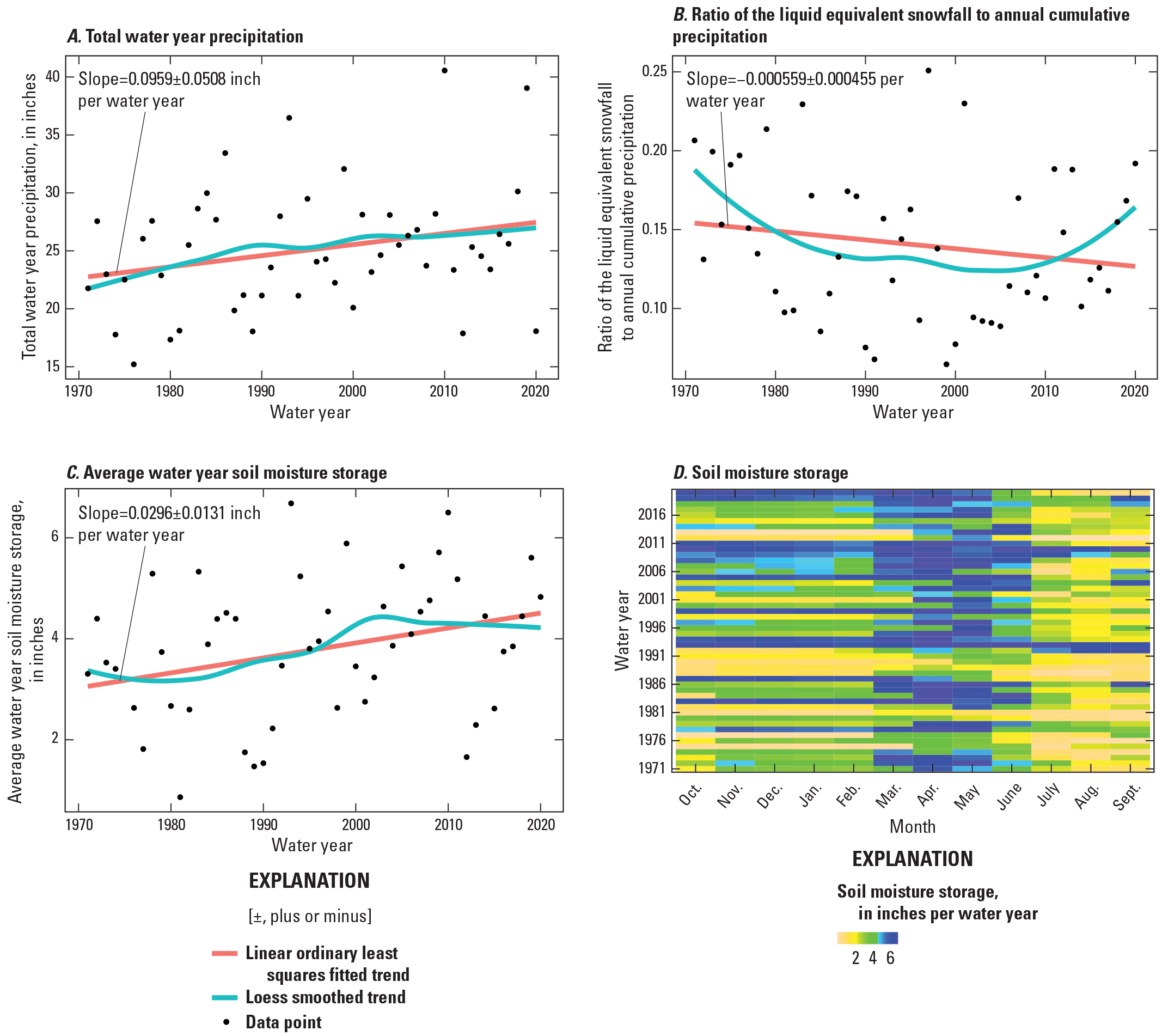
Graphs showing climatological metrics determined for the 50-year record for the U.S. Geological Survey streamgage West Fork Vermillion River near Parker, South Dakota (station 06478690; site SD69 in fig. 10C). Panels show the linear ordinary least squares fitted and the loess smoothed trend lines for (A) the total cumulative precipitation, in inches per water year; (B) the ratio of the liquid equivalent snowfall to annual cumulative precipitation per water year; (C) the annual average soil moisture storage, in inches per water year; and (D) the monthly soil moisture storage, in inches per water year. [A water year is the 12-month period from October 1 to September 30 and is designated by the year in which it ends]
Climatological Metrics Stationarity Example 2—Skunk Creek at Sioux Falls, South Dakota
The results of linear OLS fitted and the loess smoothed trend lines for the total cumulative precipitation (in inches), the ratio of the liquid equivalent snowfall to annual cumulative precipitation (per WY), the annual average soil moisture storage (in inches per WY), and a raster plot of the soil moisture storage (in inches) for each month (x-axis) per WY (y-axis) for the 50-year record for the USGS streamgage Skunk Creek at Sioux Falls, S. Dak. (station 06481500; site SD80 in fig. 10C), are shown in figure 26A–D. Similar to station 06478690 (SD69; fig. 25A–D), an increase in total WY precipitation (0.09 in. per WY) and average WY soil moisture storage (0.03 in. per WY) was detected, but a decrease in the snowfall/precipitation ratio (−0.0005 per WY) over the 50-year trend period was also detected. Similar to the results in the raster-seasonality plots for daily streamflow (fig. 21A), the raster plot for the MWBM soil moisture storage indicates an increase in antecedent soil moisture over multiple consecutive months per WY after 1991. These changes in soil moisture storage coincide with the detected monotonic trends in annual peak streamflow (fig. 13B), the increases in daily streamflow after 1992 (fig. 21A), and the detected change point in the frequency (count) of POT4 in 1991 (fig. 21C). Stations 06478690 (SD69) and 06481500 (SD80) are in the eastern part of the State where the 75- and 50-year trend periods indicate spatially consistent likely upward monotonic trends and change points. Increases in precipitation and soil moisture storage could potentially lead to increases in flow magnitudes in annual peak and daily streamflow and are described later in this section.
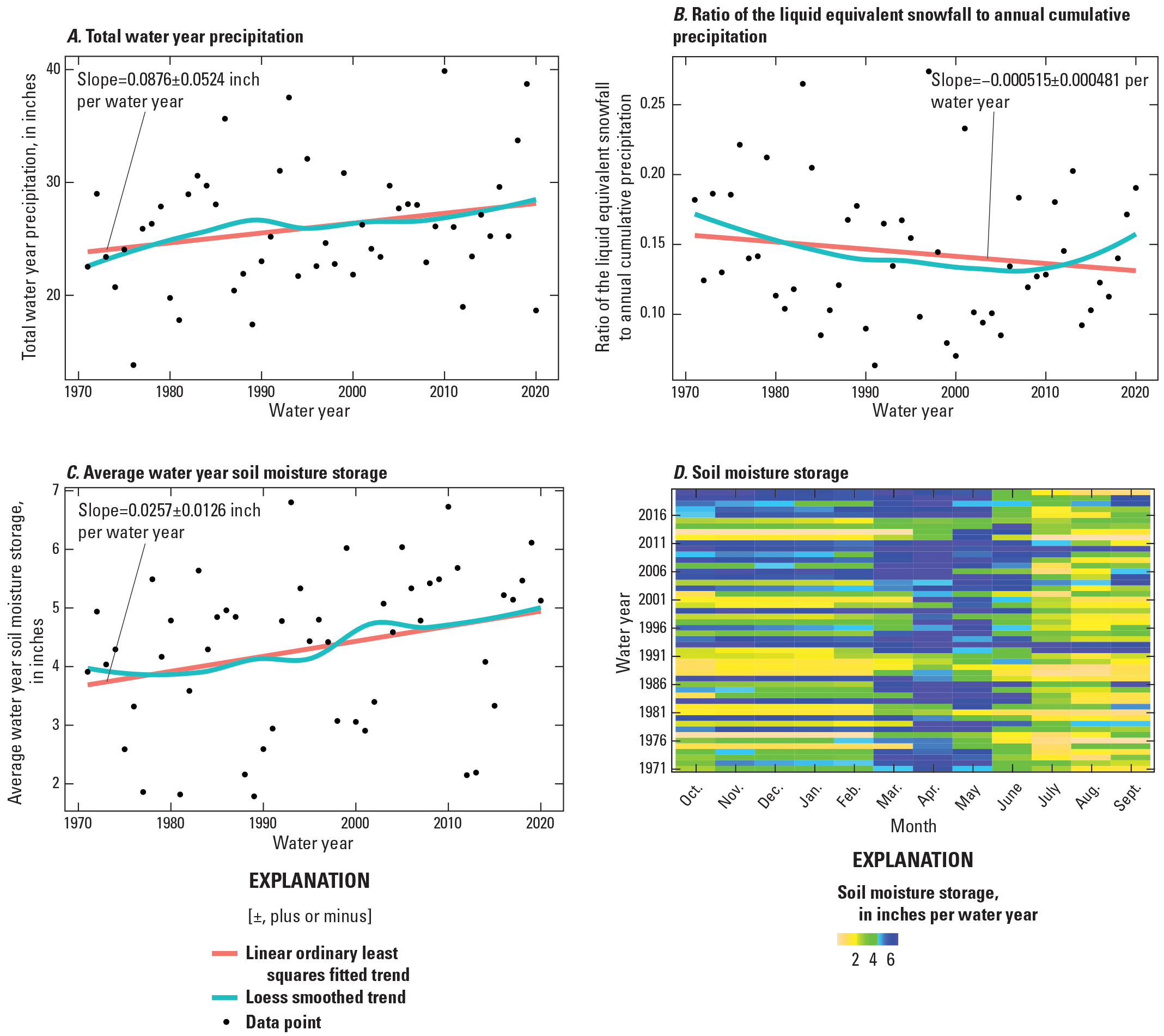
Graphs showing climatological metrics determined for the 50-year record for the U.S. Geological Survey streamgage Skunk Creek at Sioux Falls, South Dakota (station 06481500; site SD80 in fig. 10C). Panels show the linear ordinary least squares fitted and the loess smoothed trend lines for (A) the total cumulative precipitation, in inches per water year; (B) the ratio of the liquid equivalent snowfall to annual cumulative precipitation per water year; (C) the annual average soil moisture storage, in inches per water year; and (D) the monthly soil moisture storage, in inches per water year. [A water year is the 12-month period from October 1 to September 30 and is designated by the year in which it ends]
Climatological Metrics Stationarity Example 3—Cheyenne River at Edgemont, South Dakota
The results of linear OLS fitted and the loess smoothed trend lines for the total cumulative precipitation (in inches), the ratio of the liquid equivalent snowfall to annual cumulative precipitation (per WY), the annual average soil moisture storage (in inches per WY), and a raster plot of the soil moisture storage (in inches) for each month (x-axis) per WY (y-axis) for the 75-year record for the Cheyenne River at Edgemont, S. Dak. (station 06395000; site SD11 in fig. 10B), are shown in figure 27A–D. Similar to the previous two stations, 06478690 (SD69) and 06481500 (SD80), an increase was detected in total WY precipitation (0.02 in. per WY) and average WY soil moisture storage (0.004 in. per WY), but a decrease was also detected in the snowfall/precipitation ratio (−0.0003 per WY) over the 75-year trend period. A fairly consistent drying out in the soil moisture storage is detected after the maxima in annual peak and daily streamflow which commonly occurs between March to June (fig. 27D). Although precipitation and soil moisture storage are increasing at station 06395000 (SD11), they are not increasing at the much higher rates detected at stations 06478690 (SD69) and 06481500 (SD80). Furthermore, station 06395000 (SD11) is in the southwestern part of the State where there are spatially consistent likely downward monotonic trends (fig. 15) and change points (fig. 17) in the 75- and 50-year trend periods among the annual peak streamflows. Additional considerations of how the detected spatially consistent east-west likely upward and (or) downward monotonic trends and change points in annual peak streamflow and POT2 and POT4 among the 75- and 50-year trend periods are related to the hydroclimatic variability among other modeled climate metrics are explored in the rest of this section.
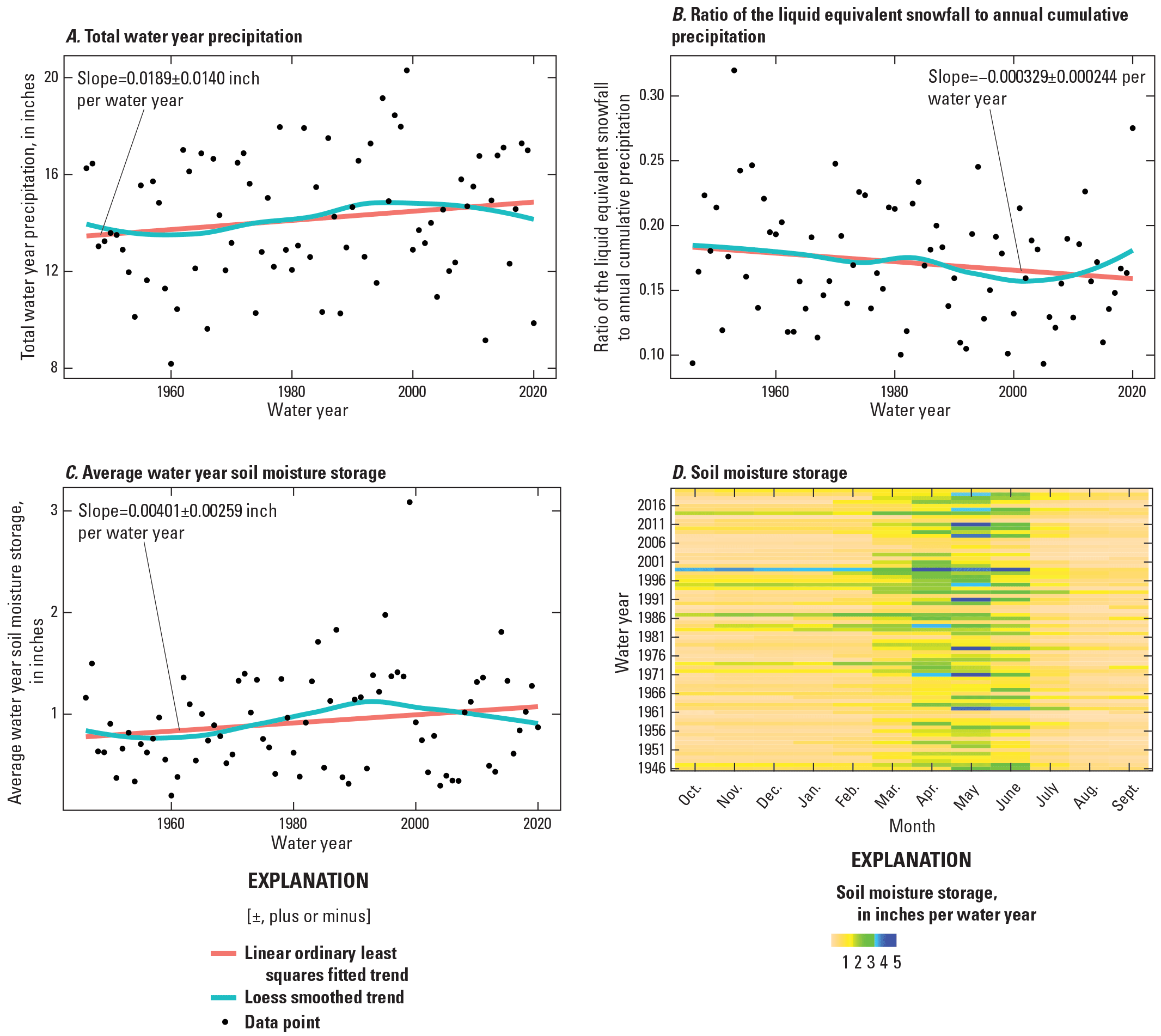
Graphs showing climatological metrics determined for the 75-year record for the U.S. Geological Survey streamgage Cheyenne River at Edgemont, South Dakota (station 06395000; site SD11 in fig. 10B). Panels show the linear ordinary least squares fitted and the loess smoothed trend lines for (A) the total cumulative precipitation, in inches per water year; (B) the ratio of the liquid equivalent snowfall to annual cumulative precipitation per water year; (C) the annual average soil moisture storage, in inches per water year; and (D) the monthly soil moisture storage, in inches per water year. [A water year is the 12-month period from October 1 to September 30 and is designated by the year in which it ends]
Annual Precipitation
Of the 13 qualifying streamgages, 12 (92 percent) in the 75-year trend period and 21 of the 35 qualifying streamgages (60 percent) in the 50-year trend period had detected likely upward monotonic trends in annual precipitation (table 10). No streamgages in either trend period had detected likely downward monotonic trends. Upward trends in precipitation are detected across the State, and the trend magnitudes are substantially higher in the 50-year trend period in the eastern part of the State (fig. 28). Boxplots are used to highlight the differences in trend magnitudes between the 75- and 50-year trend periods (fig. 29). The minimum, median, and maximum trend magnitudes for the qualifying streamgages in the 75- and 50-year trend periods are 0.02, 0.04, and 0.07 and −0.01, 0.06, and 0.11 in. per WY (fig. 29), respectively. Thus, the higher precipitation detected in the 50-year period is likely attributable, in part, to the detected increase in annual peak and daily streamflow, particularly in the eastern part of the State.
Table 10.
Results of monotonic trends in annual precipitation per water year (in inches per water year) for qualifying streamgages in the 75-, 50-, and 30-year trend periods in South Dakota.[A water year is the 12-month period from October 1 to September 30 and is designated by the year in which it ends. Likely upward/downward (1.0 to 0.85); somewhat likely upward/downward (0.85 to 0.70); about as likely as not (less than 0.70)]
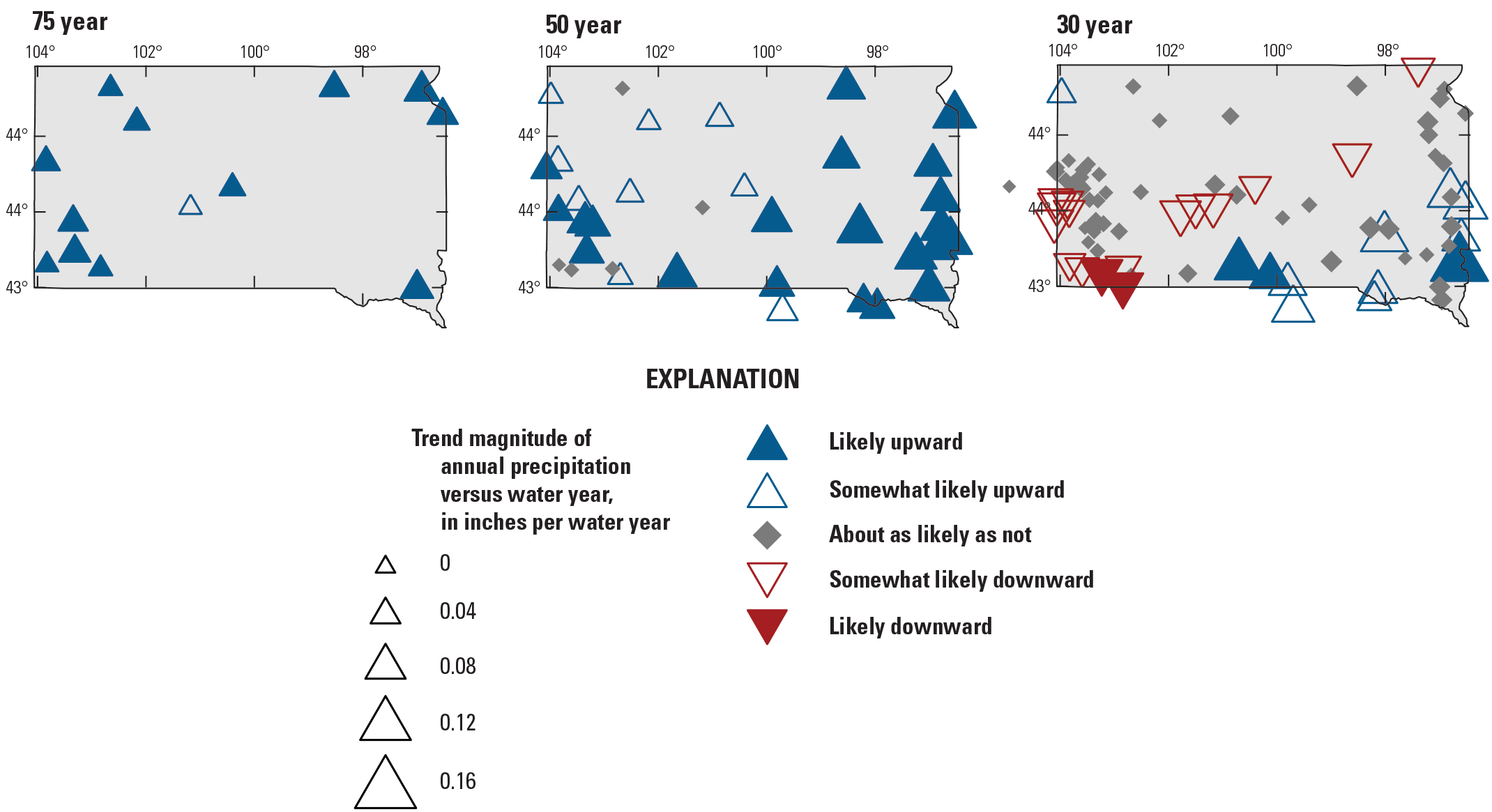
Maps showing likelihood and magnitude results of monotonic trends in annual precipitation per water year (in inches per water year) for qualifying streamgages in the 75-, 50-, and 30-year trend periods in South Dakota. [A water year is the 12-month period from October 1 to September 30 and is designated by the year in which it ends]
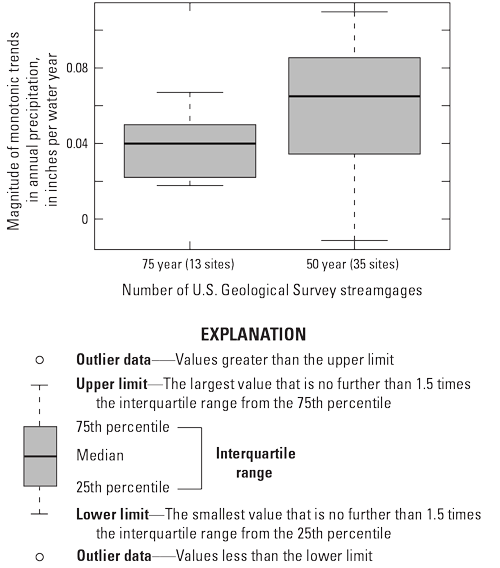
Boxplot showing the magnitude of monotonic trends in annual precipitation (in inches per water year) for qualifying streamgages in the 75- and 50-year trend periods in South Dakota. [A water year is the 12-month period from October 1 to September 30 and is designated by the year in which it ends]
Annual Snowfall
Of the 13 qualifying streamgages, 5 (38 percent) in the 75-year trend period and 17 of the 35 qualifying streamgages (49 percent) in the 50-year trend period had detected likely downward monotonic trends in the ratio of the liquid equivalent snowfall to annual cumulative precipitation (table 11). No streamgages in either trend period had detected likely upward monotonic trends. Downward trends in the ratio of the liquid equivalent snowfall to annual cumulative precipitation are detected across the State, and the trend magnitudes are higher in the 50-year trend period (fig. 30). The consistently detected increasing annual precipitation and decreasing amount of precipitation attributed to snowfall throughout the State in both trend periods indicates an overall increase in rainfall. The results of seasonal changes in precipitation are discussed later in this section to evaluate if the increasing annual precipitation is detected across all seasons or only among a few.
Table 11.
Results of monotonic trends in the ratio of the liquid equivalent snowfall to annual cumulative precipitation (in percent per water year) for qualifying streamgages in the 75-, 50-, and 30-year trend periods in South Dakota.[A water year is the 12-month period from October 1 to September 30 and is designated by the year in which it ends. Likely upward/downward (1.0 to 0.85); somewhat likely upward/downward (0.85 to 0.70); about as likely as not (less than 0.70)]
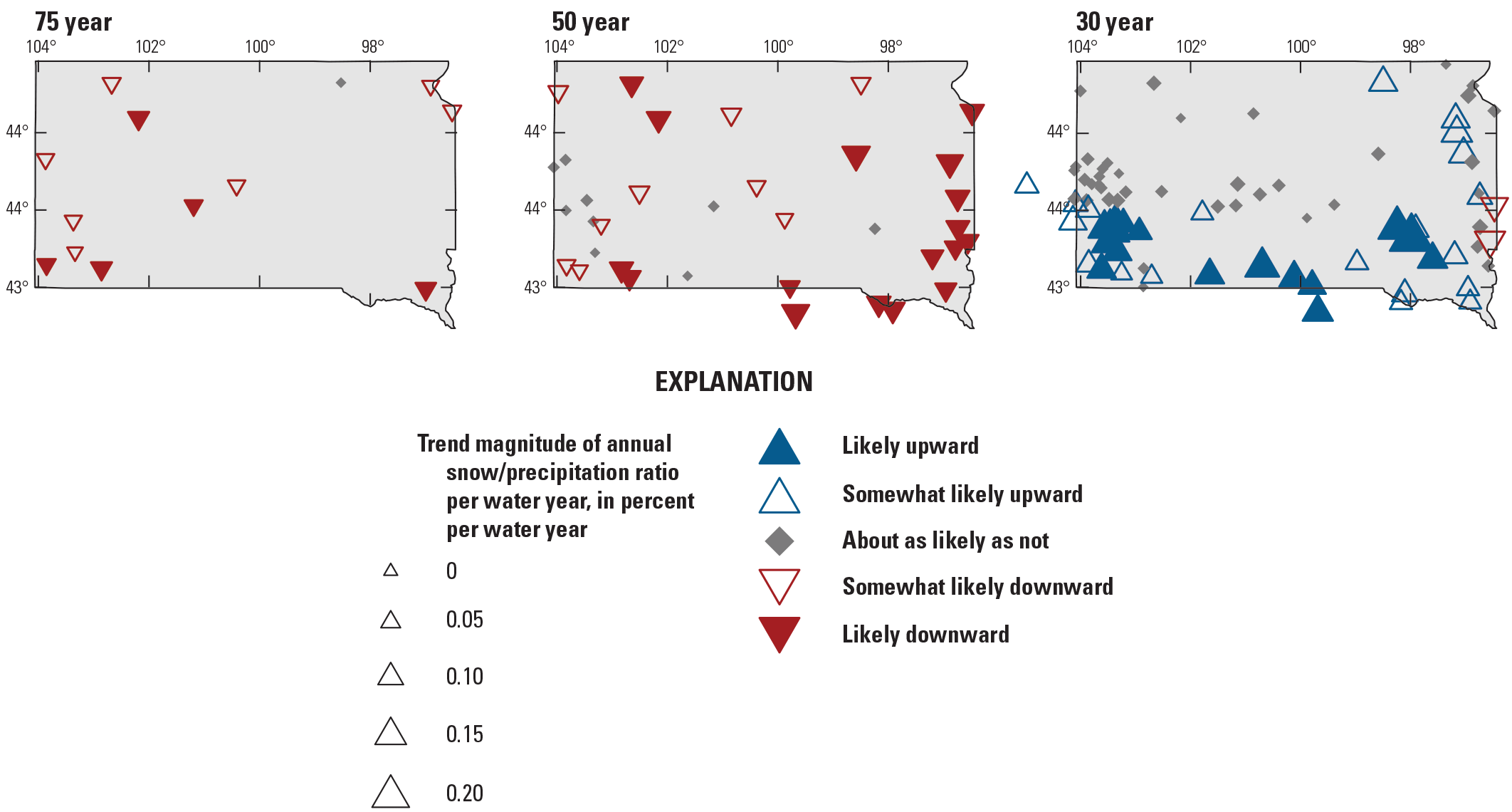
Maps showing likelihood and magnitude results of monotonic trends in the ratio of the liquid equivalent snowfall to annual cumulative precipitation (in percent per water year) for qualifying streamgages in the 75-, 50-, and 30-year trend periods in South Dakota. [A water year is the 12-month period from October 1 to September 30 and is designated by the year in which it ends]
Annual Potential Evapotranspiration
Of the 13 qualifying streamgages, 4 (31 percent) in the 75-year trend period and 14 of the 35 qualifying streamgages (40 percent) in the 50-year trend period had detected likely downward monotonic trends in the ratio of PET and precipitation (table 12). No streamgages in either trend period had detected likely upward monotonic trends. Downward trends in the ratio of PET and precipitation per WY (in percent per WY) were detected across the State, and the trend magnitudes are higher in the 50-year trend period (fig. 31). Furthermore, decreases in the ratio of PET and precipitation mean less water is leaving the basin through evaporation and transpiration. As described earlier in this section, changes in hydroclimatology in a basin are described as the imbalance in precipitation and ET. Thus, the detected longer term trends in inputs (increasing precipitation) and outputs (decreasing PET) in the water MWBM will likely lead to other changes in hydroclimatic metrics, including changes in runoff and annual peak and daily streamflows.
Table 12.
Results of monotonic trends in the ratio of potential evapotranspiration and precipitation per water year (in percent per water year) for qualifying streamgages in the 75-, 50-, and 30-year trend periods in South Dakota.[A water year is the 12-month period from October 1 to September 30 and is designated by the year in which it ends. Likely upward/downward (1.0 to 0.85); somewhat likely upward/downward (0.85 to 0.70); about as likely as not (less than 0.70)]
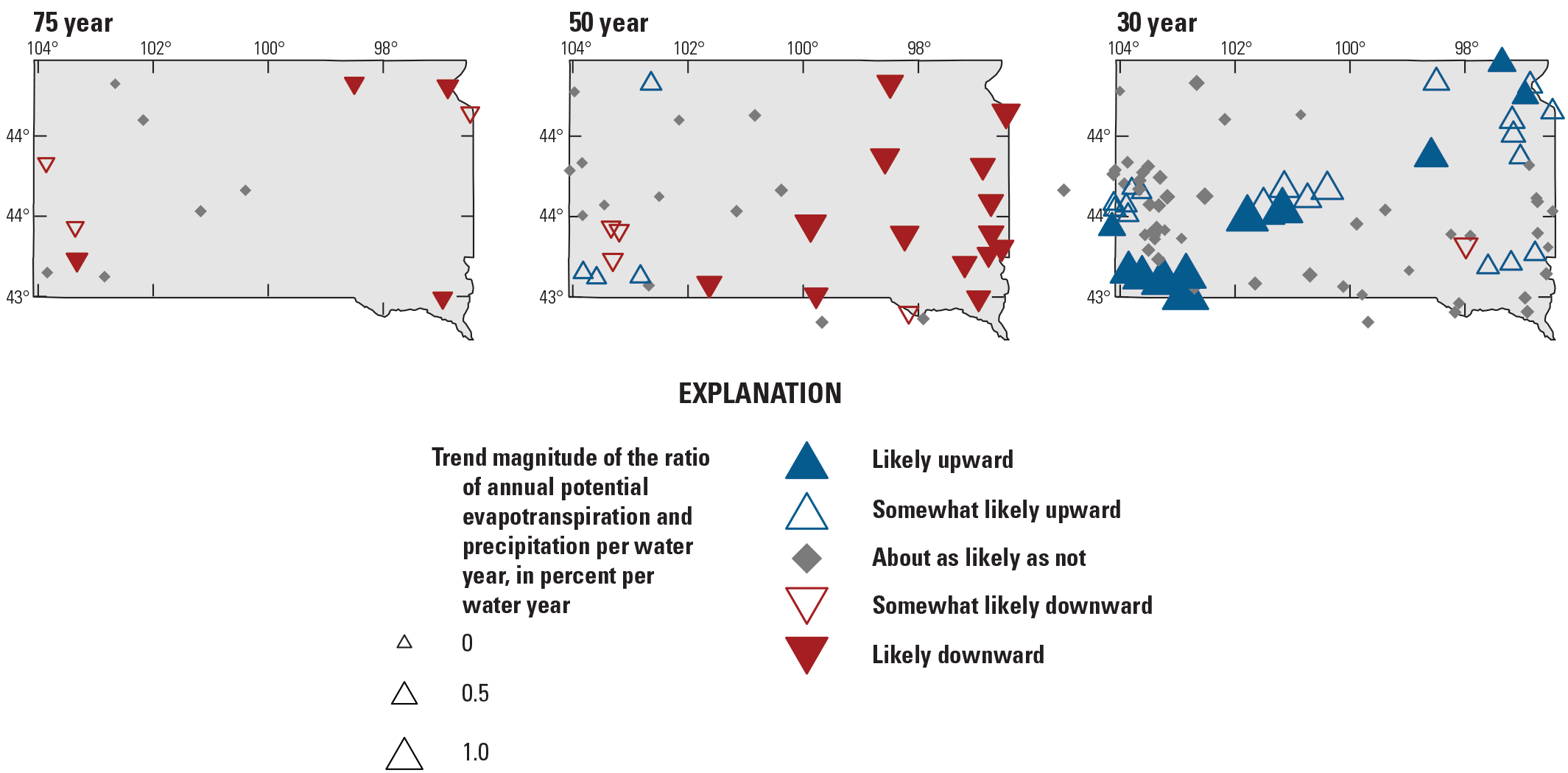
Maps showing likelihood and magnitude results of monotonic trends for the ratio of annual potential evapotranspiration and precipitation per water year (in percent per water year) for qualifying streamgages in the 75-, 50-, and 30-year trend periods in South Dakota. [A water year is the 12-month period from October 1 to September 30 and is designated by the year in which it ends]
Annual Soil Moisture Storage
All 13 qualifying streamgages (100 percent) in the 75-year trend period and 17 of the 35 qualifying streamgages (49 percent) in the 50-year trend period had detected likely upward monotonic trends in the soil moisture storage (table 13). None of the streamgages in both trend periods had detected likely downward monotonic trends. Upward trends in the soil moisture storage per WY (in inches per WY) were detected across the State, and the trend magnitudes were higher in the 50-year trend period (fig. 32). Boxplots are used to highlight the differences in trend magnitudes between the 75- and 50-year trend periods (fig. 33). The minimum, median, and maximum trend magnitudes for the qualifying streamgages in the 75- and 50-year trend periods are 0.004, 0.008, and 0.02 and −0.009, 0.009, and 0.03 (in inches per WY), respectively. Although the median soil moisture storage is similar between the 75- and 50-year trend periods, more streamgages have higher trend magnitudes in the 50-year trend period. Additionally, the higher soil moisture storage trend magnitude is once again detected in the eastern part of the State.
Table 13.
Results of monotonic trends in soil moisture storage per water year (in inches per water year) for qualifying streamgages in the 75-, 50-, and 30-year trend periods in South Dakota.[A water year is the 12-month period from October 1 to September 30 and is designated by the year in which it ends. Likely upward/downward (1.0 to 0.85); somewhat likely upward/downward (0.85 to 0.70); about as likely as not (less than 0.70)]
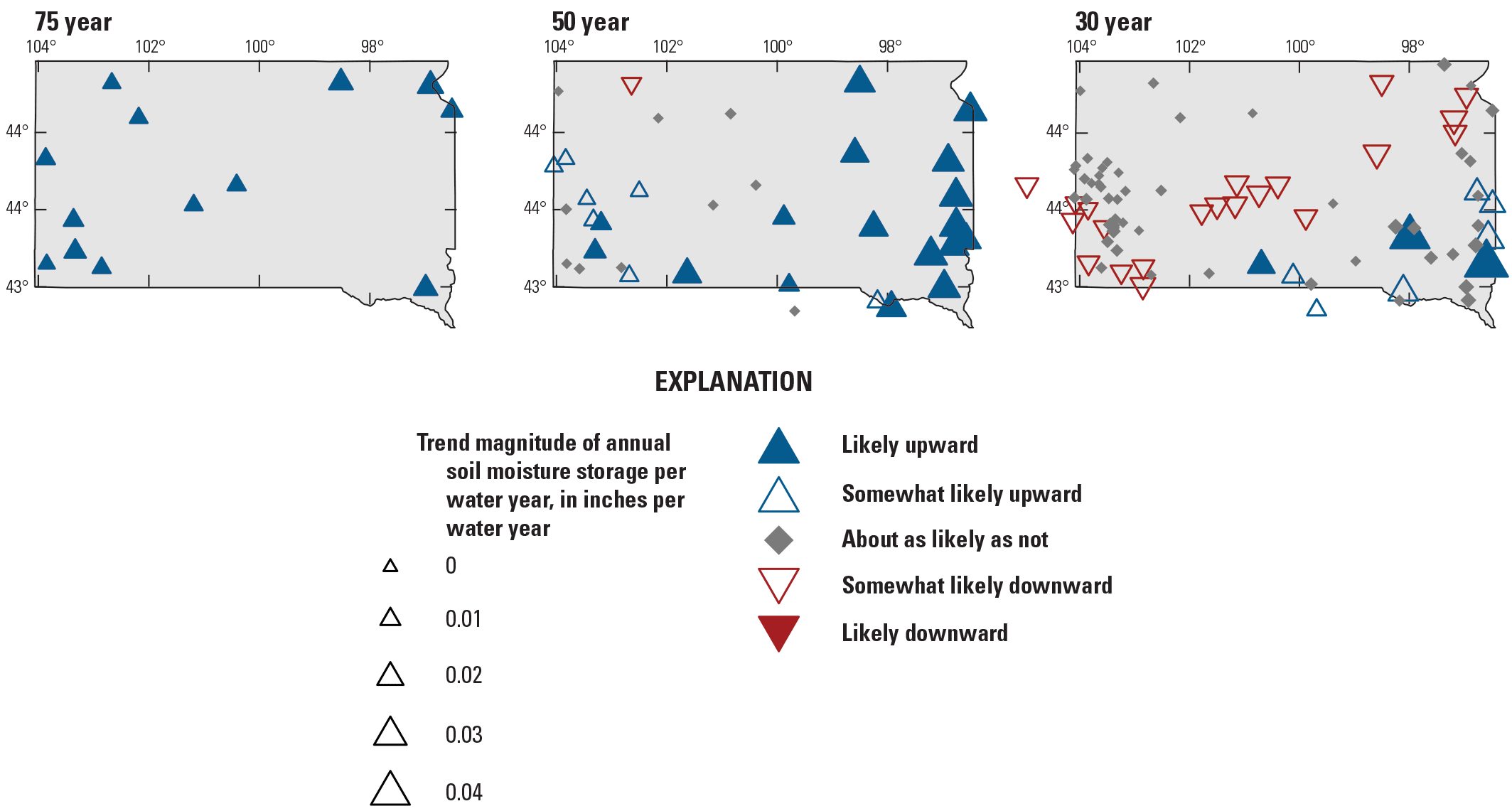
Maps showing likelihood and magnitude trend results of annual soil moisture storage per water year (in inches per water year) for qualifying streamgages in the 75-, 50-, and 30-year trend periods in South Dakota. [A water year is the 12-month period from October 1 to September 30 and is designated by the year in which it ends]

Boxplot showing the magnitude of monotonic trends in annual soil moisture storage (in inches per water year) for qualifying streamgages in the 75- and 50-year trend periods in South Dakota. [A water year is the 12-month period from October 1 to September 30 and is designated by the year in which it ends]
Thus far in this section, consistent detections include (1) increasing precipitation, (2) decreasing fraction of the precipitation attributed to snowfall, (3) decreasing PET, and (4) increasing soil moisture storage in the annual trend magnitudes across the State. Furthermore, the detected trend magnitudes are larger in the 50-year trend period and are primarily in the eastern part of the State. In the next two sections, the results of seasonal changes in precipitation and soil moisture storage are presented.
Seasonal Precipitation
As described earlier, likely upward monotonic trends were detected for the 75- and 50-year trend periods in annual precipitation throughout South Dakota. The 50-year trend period had the highest detected magnitude changes and most streamgages were in the eastern part of the State. However, a likely downward trend in annual snowfall was consistently detected in both trend periods throughout the State. This section describes the results of detected monotonic trends in seasonal precipitation among seasons in the 75- and 50-year trend periods. Seasonal precipitation is separated by the following climatological months: winter (December through February), spring (March through May), summer (June through August), and fall (September through November).
In the 75-year record, 6 (46 percent), 11 (85 percent), 0, and all 13 qualifying streamgages (100 percent) had likely upward trends in winter, spring, summer, and fall precipitation, respectively (table 14). No streamgages in any of the four seasons had detected likely downward trends. Furthermore, the likely upward trends in winter, spring, and fall are across the State (fig. 34). In the 50-year trend period, 24 (69 percent), 5 (14 percent), 17 (49 percent), and 10 (29 percent) of the 35 qualifying streamgages had likely upward trends in winter, spring, summer, and fall precipitation, respectively (table 14). Similar to the 75-year trend period, likely downward trends were not detected for any streamgages in any of the four seasons. In the 50-year trend period, the likely upward streamgages in the winter were across the State. However, a notable spatial shift among those streamgages exists with detected upward trends in precipitation in the summer and fall seasons. A large likelihood magnitude increase was detected among streamgages in the central and eastern parts of the State in the summer season and the eastern part of the State in fall (fig. 34).
Table 14.
Results of monotonic trends in seasonal precipitation per water year (in inches per water year) for qualifying streamgages in the 75-, 50-, and 30-year trend periods in South Dakota. The climatological seasons are defined as winter (December through February), spring (March through May), summer (June through August), and fall (September through November).[A water year is the 12-month period from October 1 to September 30 and is designated by the year in which it ends. Likely upward/downward (1.0 to 0.85); somewhat likely upward/downward (0.85 to 0.70); about as likely as not (less than 0.70)]
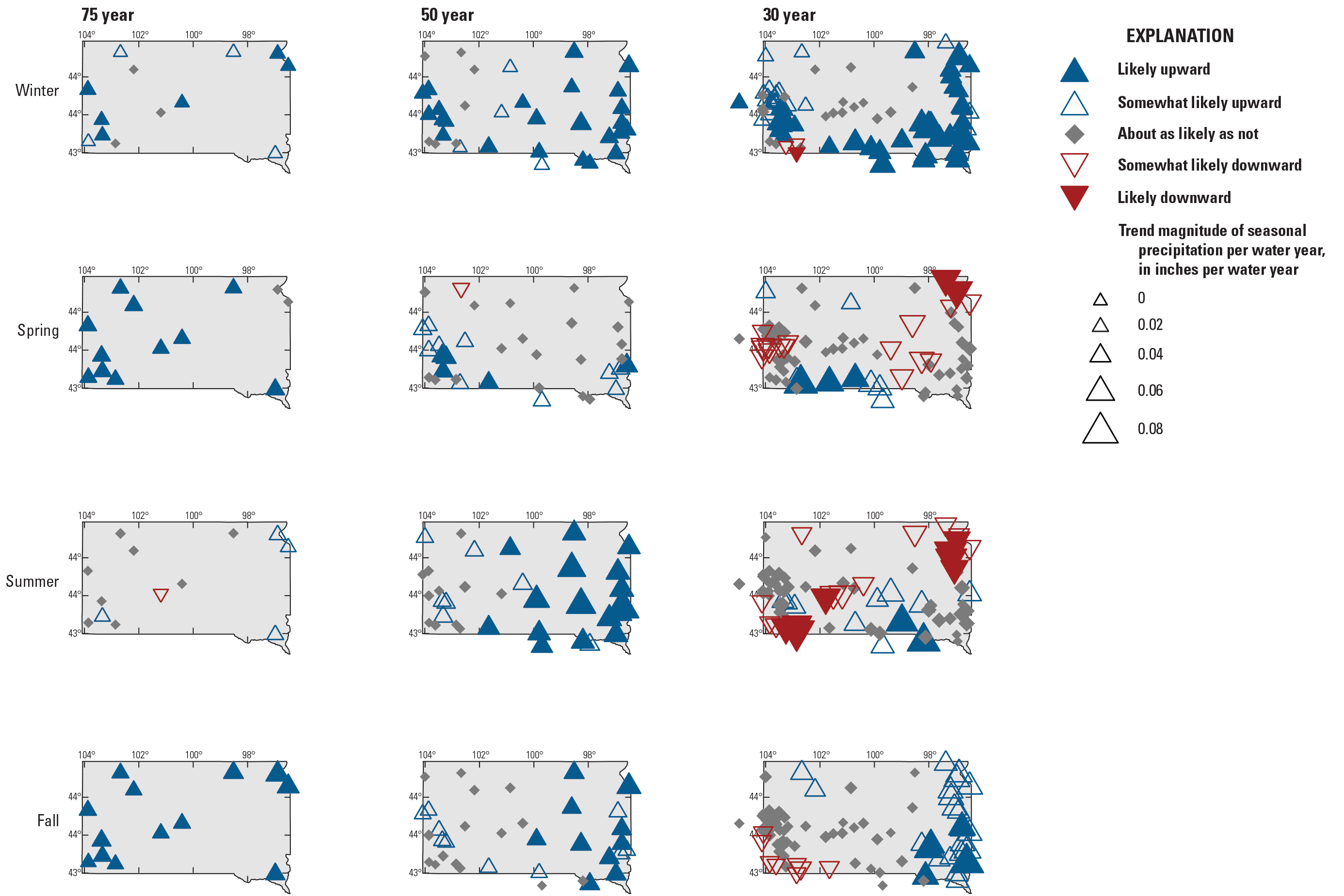
Maps showing likelihood and magnitude trend results of seasonal precipitation per water year (in inches per water year) for qualifying streamgages in the 75-, 50-, and 30-year trend periods in South Dakota. The climatological seasons are defined as winter (December through February), spring (March through May), summer (June through August), and fall (September through November). [A water year is the 12-month period from October 1 to September 30 and is designated by the year in which it ends]
The monotonic trend magnitudes in seasonal precipitation in the respective four seasons between the 75- and 50-year trend periods highlight a pronounced change in precipitation in winter and later into the summer season in the 50-year trend period (fig. 35A, C). In the winter season, the median trend magnitudes for the 75- and 50-year trends periods were 0.0038 and 0.011, respectively (fig. 35A), and more streamgages in the eastern part of the State had increasing seasonal precipitation (fig. 34). In the spring season, the median trend magnitude for the 75- and 50-year trends periods are 0.013 and 0.0099, respectively (fig. 35B), and all but two streamgages in the far eastern part of the State in the 75-year trend period had detected increases in seasonal precipitation (fig. 34). However, in the 50-year trend period, a spatial inconsistency of likely upward trends among the qualifying streamgages compared to the annual and other seasonal precipitation results was detected (fig. 34). The most notable change in trend magnitude in seasonal precipitation was detected in the summer season in the 50-year trend period. The median trends for the 75- and 50-year trend periods were 0.0025 and 0.025, respectively, representing a 10-percent increase in the median (fig. 35C). Furthermore, the streamgages with detected likely upward trends in the 50-year trend period are in the central and eastern parts of the State (fig. 34). Finally, in the fall season, the medians for the 75- and 50-year trend periods were similar, 0.015 and 0.013, respectively (fig. 35D), and represent some of the highest medians among all 8 of the seasonal trend magnitudes for the 2 trend periods, excluding the 50-year summer median trend magnitudes. This detected increase in seasonal precipitation in the 50-year trend period not only in winter but also in summer and fall, especially in the eastern part of the State, likely represents candidate attributions for the detected monotonic trends and change points in annual peak and daily streamflow and POT2 and POT4. These detected temporal and spatial upward trends in precipitation in both trend periods further help identify candidate attributions for the observed hydroclimatic variability in South Dakota.

Boxplots showing the magnitude of monotonic trends in seasonal precipitation per water year (in inches per water year) for qualifying streamgages in the 75- and 50-year trend periods in South Dakota. The climatological seasons are defined as (A) winter (December through February), (B) spring (March through May), (C) summer (June through August), and (D) fall (September through November). [A water year is the 12-month period from October 1 to September 30 and is designated by the year in which it ends]
Seasonal Soil Moisture Storage
As described previously, likely upward monotonic trends were detected for the 75- and 50-year trend periods in annual soil moisture storage throughout South Dakota. The 50-year trend period has the highest detected trend magnitudes, and most streamgages are in the eastern part of the State. This section describes the results of detected monotonic trends in seasonal soil moisture storage between seasons in the 75- and 50-year trend periods. In 75-year record, all 13 qualifying streamgages (100 percent) had likely upward trends in winter and spring, whereas 4 (31 percent) and 12 (92 percent) streamgages had likely upward trends in the summer and fall soil moisture storage, respectively (table 15). No streamgages in any of the four seasons had detected likely downward trends in the 75-year trend period. Furthermore, the likely upward trends in all seasons were across the State (fig. 36). In the 50-year trend period, 16 (46 percent), 14 (40 percent), 15 (43 percent), and 16 (46 percent) of the 35 qualifying streamgages had likely upward trends in winter, spring, summer, and fall soil moisture storage, respectively. Only one streamgage, which is in the northwestern part of the State, had a detected likely downward trend in the spring and summer. In the 50-year trend period, unlike the 75-year trend period, the likely upward streamgages are primarily in the eastern part of the State across all four seasons (fig. 36) and have a high likelihood for increasing magnitude compared to the 75-year trend period, except in the spring season (fig. 36).
Table 15.
Results of monotonic trends in seasonal soil moisture storage per water year (in inches per year) for qualifying streamgages in the 75-, 50-, and 30-year trend periods in South Dakota. The climatological seasons are defined as winter (December through February), spring (March through May), summer (June through August), and fall (September through November).[A water year is the 12-month period from October 1 to September 30 and is designated by the year in which it ends. Likely upward/downward (1.0 to 0.85); somewhat likely upward/downward (0.85 to 0.70); about as likely as not (less than 0.70)]
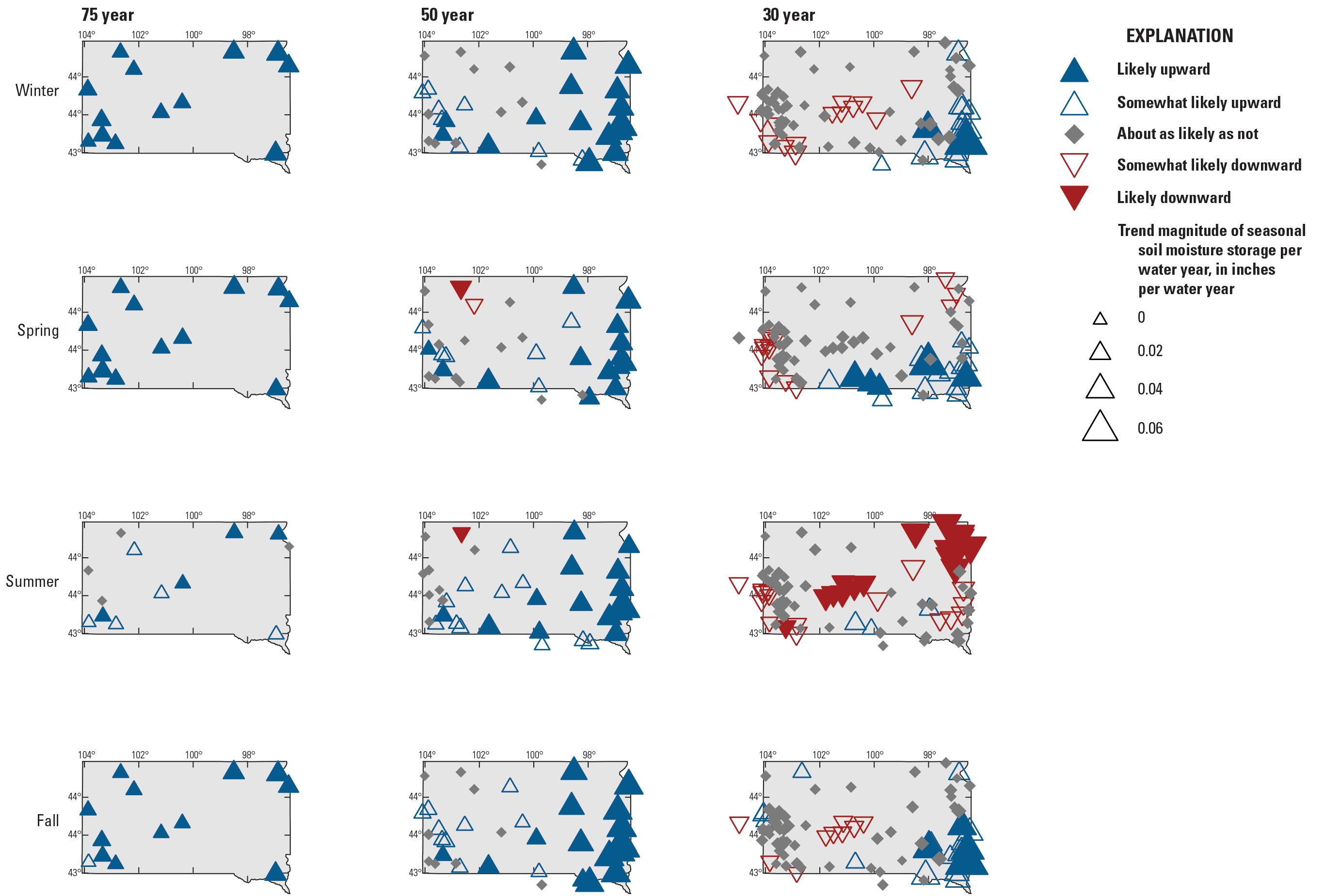
Maps showing likelihood and magnitude trend results of seasonal soil moisture storage per water year (in inches per water year) for qualifying streamgages in the 75-, 50-, and 30-year trend periods in South Dakota. The climatological seasons are defined as winter (December through February), spring (March through May), summer (June through August), and fall (September through November). [A water year is the 12-month period from October 1 to September 30 and is designated by the year in which it ends]

Boxplots showing the magnitude of monotonic trends in seasonal soil moisture storage per water year (in inches per water year) for qualifying streamgages in the 75- and 50-year trend periods in South Dakota. The climatological seasons are defined as (A) winter (December through February), (B) spring (March through May), (C) summer (June through August), and (D) fall (September through November). [A water year is the 12-month period from October 1 to September 30 and is designated by the year in which it ends]
Consistently detected monotonic trends in seasonal soil moisture storage in the respective four seasons between the 75- and 50-year trend periods highlight year-round upward trends and represent another candidate attribution for the detected monotonic trends and change points in annual peak and daily streamflow, POT2, and POT4. In the winter season, the median trend magnitude for the 75- and 50-year trends periods are 0.0019 and 0.0022, respectively (fig. 37A). Notably, all qualifying streamgages across the State in the 75-year trend period had detected increases in seasonal soil moisture storage, whereas in the 50-year period, they are in the eastern part of the State (fig. 36). In the spring season, the median trend magnitudes for the 75- and 50-year trends periods were 0.0035 and −0.0019, respectively (fig. 37B). The same spatial patterns of streamgages with likely upward trends detected in the winter season were detected for the spring season for both trend periods (fig. 36). Similar to trends detected in the summer precipitation, the most notable detected trends in the magnitude in seasonal soil moisture storage were also detected in the summer season for both trend periods. The median trends for the 75- and 50-year trend periods were 0.0070 and 0.0079, respectively (fig. 37C). The streamgages with detected likely upward trends in the 75-year period were far fewer (four streamgages) than in the 50-year period and are across the State. In the 50-year trend period, the streamgages were again primarily in the eastern part of the State (fig. 36). Finally, in the fall season, the medians for the 75- and 50-year trend periods were 0.0029 and 0.0079, respectively (fig. 37D). The fall season median trend magnitude in the 75-year period is similar to spring, whereas in the 50-year period, the median magnitude is identical to the summer season, and both are the largest of all four seasons. The temporal and spatial seasonal results in the detected upward trends in soil moisture storage are similar to the seasonal results in precipitation and may also further help identify candidate attributions for the observed hydroclimatic variability in South Dakota. Lastly, the detected upward trend magnitudes in the summer and fall seasons in the 50-year trend period, which are in the eastern part of the State, are likely responsible for later peak-flow timing (fig. 19) and was detected at stations 06478690 (SD69; fig. 12D) and 06481500 (SD80; fig. 13C). Future investigations of changes in seasonality using the MWBM soil moisture storage metrics may explain the detected later peak-flow timing among qualifying streamgages in the eastern part of the State.
The results of monotonic trends in the hydroclimatic metrics from the MWBM (increasing precipitation, decreasing snowfall, increasing PET, and increasing soil moisture storage) indicate consistent temporal and spatial trends in the relative contributions of the inputs and outputs to the respective basins. These detected trends and direction of change in hydroclimatic variability are consistent with the temporal and spatial patterns detected in the annual peak and daily streamflow. Ryberg and others (2014) used a nonlinear water-balance analysis in the study area that included the Red River of the North in North Dakota and the James and Big Sioux Rivers in South Dakota. They determined that changes in precipitation and PET explain most of the variability in runoff and flood magnitudes, and precipitation is the primary driver. They also concluded that historical changes in climate and runoff in the region seem to be more consistent with complex transient shifts of seasonal climatic conditions than with gradual climate change. Based on the climatic results from the MWBM through WY 2020 used in this study, further evidence indicates that temporal (based on longer term trend periods) and spatial patterns throughout South Dakota also indicate seasonal climatic shifts in hydroclimatic variability.
Lastly, the detected annual and seasonal upward trends in soil moisture storage in the eastern part of the State may also be affected by the unique geologic setting and related soil composition. Furthermore, these upward trends lead to basin memory, which also drives changes not only in annual peak and daily streamflow but also in flow durations and volumes (Norton and others, 2022). The raster-seasonality plot and the POT2 and POT4 time series further provide evidence of prolonged multidecadal flood regime shifts leading to longer durations of higher flow volumes, especially in the eastern part of the State. The connection between changes in climate in tandem with the geology and soil properties in this part of the State have likely led to multidecadal persistence of basin memory. Norton and others (2022) described the importance of surface water/groundwater interaction, particularly in the eastern part of South Dakota and in the Prairie Pothole Region in the Central Lowland hydrologic region (fig. 5). In eastern South Dakota, the detected increase in precipitation and antecedent moisture (from infiltration and the increase in shallow groundwater levels) can oversaturate shallow glacial and alluvial aquifers and exceed the aquifer storage capacity (Valseth and Driscoll, 2021). Furthermore, Norton and others (2022) described how the low permeability Cretaceous shale underlying the shallow glacial and alluvial aquifers inhibits the infiltration of the groundwater, resulting in decreased localized storage capacity, rising groundwater levels, and increased overland runoff. The unique combination in detected hydroclimatic variability and the geologic setting makes eastern South Dakota more sensitive to changes in streamflow because of multidecadal persistence and potential nonstationarity.
Implications for Flood-Frequency Analysis
When doing at-site peak-flow FFAs using the recently updated Federal guidelines in Bulletin 17C (England and others, 2018) to estimate the magnitude and frequency of AEPs used for flood design structures, a number of stationarity assumptions are used. Appendix 4 in Bulletin 17C describes the initial data analysis that can be used when doing at-site FFAs, including a visual inspection of the annual peak-flow data series to identify any potential violations of stationarity assumptions. These assumptions include (1) that the time series is iid (no auto or serial correlation) and (2) no monotonic trends or (3) change points are detected. These nonstationarities can lead to changes in one or all three moments (mean, variance, and skewness [fig. 9]), which may cause substantial changes in the flood-frequency distribution. Based on the results of these stationarity tests for the qualifying streamgages in South Dakota among the 75-, 50-, and 30-year trend periods, consistent temporal and spatial patterns of potential stationarity violations were detected among the 75- and 50-year trend periods. Furthermore, additional implications on flood design structures including increased bridge scour and culvert and highway design in the eastern parts of South Dakota may exist based on increased streamflow and volume in the last decade, according to the results from Norton and others (2022), when nonstationarity is detected in daily streamflow data series.
In this larger nine-State study, common trend periods of 100-, 75-, 50-, and 30-years were analyzed for potential stationarity violations. Although continuous streamgage records with 100 and 75 years may be considered long enough to span potential trends at the decadal level, they may not be long enough for observed long-term oscillations over multiple decades and centuries among hydroclimatic variables (Lins and others, 2010). Paleoflood evidence of substantially higher floods extending back 2,000 years in the Black Hills (Harden and others, 2011) is an illustrative example of changes in the hydroclimatic cycle that led to even higher floods than the present-day devastating floods in 1972 and 2007.
Study Limitations
The spatial distribution and drainage basin size of streamgages used may skew results. The spatial distribution of streamgages has been informed by the location of feasible streamgage sites and flood forecasting, water supply, and other specific needs. In the long term, this spatial distribution does not reflect an ideal distribution of sites to answer questions about the effects of climate and land-use change. In addition, the longest term streamgages tend to represent large basins.
A tradeoff exists between a spatial distribution more representative of conditions across the study area and the use of long-term streamgages to study climate; therefore, we used 100-, 75-, 50-, and 30-year trend periods. The short-term (30-year) trend may differ markedly from the longer term patterns.
The lack of comprehensive information on regulation, diversion, and depletions makes site selection a challenge when investigating questions about climate effects on peak streamflow. A data-informed approach to regulation was used for the selection of sites in this study; however, the available data have known limitations. The approach and limitations are described in Marti and Ryberg (2023).
The seasonal analyses in this report have been done without regard for the periodic (circular) nature of the underlying data; therefore, the resulting statistics (medians and trends of peak streamflow) may be misleading when the data being considered have values near the end or the beginning of the WY (that is, in September and October). Such data values are more common in the peak-flow data.
Analyses of daily streamflow include sites with periods of missing record because initial streamgage selection was based on criteria for appropriateness and completeness of peak-flow data. In some cases, this means the POT analysis may not fully represent the hydrologic regime during the entire period of analysis. Users may consult the data release (Marti and others, 2024) to assess sites individually.
We used methods to detect nonstationarities that are gradual (monotonic trends, Mann-Kendall test for trend, and Theil-Sen slope) and abrupt (Pettitt test for changes in the median and Mood test for changes in scale). Gradual detection methods look at the entire record to assess the significance of change and determine if there is a trend. Abrupt methods look for specific points in the series when there is a significant change in a selected statistic; however, the true type of nonstationarity detected by a gradual or abrupt method may be unclear (Rougé and others, 2013). For instance, an abrupt method may identify the center of a gradual linear trend as a change point. Similarly, a gradual method may identify a trend when the data series indicates a change point. Whether a series contains a change point, a monotonic trend, or both, such features are a violation of the stationarity assumption for flood-frequency analysis (Ryberg and others, 2020b).
The climate analyses rely on modeled data; therefore, the modeled streamflow does not match the actual streamflow. Depending on the degree of divergence, the mismatch can make it challenging to interpret the analyses of the various pieces of the water balance and to ascertain which components contribute most to the error; however, if the trend in modeled streamflow is in the same direction as the trend in actual streamflow, we assumed that the water-balance components were estimated with reasonable accuracy. See McCabe and Wolock (2011) for more discussion on sources of error in the water-balance model.
Furthermore, the model parameters used to simulate the modeled streamflow and the related hydrologic states, such as soil moisture storage, are unchanging in time and assume rural land use; therefore, the model output does not include the effects of urbanization and other land-use changes. In addition, the climate data (observed and modeled) are at a monthly time step. As a result, these data do not provide information on changes in climate at shorter time steps (for example, changes in daily precipitation intensity) that may be important for peak streamflows under certain conditions (Ivancic and Shaw, 2015; Sharma and others, 2018).
Summary
Peak-flow frequency analysis is essential to water-resources management applications, including critical structure design (for example, bridges and culverts) and floodplain mapping. Federal guidelines for performing peak-flow flood frequency analyses are presented in a U.S. Geological Survey Techniques and Methods Report known as Bulletin 17C. A basic assumption within Bulletin 17C is that, for basins without major hydrologic alterations (for example, regulation, diversion, and urbanization), statistical properties of the distribution of annual peak streamflows are stationary; that is, the mean, variance, and skew are constant. Nonstationarity is a statistical property of a peak-flow series such that the long-term distributional properties change one or more times either gradually or abruptly through time. Individual nonstationarity may be attributed to one source (for example, either flow regulation, land-use change, or climate) but often is the result of a mixture of these sources, which makes detection and attribution of nonstationarities challenging. Not incorporating observed trends into flood-frequency analysis may result in a poor representation of the true flood risk. Bulletin 17C does not offer guidance on how to incorporate nonstationarities when estimating floods and further identifies a need for additional flood-frequency studies that incorporate changing climate or basin characteristics into the analysis.
In response to a history of concern regarding nonstationarity in annual peak streamflows in the larger region, a study was done by the U.S. Geological Survey (USGS), in cooperation with the Departments of Transportation of Illinois, Iowa, Michigan, Minnesota, Missouri, South Dakota, and Wisconsin; the Montana Department of Natural Resources and Conservation; and the North Dakota Department of Water Resources, to assess potential nonstationarity in annual peak streamflows in the central United States. This chapter characterizes the effects of natural hydroclimatic shifts and potential climate change on annual peak streamflows in the State of South Dakota. Annual peak and daily streamflow and model-simulated gridded climatic data are examined for monotonic trends, change points, and other statistical properties indicative of changing climatic and environmental conditions. The multistate study is intended to provide a framework for addressing potential nonstationarity issues in peak-flow flood-frequency analysis (FFA) updates that commonly are completed by the USGS, in cooperation with other agencies throughout the United States.
Changes in annual peak and daily streamflow are evaluated among 13, 35, and 81 qualifying USGS streamgages for the 75-, 50-, and 30-year trend periods through water year 2020 (the period from October 1, 2019, to September 30, 2020) in South Dakota, respectively. No qualifying streamgages are in the 100-year trend period in South Dakota. Of the 13 long-term streamgages, 12 (except station 05290000; site SD3) are in all three trend periods (75-, 50-, and 30-year). Of the 35 long-term streamgages, 12 are in the 50- and 30-year trend periods and are throughout the State.
The results of potential stationarity violations (nonstationarity) for doing at-site peak-flow FFAs are presented for autocorrelation (independent and identically distributed assumption), monotonic trends, and change points in the median and scale throughout the State. Additionally, an alternative to simply reporting significant trends with an arbitrary cutoff point has been adopted in this multistate study.
The independent and identically distributed assumption (no autocorrelation or serial correlation) has an effect on the statistical significance of the test results because the effective sample size is smaller than the number of observations. Overall, 31, 57, and 51 percent of the qualifying streamgages for the 75-, 50-, and 30-year trend periods, respectively, had detected likely upward and (or) downward lag-1 autocorrelation and are dispersed throughout the State.
Monotonic trends of annual peak streamflow are evaluated in this study. Additionally, a normalized magnitude (in percent per year) represents the Theil-Sen slope (in cubic feet per second per year) normalized by the median (in cubic feet per second) for the respective trend periods. Overall, a distinct east-west spatial pattern of likely upward and (or) downward monotonic trends, respectively, was detected in 75- and 50-year trend periods, whereas an inconsistent spatial pattern was detected in the 30-year trend period. Furthermore, in the 50-year trend period, larger normalized likely upward trends were detected, particularly in the eastern part of the State.
Change points (abrupt changes) in the median and scale (variability) of the annual peak streamflow are evaluated in this study. In general, the 75-year trend period has a similar east-west spatial pattern of detected likely upward and (or) downward change points in the median across the State, whereas in the 50-year trend period, the eastern part of the State is consistently likely upward. Furthermore, change points in the median were detected in the late 1970s/early 1980s in the western part of the State, whereas in the east, the change point was more commonly detected in 1992–93.
Based on the consistent results of detected temporal and spatial nonstationarities for monotonic trends and change points in South Dakota among the 75- and 50-year trend periods, there is a need to evaluate candidate attributions for these likely stationarity violations to changes in hydroclimatic variability. Changes in the peak-flow timing, the day of the year occurrence of the annal peak streamflow, represent a potential change in seasonality of flood-generating mechanisms. In the 75- and 50-year trend periods, spatial homogeneity of detected annual peak-flow timing of likely upward and (or) downward changes among the qualifying streamgages was strong. In the western part of the State, the peak-flow timing is arriving earlier (likely downward trends), whereas in the east, the annual peak-flows are arriving later (likely upward trends).
A peaks-over-threshold (POT) analysis approach where, on average, there are two events per year (POT2) and four events per year (POT4) is used to evaluate changes in the frequency (count) of daily streamflow using a change point statistical test. Overall, in the 75-year trend period, an east-west likely upward and (or) downward change corresponding to an increase or decrease in the frequency of daily streamflow greater than a POT2 and POT4 threshold was detected. In the 50-year trend period, a likely upward change (increase) in the frequency of daily streamflows greater than a POT2 and POT4 threshold were consistently detected across the State.
To explore potential attributions for the observed nonstationarities in annual peak and daily streamflow, hydroclimatic metrics are similarly analyzed for shifts. A monthly water-balance model (MWBM) was used to evaluate hydroclimatic variation in annual precipitation, snowfall, potential evapotranspiration, and soil moisture storage for all qualifying streamgages in the 75-, 50-, and 30-year trend periods. Based on the detected likely upward and (or) downward trends in the annual hydroclimatic metrics, seasonal precipitation and soil moisture storage are further investigated for candidate attributions.
In general, the results of monotonic trends in the annual hydroclimatic metrics from the MWBM for the 75- and 50-year trend periods indicated a spatially consistent statewide increase in precipitation, decrease in snowfall, decrease in potential evapotranspiration, and increase in soil moisture storage. These detected trends and direction of change in hydroclimatic variability were consistent with the temporal and spatial patterns detected in the annual peak and daily streamflow. Based on the climatic results from the MWBM through water year 2020 used in this study, further evidence exists that temporal (based on longer term trend periods) and spatial patterns throughout South Dakota also indicate seasonal climatic shifts in hydroclimatic variability.
The detected trends in seasonal precipitation in the respective four seasons between the 75- and 50-year trend periods highlight a pronounced change in precipitation in winter and later into the summer season, especially in the 50-year trend period. Furthermore, consistently detected trends in seasonal soil moisture storage highlight year-round upward trends and represent another candidate attribution for the detected monotonic trends and change points in annual peak and daily streamflow, and POT2 and POT4.
Based on the results of these stationarity tests for the qualifying streamgages in South Dakota among the 75-, 50-, and 30-year trend periods, consistent temporal and spatial patterns of potential stationarity violations were detected among the 75- and 50-year trend periods. Furthermore, when nonstationarity is detected in daily streamflow, increased streamflow and volume (increasing frequency in POT), as well as potentially bridge scour, may have implications on culvert and highway design in the eastern part of South Dakota. Thus, when doing at-site peak-flow FFAs in South Dakota, potential nonstationarities and alternative approaches are important considerations.
References Cited
Ahiablame, L., Sheshukov, A.Y., Rahmani, V., and Moriasi, D., 2017, Annual baseflow variations as influenced by climate variability and agricultural land use change in the Missouri River Basin: Journal of Hydrology, v. 551, p. 188–202. [Also available at https://doi.org/10.1016/j.jhydrol.2017.05.055.]
Archfield, S.A., Hirsch, R.M., Viglione, A., and Blöschl, G., 2016, Fragmented patterns of flood change across the United States: Geophysical Research Letters, v. 43, no. 19, p. 10232–10239. [Also available at https://doi.org/10.1002/2016GL070590.]
Barth, N.A., Ryberg, K.R., Gregory, A., and Blum, A.G., 2022, Introduction to attribution of monotonic trends and change points in peak streamflow across the conterminous United States using a multiple working hypotheses framework, 1941–2015 and 1966–2015, chap. A of Ryberg, K.R., ed., Attribution of monotonic trends and change points in peak streamflow across the conterminous United States using a multiple working hypotheses framework, 1941–2015 and 1966–2015: U.S. Geological Survey Professional Paper 1869, p. A1–A29, accessed June 20, 2023, at https://doi.org/10.3133/pp1869.
Barth, N.A., Villarini, G., and White, K., 2018, Contribution of eastern North Pacific tropical cyclones and their remnants on flooding in the western United States: International Journal of Climatology, v. 38, no. 14, p. 5441–5446. [Also available at https://doi.org/10.1002/joc.5735.]
Becker, L.D., 1980, Techniques for estimating flood peaks, volumes and hydrographs on small streams in South Dakota: U.S. Geological Survey Water-Resources Investigations Report 80–80, 82 p., accessed June 20, 2023, at https://doi.org/10.3133/wri8080.
Becker, L.D., 1982, Magnitude and frequency of floods from selected drainage basins in South Dakota: U.S. Geological Survey Water-Resources Investigations Report 82–31, 90 p., accessed June 20, 2023, at https://doi.org/10.3133/wri8231.
Benson, R.D., Hoffman, E.B., and Wipf, V.J., 1985, Analyses of flood-flow frequency for selected gaging stations in South Dakota: U.S. Geological Survey Water-Resources Investigations Report 85–4217, 202 p. [Also available at https://doi.org/10.3133/wri854217.]
Burr, M.J., and Korkow, K.L., 1996, Peak-flow frequency estimates through 1994 for gaged streams in South Dakota: U.S. Geological Survey Open-File Report 96–202, 407 p., accessed June 20, 2023, at https://doi.org/10.3133/ofr96202.
Cox, D.R., and Stuart, A., 1955, Some quick sign tests for trend in location and dispersion: Biometrika, v. 42, no. 1–2, p. 80–95. [Also available at https://doi.org/10.2307/2333424.]
Dickinson, J.E., Harden, T.M., and McCabe, G.J., 2019, Seasonality of climatic drivers of flood variability in the conterminous United States: Scientific Reports, v. 9, no. 1, article 15321, 10 p., accessed June 20, 2023, at https://doi.org/10.1038/s41598-019-51722-8.
Driscoll, D.G., Bunkers, M.J., Carter, J.M., Stamm, J.F., and Williamson, J.E., 2010, Thunderstorms and flooding of August 17, 2007, with a context provided by a history of other large storm and flood events in the Black Hills area of South Dakota: U.S. Geological Survey Scientific Investigations Report 2010–5187, 140 p., accessed June 20, 2023, at https://doi.org/10.3133/sir20105187.
Driscoll, D.G., and Carter, J.M., 2001, Hydrologic conditions and budgets for the Black Hills of South Dakota, through water year 1998: U.S. Geological Survey Water-Resources Investigations Report 2001–4226, 143 p., accessed June 20, 2023, at https://doi.org/10.3133/wri014226.
Dudley, R.W., Hodgkins, G.A., McHale, M.R., Kolian, M.J., and Renard, B., 2017, Trends in snowmelt-related streamflow timing in the conterminous United States: Journal of Hydrology, v. 547, p. 208–221. [Also available at https://doi.org/10.1016/j.jhydrol.2017.01.051.]
Engel, G.B., and Benson, R.D., 1987, Floods in eastern Nebraska and southeastern South Dakota, June 1984: U.S. Geological Survey Open-File Report 87–215, 31 p. [Also available at https://doi.org/10.3133/ofr87215.]
England, J.F., Jr., Cohn, T.A., Faber, B.A., Stedinger, J.R., Thomas, W.O., Jr., Veilleux, A.G., Kiang, J.E., and Mason, R.R., Jr., 2018, Guidelines for determining flood flow frequency—Bulletin 17C (ver. 1.1, May 2019): U.S. Geological Survey Techniques and Methods book 4, chap. B5, 148 p., accessed May 5, 2022, at https://doi.org/10.3133/tm4B5.
Falcone, J.A., Murphy, J.C., and Sprague, L.A., 2018, Regional patterns of anthropogenic influences on streams and rivers in the conterminous United States, from the early 1970s to 2012: Journal of Land Use Science, v. 13, no. 6, p. 585–614. [Also available at https://doi.org/10.1080/1747423X.2019.1590473.]
Fenneman, N.M. and Johnson, D.W., 1946, Physiographic divisions of the conterminous U. S: U.S. Geological Survey data release, accessed June 20, 2023, at https://doi.org/10.5066/P9B1S3K8.
Flint, R.F., 1955, Pleistocene geology of eastern South Dakota: Professional Paper 262, accessed June 20, 2023, at https://doi.org/10.3133/pp262.
Frankson, R., Kunkel, K.E., Champion, S.M., Easterling, D.R., Umphlett, N.A., and Stiles, C.J., 2022, South Dakota state climate summary 2022: National Oceanic and Atmospheric Administration/National Environmental Satellite, Data, and Information Service National Oceanic and Atmospheric Administration Technical Report NESDIS 150–SD, 5 p., accessed January 31, 2022, at https://statesummaries.ncics.org/chapter/sd/.
Georgakakos, A., Fleming, P., Dettinger, M., Peters-Lidard, C., Richmond, T.C., Reckhow, K., White, K., and Yates, D., 2014, Water resources, chap. 3 of Melillo, J.M., Richmond, T.C., and Yohe, G.W., eds., Climate change impacts in the United States—The third national climate assessment: Washington, D.C., U.S. Global Change Research Program, p. 69–112, accessed June 20, 2023, at https://doi.org/10.7930/J0G44N6T.
Griffin, E.R., and Friedman, J.M., 2017, Decreased runoff response to precipitation, Little Missouri River Basin, northern Great Plains, USA: Journal of the American Water Resources Association, v. 53, no. 3, p. 576–592. [Also available at https://doi.org/10.1111/1752-1688.12517.]
Harden, T.M., O’Connor, J.E., Driscoll, D.G., and Stamm, J.F., 2011, Flood-frequency analyses from paleoflood investigations for Spring, Rapid, Boxelder, and Elk Creeks, Black Hills, western South Dakota: U.S. Geological Survey Scientific Investigations Report 2011–5131, 136 p., accessed September 30, 2016, at https://doi.org/10.3133/sir20115131.
Hejazi, M., and Markus, M., 2009, Impacts of urbanization and climate variability on floods in northeastern Illinois: Journal of Hydrologic Engineering, v. 14, no. 6, p. 606–616. [Also available at https://doi.org/10.1061/(ASCE)HE.1943-5584.0000020.]
Hirsch, R.M., Archfield, S.A., and De Cicco, L.A., 2015, A bootstrap method for estimating uncertainty of water quality trends: Environmental Modelling & Software, v. 73, p. 148–166. [Also available at https://doi.org/10.1016/j.envsoft.2015.07.017.]
Hirsch, R.M., and Ryberg, K.R., 2012, Has the magnitude of floods across the USA changed with global CO2 levels?: Hydrological Sciences Journal, v. 57, no. 1, p. 1–9. [Also available at https://doi.org/10.1080/02626667.2011.621895.]
Hirschboeck, K.K., 1991, Climate and floods, in Paulson, R.W., Chase, E.B., Roberts, R.S., and Moody, D.W., comps., National water summary 1988–89—Hydrologic events and floods and droughts: U.S. Geological Survey Water Supply Paper 2375, p. 67–88, accessed June 20, 2023, at https://doi.org/10.3133/wsp2375.
Hodgkins, G.A., Dudley, R.W., Archfield, S.A., and Renard, B., 2019, Effects of climate, regulation, and urbanization on historical flood trends in the United States: Journal of Hydrology, v. 573, p. 697–709. [Also available at https://doi.org/10.1016/j.jhydrol.2019.03.102.]
Hodgkins, G.A., Whitfield, P.H., Burn, D.H., Hannaford, J., Renard, B., Stahl, K., Fleig, A.K., Madsen, H., Mediero, L., Korhonen, J., Murphy, C., and Wilson, D., 2017, Climate-driven variability in the occurrence of major floods across North America and Europe: Journal of Hydrology, v. 552, p. 704–717. [Also available at https://doi.org/10.1016/j.jhydrol.2017.07.027.]
Hoffman, E.B., Freese, M.E., and Winter, D.R., 1986, Analyses of flood-flow frequency for selected gaging stations in South Dakota through September 1985: U.S. Geological Survey Open-File Report 86–496, 137 p., accessed June 20, 2023, at https://doi.org/10.3133/ofr86496.
Holmes, R.R., Jr., Wiche, G.J., Koenig, T.A., and Sando, S.K., 2013, Peak streamflows and runoff volumes for the Central United States, February through September, 2011: U.S. Geological Survey Professional Paper 1798–C, 60 p., accessed October 21, 2021, at https://doi.org/10.3133/pp1798C.
Hoogestraat, G.K., and Stamm, J.F., 2015, Climate and streamflow characteristics for selected streamgages in eastern South Dakota, water years 1945–2013: U.S. Geological Survey Scientific Investigations Report 2015–5146, 48 p., accessed July 30, 2021, at https://doi.org/10.3133/sir20155146.
Interagency Advisory Committee on Water Data, 1982, Guidelines for determining flood flow frequency: U.S. Geological Survey Interagency Advisory Committee on Water Data, Bulletin 17B of the Hydrology Subcommittee, 194 p., accessed February 21, 2017, at https://water.usgs.gov/osw/bulletin17b/dl_flow.pdf.
Ivancic, T.J., and Shaw, S.B., 2015, Examining why trends in very heavy precipitation should not be mistaken for trends in very high river discharge: Climatic Change, v. 133, no. 4, p. 681–693. [Also available at https://doi.org/10.1007/s10584-015-1476-1.]
Ivancic, T.J., and Shaw, S.B., 2017, Identifying spatial clustering in change points of streamflow across the contiguous U.S. between 1945 and 2009: Geophysical Research Letters, v. 44, no. 5, p. 2445–2453. [Also available at https://doi.org/10.1002/2016GL072444.]
Juckem, P.F., Hunt, R.J., Anderson, M.P., and Robertson, D.M., 2008, Effects of climate and land management change on streamflow in the driftless area of Wisconsin: Journal of Hydrology, v. 355, no. 1–4, p. 123–130. [Also available at https://doi.org/10.1016/j.jhydrol.2008.03.010.]
Kolars, K.A., Vecchia, A.V., and Ryberg, K.R., 2016, Stochastic model for simulating Souris River Basin precipitation, evapotranspiration, and natural streamflow: U.S. Geological Survey Scientific Investigations Report 2015–5185, 55 p., accessed April 19, 2016, at https://doi.org/10.3133/sir20155185.
Koutsoyiannis, D., and Montanari, A., 2007, Statistical analysis of hydroclimatic time series—Uncertainty and insights: Water Resources Research, v. 43, no. 5, article W05429, 9 p., accessed June 20, 2023, at https://doi.org/10.1029/2006WR005592.
Koutsoyiannis, D., and Montanari, A., 2015, Negligent killing of scientific concepts—The stationarity case: Hydrological Sciences Journal, v. 60, no. 7–8, p. 1174–1183. [Also available at https://doi.org/10.1080/02626667.2014.959959.]
Kulkarni, A., and von Storch, H., 1995, Monte Carlo experiments on the effect of serial correlation on the Mann-Kendall test of trend: Meteorologische Zeitschrift (Berlin), v. 4, no. 2, p. 82–85. [Also available at https://doi.org/10.1127/metz/4/1992/82.]
Lang, M., Ouarda, T.B.M.J., and Bobée, B., 1999, Towards operational guidelines for over-threshold modeling: Journal of Hydrology, v. 225, no. 3, p. 103–117. [Also available at https://doi.org/10.1016/S0022-1694(99)00167-5.]
Levin, S.B., and Holtschlag, D.J., 2022, Attribution of monotonic trends and change points in peak streamflow in the Midwest Region of the United States, 1941–2015 and 1966–2015, chap. D of Ryberg, K.R., ed., Attribution of monotonic trends and change points in peak streamflow across the conterminous United States using a multiple working hypotheses framework, 1941–2015 and 1966–2015: U.S. Geological Survey Professional Paper 1869, p. 22, accessed June 20, 2023, at https://doi.org/10.3133/pp1869.
Lins, H.F., and Cohn, T.A., 2011, Stationarity—Wanted dead or alive?: Journal of the American Water Resources Association, v. 47, no. 3, p. 475–480. [Also available at https://doi.org/10.1111/j.1752-1688.2011.00542.x.]
Lins, H.F., Hirsch, R.M., and Kiang, J.E., 2010, Water—The Nation’s fundamental climate issue, a white paper on the U.S. Geological Survey role and capabilities: U.S. Geological Survey Circular 1347, 9 p., accessed June 20, 2023, at https://doi.org/10.3133/cir1347.
Mallakpour, I., and Villarini, G., 2015, The changing nature of flooding across the central United States: Nature Climate Change, v. 5, no. 3, p. 250–254, accessed June 20, 2023, at https://doi.org/10.1038/nclimate2516.
Marti, M.K., and Ryberg, K.R., 2023, Method for identification of reservoir regulation within U.S. Geological Survey streamgage basins in the central United States using a decadal dam impact metric: U.S. Geological Survey Open-File Report 2023–1034, 15 p., accessed June 20, 2024, at https://doi.org/10.3133/ofr20231034.
Marti, M.K., Wavra, H.N., Over, T.M., Ryberg, K.R., Podzorski, H.L., and Chen, Y.R., 2024, Peak streamflow data, climate data, and results from investigating hydroclimatic trends and climate change effects on peak streamflow in the Central United States, 1920–2020: U.S. Geological Survey data release, accessed July 1, 2024, at https://doi.org/10.5066/P9R71WWZ.
McCabe, J.A., and Crosby, O.A., 1959, Floods in North and South Dakota—Frequency and magnitude: U.S. Geological Survey Open-File Report 59–80, 132 p., accessed June 15, 2021, at https://doi.org/10.3133/ofr5980.
McCabe, G.J., and Wolock, D.M., 2002, A step increase in streamflow in the conterminous United States: Geophysical Research Letters, v. 29, no. 24, p. 2185–2189. [Also available at https://doi.org/10.1029/2002GL015999.]
McCabe, G.J., and Wolock, D.M., 2011, Century-scale variability in global annual runoff examined using a water balance model: International Journal of Climatology, v. 31, no. 12, p. 1739–1748. [Also available at https://doi.org/10.1002/joc.2198.]
Milly, P.C.D., Betancourt, J., Falkenmark, M., Hirsch, R.M., Kundzewicz, Z.W., Lettenmaier, D.P., and Stouffer, R.J., 2008, Stationarity is dead—Whither water management?: Science, v. 319, no. 5863, p. 573–574. [Also available at https://doi.org/10.1126/science.1151915.]
Mood, A.M., 1954, On the asymptotic efficiency of certain nonparametric two-sample tests: Annals of Mathematical Statistics, v. 25, no. 3, p. 514–522. [Also available at https://doi.org/10.1214/aoms/1177728719.]
National Oceanic and Atmospheric Administration, 2022, U.S. climate normals: National Oceanic and Atmospheric Administration National Centers for Environmental Information, accessed December 1, 2022, at https://www.ncei.noaa.gov/products/land-based-station/us-climate-normals.
Niehus, C.A., 1996, Estimation of flood flows on the Big Sioux River between Akron, Iowa, and North Sioux City, South Dakota: U.S. Geological Survey Water-Resources Investigations Report 96–4121, 20 p., accessed June 20, 2023, at https://doi.org/10.3133/wri964121.
Norton, P.A., Anderson, M.T., and Stamm, J.F., 2014, Trends in annual, seasonal, and monthly streamflow characteristics at 227 streamgages in the Missouri River watershed, water years 1960–2011: U.S. Geological Survey Scientific Investigations Report 2014–5053, 138 p., accessed June 21, 2021, at https://doi.org/10.3133/sir20145053.
Norton, P.A., Delzer, G.C., Valder, J.F., Tatge, W.S., and Ryberg, K.R., 2022, Assessment of streamflow trends in the eastern Dakotas, water years 1960–2019: U.S. Geological Survey Scientific Investigations Report 2022–5055, 20 p., accessed June 20, 2023, at https://doi.org/10.3133/sir20225055.
Oelsner, G.P., Sprague, L.A., Murphy, J.C., Zuellig, R.E., Johnson, H.M., Ryberg, K.R., Falcone, J.A., Stets, E.G., Vecchia, A.V., Riskin, M.L., De Cicco, L.A., Mills, T.J., and Farmer, W.H., 2017, Water-quality trends in the Nation’s rivers and streams, 1972–2012—Data preparation, statistical methods, and trend results (ver. 2.0, October 2017): U.S. Geological Survey Scientific Investigations Report 2017–5006, 136 p., accessed March 15, 2022, at https://doi.org/10.3133/sir20175006.
Olsen, J.R., Stedinger, J.R., Matalas, N.C., and Stakhiv, E.Z., 1999, Climate variability and flood frequency estimation for the upper Mississippi and lower Missouri Rivers: Journal of the American Water Resources Association, v. 35, no. 6, p. 1509–1523. [Also available at https://doi.org/10.1111/j.1752-1688.1999.tb04234.x.]
Önöz, B., and Bayazit, M., 2012, Block bootstrap for Mann-Kendall trend test of serially dependent data: Hydrological Processes, v. 26, no. 23, p. 3552–3560. [Also available at https://doi.org/10.1002/hyp.8438.]
Over, T.M., Saito, R.J., and Soong, D.T., 2016, Adjusting annual maximum peak discharges at selected stations in northeastern Illinois for changes in land-use conditions: U.S. Geological Survey Scientific Investigations Report 2016–5049, 46 p., accessed December 22, 2020, at https://doi.org/10.3133/sir20165049.
Pederson, G.T., Gray, S.T., Ault, T., Marsh, W., Fagre, D.B., Bunn, A.G., Woodhouse, C.A., and Graumlich, L.J., 2011, Climatic controls on the snowmelt hydrology of the northern Rocky Mountains: Journal of Climate, v. 24, no. 6, p. 1666–1687. [Also available at https://doi.org/10.1175/2010JCLI3729.1.]
Peterson, T.C., Jr., Heim, R.R., Jr., Hirsch, R., Kaiser, D.P., Brooks, H., Diffenbaugh, N.S., Dole, R.M., Giovannettone, J.P., Guirguis, K., Karl, T.R., Katz, R.W., Kunkel, K., Lettenmaier, D., McCabe, G.J., Paciorek, C.J., Ryberg, K.R., Schubert, S., Silva, V.B.S., Stewart, B.C., Vecchia, A.V., Villarini, G., Vose, R.S., Walsh, J., Wehner, M., Wolock, D., Wolter, K., Woodhouse, C.A., and Wuebbles, D., 2013, Monitoring and understanding changes in heat waves, cold waves, floods, and droughts in the United States—State of knowledge: Bulletin of the American Meteorological Society, v. 94, no. 6, p. 821–834. [Also available at https://doi.org/10.1175/BAMS-D-12-00066.1.]
Pettitt, A.N., 1979, A non-parametric approach to the change-point problem: Journal of the Royal Statistical Society, Series C (Applied Statistics), v. 28, no. 2, p. 126–135. [Also available at https://doi.org/10.2307/2346729.]
Pohlert, T., 2020, trend—Non-parametric trend tests and change-point detection (ver. 1.1.2): CRAN digital data, accessed July 29, 2022, at https://CRAN.R-project.org/package=trend.
R Core Team, 2021, R—A language and environment for statistical computing: R Foundation for Statistical Computing software release, accessed February 21, 2021, at https://www.r-project.org/.
Razavi, S., Elshorbagy, A., Wheater, H., and Sauchyn, D., 2015, Toward understanding nonstationarity in climate and hydrology through tree ring proxy records: Water Resources Research, v. 51, no. 3, p. 1813–1830. [Also available at https://doi.org/10.1002/2014WR015696.]
Ross, G.J., 2015, Parametric and nonparametric sequential change detection in R—The cpm package: Journal of Statistical Software, v. 66, no. 3, p. 1–20. [Also available at https://doi.org/10.18637/jss.v066.i03.]
Ross, G.J., 2020, cpm—Sequential and batch change detection using parametric and nonparametric methods (ver. 2.3): CRAN digital data, accessed July 30, 2021, at http://CRAN.R-project.org/package=cpm.
Rougé, C., Ge, Y., and Cai, X., 2013, Detecting gradual and abrupt changes in hydrological records: Advances in Water Resources, v. 53, p. 33–44. [Also available at https://doi.org/10.1016/j.advwatres.2012.09.008.]
Ryberg, K.R., Akyüz, F.A., Wiche, G.J., and Lin, W., 2016, Changes in seasonality and timing of peak streamflow in snow and semi-arid climates of the north-central United States, 1910–2012: Hydrological Processes, v. 30, no. 8, p. 1208–1218. [Also available at https://doi.org/10.1002/hyp.10693.]
Ryberg, K.R., and Chanat, J.G., 2022, Climate extremes as drivers of surface-water-quality trends in the United States: Science of the Total Environment, v. 809, article 152165, 12 p. [Also available at https://doi.org/10.1016/j.scitotenv.2021.152165.]
Ryberg, K.R., Hodgkins, G.A., and Dudley, R.W., 2020a, Change points in annual peak streamflows—Method comparisons and historical change points in the United States: Journal of Hydrology, v. 583, article 124307, 13 p., accessed June 20, 2023, at https://doi.org/10.1016/j.jhydrol.2019.124307.
Ryberg, K.R., Kolars, K.A., Kiang, J.E., and Carr, M.L., 2020b, Flood-frequency estimation for very low annual exceedance probabilities using historical, paleoflood, and regional information with consideration of nonstationarity: U.S. Geological Survey Scientific Investigations Report 2020–5065, 85 p., accessed June 14, 2021, at https://doi.org/10.3133/sir20205065.
Ryberg, K.R., Lin, W., and Vecchia, A.V., 2014, Impact of climate variability on runoff in the north-central United States: Journal of Hydrologic Engineering, v. 19, no. 1, p. 148–158. [Also available at https://doi.org/10.1061/(ASCE)HE.1943-5584.0000775.]
Ryberg, K.R., Over, T.M., Levin, S.B., Heimann, D.C., Barth, N.A., Marti, M.K., O’Shea, P.S., Sanocki, C.A., Williams-Sether, T.J., Wavra, H.N., Sando, T.R., Sando, S.K., and Liu, M.S., 2024, Introduction and methods of analysis for peak streamflow trends and their relation to changes in climate in Illinois, Iowa, Michigan, Minnesota, Missouri, Montana, North Dakota, South Dakota, and Wisconsin, chap. A of Ryberg, K.R., comp., Peak streamflow trends and their relation to changes in climate in Illinois, Iowa, Michigan, Minnesota, Missouri, Montana, North Dakota, South Dakota, and Wisconsin: U.S. Geological Survey Scientific Investigations Report 2023–5064, 27 p., accessed January 25, 2024, at https://doi.org/10.3133/sir20235064A.
Ryberg, K.R., Stone, W.W., and Baker, N.T., 2020c, Causal factors for pesticide trends in streams of the United States—Atrazine and deethylatrazine: Journal of Environmental Quality, v. 49, no. 1, p. 152–162. [Also available at https://doi.org/10.1002/jeq2.20045.]
Sando, S.K., 1998, Techniques for estimating peak-flow magnitude and frequency relations for South Dakota streams: U.S. Geological Survey Water-Resources Investigations Report 98–4055, 48 p., accessed June 20, 2023, at https://doi.org/10.3133/wri984055.
Sando, S.K., Driscoll, D.G., and Parrett, C., 2008, Peak-flow frequency estimates based on data through water year 2001 for selected streamflow-gaging stations in South Dakota: U.S. Geological Survey Scientific Investigations Report 2008–5104, 367 p., accessed June 20, 2023, at https://doi.org/10.3133/sir20085104.
Sando, R., Sando, S.K., Ryberg, K.R., and Chase, K.J., 2022, Attribution of monotonic trends and change points in peak streamflow in the Upper Plains region of the United States, 1941–2015 and 1966–2015, chap. C of Ryberg, K.R., ed., Attribution of monotonic trends and change points in peak streamflow across the conterminous United States using a multiple working hypotheses framework, 1941–2015 and 1966–2015: U.S. Geological Survey Professional Paper 1869, p. C1–C36, accessed June 20, 2023, at https://doi.org/10.3133/pp1869.
Schilling, K.E., Chan, K.-S., Liu, H., and Zhang, Y.-K., 2010, Quantifying the effect of land use land cover change on increasing discharge in the Upper Mississippi River: Journal of Hydrology, v. 387, no. 3–4, p. 343–345. [Also available at https://doi.org/10.1016/j.jhydrol.2010.04.019.]
Schilling, K.E., Jha, M.K., Zhang, Y.-K., Gassman, P.W., and Wolter, C.F., 2008, Impact of land use and land cover change on the water balance of a large agricultural watershed—Historical effects and future directions: Water Resources Research, v. 44, no. 7, article W00A09, 12 p., accessed June 20, 2023, at https://doi.org/10.1029/2007WR006644.
Schwarz, F.K., Hughes, L.A., Hansen, E.M., Petersen, M.S., and Kelly, D.B., 1975, The Black Hills-Rapid City Flood of June 9–10, 1972—A description of the storm and flood: U.S. Geological Survey Professional Paper 877, 47 p., accessed June 20, 2023, at https://doi.org/10.3133/pp877.
Serinaldi, F., and Kilsby, C.G., 2015, Stationarity is undead—Uncertainty dominates the distribution of extremes: Advances in Water Resources, v. 77, p. 17–36. [Also available at https://doi.org/10.1016/j.advwatres.2014.12.013.]
Sharma, A., Wasko, C., and Lettenmaier, D.P., 2018, If precipitation extremes are increasing, why aren’t floods?: Water Resources Research, v. 54, no. 11, p. 8545–8551. [Also available at https://doi.org/10.1029/2018WR023749.]
Stedinger, J.R., and Griffis, V.W., 2011, Getting from here to where? Flood frequency analysis and climate: Journal of the American Water Resources Association, v. 47, no. 3, p. 506–513. [Also available at https://doi.org/10.1111/j.1752-1688.2011.00545.x.]
Teller, R.W., and Burr, M.J., 1998, Floods in north-central and eastern South Dakota, spring 1997: U.S. Geological Survey Fact Sheet 021–98, 4 p., accessed June 20, 2023, at https://doi.org/10.3133/fs02198.
Teller, R.W., Burr, M.J., and Rahder, D.L., 1995, Floods in South Dakota, spring 1995: U.S. Geological Survey Fact Sheet 164–95, 4 p., accessed June 20, 2023, at https://doi.org/10.3133/fs16495.
Thompson, R.F., 2006, Peak stages from backwater conditions at streamflow-gaging stations in and near South Dakota through water year 2001: U.S. Geological Survey Open-File Report 2006–1395, 55 p., accessed June 20, 2023, at https://doi.org/10.3133/ofr20061395.
Transportation Pooled Fund, 2024, Flood-frequency analysis in the Midwest—Addressing potential nonstationary annual peak-flow records: Transportation Pooled Fund website, accessed October 1, 2024, at https://pooledfund.org/Details/Solicitation/1507.
U.S. Department of Agriculture Natural Resources Conservation Service, 2009, Hydrologic Soil Groups, chap. 7 of Part 630 hydrology—National engineering handbook: U.S. Department of Agriculture, p. 7-1–7-5, accessed October 3, 2022, at https://directives.sc.egov.usda.gov/22526.wba.
U.S. Environmental Protection Agency, 2013, Level III ecoregions of the continental United States: Corvallis, Oregon, U.S. EPA – National Health and Environmental Effects Research Laboratory, map scale 1:7,500,000, accessed October 3, 2022, at https://www.epa.gov/eco-research/level-iii-and-iv-ecoregions-continental-united-states.
U.S. Environmental Protection Agency, 2021, Ecoregions of North America: U.S. Environmental Protection Agency digital data, accessed December 1, 2021, at https://www.epa.gov/eco-research/ecoregions-north-america.
U.S. Geological Survey, 2017, Water-quality changes in the Nation’s streams and rivers: U.S. Geological Survey digital data, accessed January 29, 2018, at https://nawqatrends.wim.usgs.gov/swtrends/.
U.S. Geological Survey, 2021, USGS water data for the Nation: U.S. Geological Survey National Water Information System database, accessed May 23, 2022, at https://doi.org/10.5066/F7P55KJN.
U.S. Geological Survey, 2022, USGS water data for the Nation: U.S. Geological Survey National Water Information System database, accessed May 2022 at https://doi.org/10.5066/F7P55KJN.
U.S. Geological Survey, 2024, USGS Watershed Boundary Dataset (WBD)—National (published 20240910) FileGDB: U.S. Geological Survey digital data, accessed September 20, 2024, at https://www.sciencebase.gov/catalog/item/61fd7d49d34e622189cf3aab.
U.S. Water Resources Council, 1967, A uniform technique for determining flood flow frequencies: Washington, D.C., U.S. Water Resources Council Bulletin 15, 15 p., accessed October 19, 2021, at https://water.usgs.gov/osw/bulletin17b/Bulletin_15_1967.pdf.
Valseth, K.J., and Driscoll, D.G., 2021, Trends in groundwater levels in and near the Rosebud Indian Reservation, South Dakota, water years 1956–2017: U.S. Geological Survey Scientific Investigations Report 2020–5119, 46 p., accessed June 20, 2023, at https://doi.org/10.3133/sir20205119.
Vecchia, A.V., 2008, Climate simulation and flood risk analysis for 2008–40 for Devils Lake, North Dakota: U.S. Geological Survey Scientific Investigations Report 2008–5011, 28 p., accessed August 3, 2021, at https://doi.org/10.3133/sir20085011.
Villarini, G., 2016, On the seasonality of flooding across the continental United States: Advances in Water Resources, v. 87, p. 80–91. [Also available at https://doi.org/10.1016/j.advwatres.2015.11.009.]
Villarini, G., and Strong, A., 2014, Roles of climate and agricultural practices in discharge changes in an agricultural watershed in Iowa: Agriculture, Ecosystems & Environment, v. 188, p. 204–211. [Also available at https://doi.org/10.1016/j.agee.2014.02.036.]
Vogel, R.M., Yaindl, C., and Walter, M., 2011, Nonstationarity—Flood magnification and recurrence reduction factors in the United States: Journal of the American Water Resources Association, v. 47, no. 3, p. 464–474. [Also available at https://doi.org/10.1111/j.1752-1688.2011.00541.x.]
Vose, R.S., Applequist, S., Squires, M., Durre, I., Menne, M.J., Williams, C.N., Fenimore, C., Gleason, K., and Arndt, D., 2014a, Improved historical temperature and precipitation time series for U.S. Climate Divisions: Journal of Applied Meteorology and Climatology, v. 53, no. 5, p. 1232–1251. [Also available at https://doi.org/10.1175/JAMC-D-13-0248.1.]
Vose, R.S., Applequist, S., Squires, M., Durre, I., Menne, M.J., Williams, C.N., Jr., Fenimore, C., Gleason, K., and Arndt, D., 2014b, NOAA Monthly U.S. Climate Gridded Dataset (NClimGrid), version 1: National Oceanic and Atmospheric Administration database, accessed May 23, 2022, at https://www.ncei.noaa.gov/access/metadata/landing-page/bin/iso?id=gov.noaa.ncdc:C00332.
Wendland, W.M., 1987, Hydroclimatology, in Climatology: Boston, Mass., Springer, p. 497–502. [Also available at https://doi.org/10.1007/0-387-30749-4_90.]
Wendland, W.M., and Bryson, R.A., 1981, Northern hemisphere airstream regions: Monthly Weather Review, v. 109, no. 2, p. 255–270. [Also available at https://doi.org/10.1175/1520-0493(1981)109<0255:NHAR>2.0.CO;2.]
Wise, E.K., Woodhouse, C.A., McCabe, G.J., Pederson, G.T., and St-Jacques, J.-M., 2018, Hydroclimatology of the Missouri River Basin: Journal of Hydrometeorology, v. 19, no. 1, p. 161–182. [Also available at https://doi.org/10.1175/JHM-D-17-0155.1.]
Xie, Y., Allaire, J.J., and Grolemund, G., 2019, R Markdown—The definitive guide—The R Series: Boca Raton, Fla., Chapman & Hall/CRC, 338 p., accessed June 20, 2023, at https://doi.org/10.1201/9781138359444.
Yang, L., Smith, J.A., Wright, D.B., Baeck, M.L., Villarini, G., Tian, F., and Hu, H., 2013, Urbanization and climate change—An examination of nonstationarities in urban flooding: Journal of Hydrometeorology, v. 14, no. 6, p. 1791–1809. [Also available at https://doi.org/10.1175/JHM-D-12-095.1.]
Yue, S., Pilon, P., and Phinney, B., 2003, Canadian streamflow trend detection—Impacts of serial and cross-correlation: Hydrological Sciences Journal, v. 48, no. 1, p. 51–63. [Also available at https://doi.org/10.1623/hysj.48.1.51.43478.]
Yue, S., and Wang, C.Y., 2002, Regional streamflow trend detection with consideration of both temporal and spatial correlation: International Journal of Climatology, v. 22, no. 8, p. 933–946. [Also available at https://doi.org/10.1002/joc.781.]
Zuellig, R.E., and Carlisle, D.M., 2019, Effects of antecedent stream flow and sample timing on trend assessments of fish, invertebrate, and diatom communities: Journal of the American Water Resources Association, v. 55, no. 1, p. 102–115. [Also available at https://doi.org/10.1111/1752-1688.12706.]
Conversion Factors
U.S. customary units to International System of Units
Temperature in degrees Fahrenheit (°F) may be converted to degrees Celsius (°C) as follows:
°C = (°F – 32) / 1.8.
Datum
Vertical coordinate information is referenced to the North American Vertical Datum of 1988 (NAVD 88).
Horizontal coordinate information is referenced to the North American Datum of 1983 (NAD 83).
Elevation, as used in this report, refers to distance above the vertical datum.
Supplemental Information
A water year is the 12-month period from October 1 to September 30 and is designated by the year in which it ends; for example, water year 2020 was from October 1, 2019, to September 30, 2020.
Abbreviations
<
less than
AEP
annual exceedance probability
CSG
crest-stage gage
ET
evapotranspiration
FFA
flood-frequency analysis
iid
independent and identically distributed
MWBM
monthly water-balance model
OLS
ordinary least squares
PET
potential evapotranspiration
POT
peaks-over-threshold [analysis]
TPF
Transportation Pooled Fund
USGS
U.S. Geological Survey
WY
water year
For more information about this publication, contact:
Director, USGS Wyoming-Montana Water Science Center
3162 Bozeman Avenue
Helena, MT 59601
406–457–5900
For additional information, visit: https://www.usgs.gov/centers/wy-mt-water/
Publishing support provided by the
Rolla Publishing Service Center
Disclaimers
Any use of trade, firm, or product names is for descriptive purposes only and does not imply endorsement by the U.S. Government.
Although this information product, for the most part, is in the public domain, it also may contain copyrighted materials as noted in the text. Permission to reproduce copyrighted items must be secured from the copyright owner.
Suggested Citation
Barth, N.A., and Sando, S.K., 2024, Peak streamflow trends in South Dakota and their relation to changes in climate, water years 1921–2020, chap. I of Ryberg, K.R., comp., Peak streamflow trends and their relation to changes in climate in Illinois, Iowa, Michigan, Minnesota, Missouri, Montana, North Dakota, South Dakota, and Wisconsin: U.S. Geological Survey Scientific Investigations Report 2023–5064, 70 p., https://doi.org/10.3133/sir20235064I.
ISSN: 2328-0328 (online)
Study Area
| Publication type | Report |
|---|---|
| Publication Subtype | USGS Numbered Series |
| Title | Peak streamflow trends in South Dakota and their relation to changes in climate, water years 1921–2020 |
| Series title | Scientific Investigations Report |
| Series number | 2023-5064 |
| Chapter | I |
| DOI | 10.3133/sir20235064I |
| Publication Date | November 08, 2024 |
| Year Published | 2024 |
| Language | English |
| Publisher | U.S. Geological Survey |
| Publisher location | Reston, VA |
| Contributing office(s) | Wyoming-Montana Water Science Center, Dakota Water Science Center |
| Description | Report: x, 70 p.; Data Release; Dataset |
| Country | United States |
| State | South Dakota |
| Online Only (Y/N) | Y |
| Additional Online Files (Y/N) | N |


